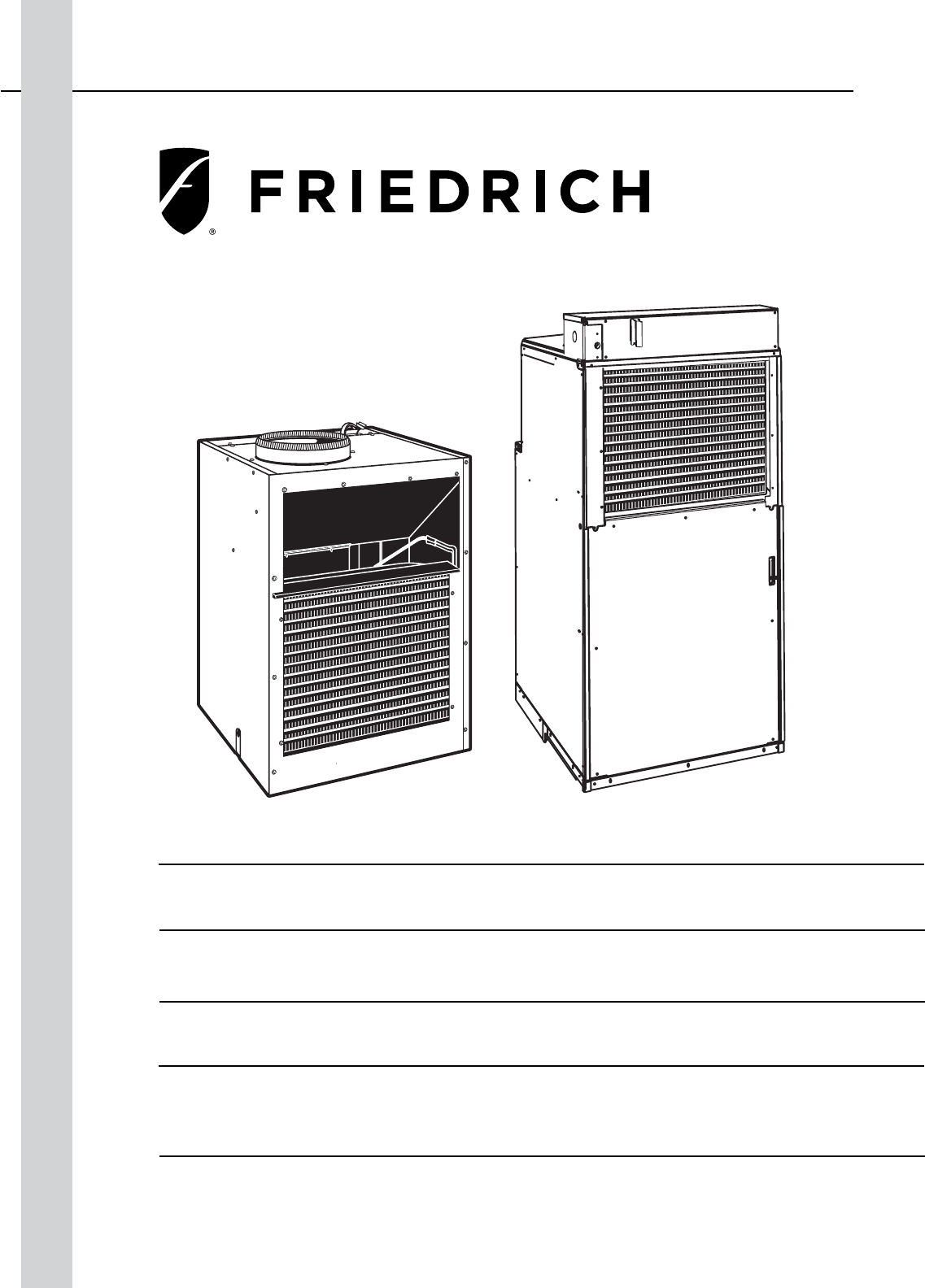
1 PB
Service Manual
VERT-I-PAK
Standard Chassis Models
9K
VHA - 09K25RTP, 09K34RTP, 09K50RTP
VHA - 09R25RTP, 09R34RTP, 09R50RTP
VHA - 18K25RTP, 18K34RTP, 18K50RTP, 18K75RTP
VHA - 18R25RTP, 18R34RTP, 18R50RTP, 18K75RTP
12K
18K
95992012_06
VHA - 12K25RTP, 12K34RTP, 12K50RTP
VHA - 12R25RTP, 12R34RTP, 12R50RTP
24K
VHA - 24K25RTP, 24K34RTP, 24K50RTP, 24K75RTP, 24K10RTP
VHA - 24R25RTP, 24R34RTP, 24R50RTP, 24R75RTP, 24R10RTP

2 PB
Table of Contents
INTRODUCTION 4
Important Safety Information 4
Personal Injury Or Death Hazards 5
Operation of Equipment in During Construction 7
Equipment Identification 8
Model and Serial Number Location 8
Model and Serial Number information is found on the Manufacturer’s DATA TAG, located on the front or top. 8
Model Number Reference Guide 9
Serial Number Reference Guide 10
SPECIFICATIONS 11
General Specifications -A Models 11
SPECIFICATIONS 12
General Specifications -B Models 12
Chassis Specifications 9K, 12K 13
18K Dimensions 14
24K Dimensions 15
Electrical Data (208/ 230v 9K btu and 12K BTU) 16
Electrical Data (265v 9K and 12K BTU) 17
Electrical Requirements 20
Electrical Ratings Table 20
Supply Air Flow and Data 22
OPERATION 24
Electronic Control Board Features 24
Electronic Sequence of Operation 25
Compressor Lock Out Time 26
Cooling Fan Delay 26
Heating Fan Delay 26
Fan Speed Change Delay 26
Room Air Sampling Feature 26
Low Voltage Interface Connections 26
Interface Connector Definitions 26
Remote Wall Thermostat 27
Remote Wall Thermostat Location 28
Desk Control 28
Auxiliary Fan Control 28
Unit Heat Control Operation - Heat Pump With Electric Heat 29
General Knowledge Sequence Of Refrigeration 30
REMOVE AND INSTALL THE CHASSIS 32
Remove The Chassis 32
Servicing / Chassis Quick Changeouts 32
To Remove the Chassis from the Closet: 32
EXTERNAL STATIC PRESSURE 33
Checking External Static Pressure 33
Explanation of charts 34
Indoor Airflow Data 34
Ductwork Preparation 34
Fresh Air Door 35
Checking Approximate Airflow 35
Electric Heat Strips 35
TROUBLESHOOTING 36
Error Codes and Alarm Status 36
Electrical Troubleshooting Chart - Cooling 38
9K Btu, 12K Btu, & 18K Btu 38
24K Btu 39
Electrical Troubleshooting Chart - Heat Pump 40
Troubleshooting Chart - Cooling 41
COMPONENT TESTING 42
Capillary Tube and Check Valve Assy (Heat Pump Units) 42
Capillary Tube Assy (Cool Only Units) 43
Reversing Valve Description And Operation 44

3 PB
Testing The Reversing Valve Solenoid Coil 45
Checking The Reversing Valve 46
Touch Test Chart : To Service Reversing Valves 47
Compressor Checks 48
Fan Motor 50
Capacitors 50
Heating Element and Limit Switch 51
Heater Elements And Limit Switches’ Specifications 51
Drain Pan Valve 53
Testing the Diagnostic Service Module 54
Testing the Electronic Control Board 54
Electronic Control Board Components Identification And Testing 55
24k Indoor Blower Motor 56
R-410A SEALED SYSTEM REPAIR 57
Refrigerant Charging 58
Undercharged Refrigerant Systems 59
An undercharged system will result in poor performance (low pressures, etc.) in both the heating and cooling cycle. 59
Overcharged Refrigerant Systems 60
Restricted Refrigerant System 61
Sealed System Method of Charging/ Repairs 62
Compressor Replacement -Special Procedure in Case of Compressor Burnout 64
WIRING DIAGRAMS 66
9-12K 208/230V 66
9-12K 265V 67
18K 208/230V (2.5KW, 3.5KW, 5KW) 68
18K 265V (2.5KW, 3.5KW, 5.0KW) 69
18K 208/230V (7.5KW) 70
18K 265V (7.5KW) 71
24K 208/230V (2.5KW, 3.5KW, 5KW) 72
24K 208/230V (7.5KW AND 10KW) 73
24K 265V (2.5KW, 3.5KW, 5KW) 74
24K 265V (7.5KW and 10KW) 75
INTERACTIVE PARTS VIEWER 76
AVAILABLE ACCESSORIES 77
APPENDIX 78
Appendix 1 Thermistor Resistence Values (This Table Applies to All Thermistors) 78
WARRANTY 79
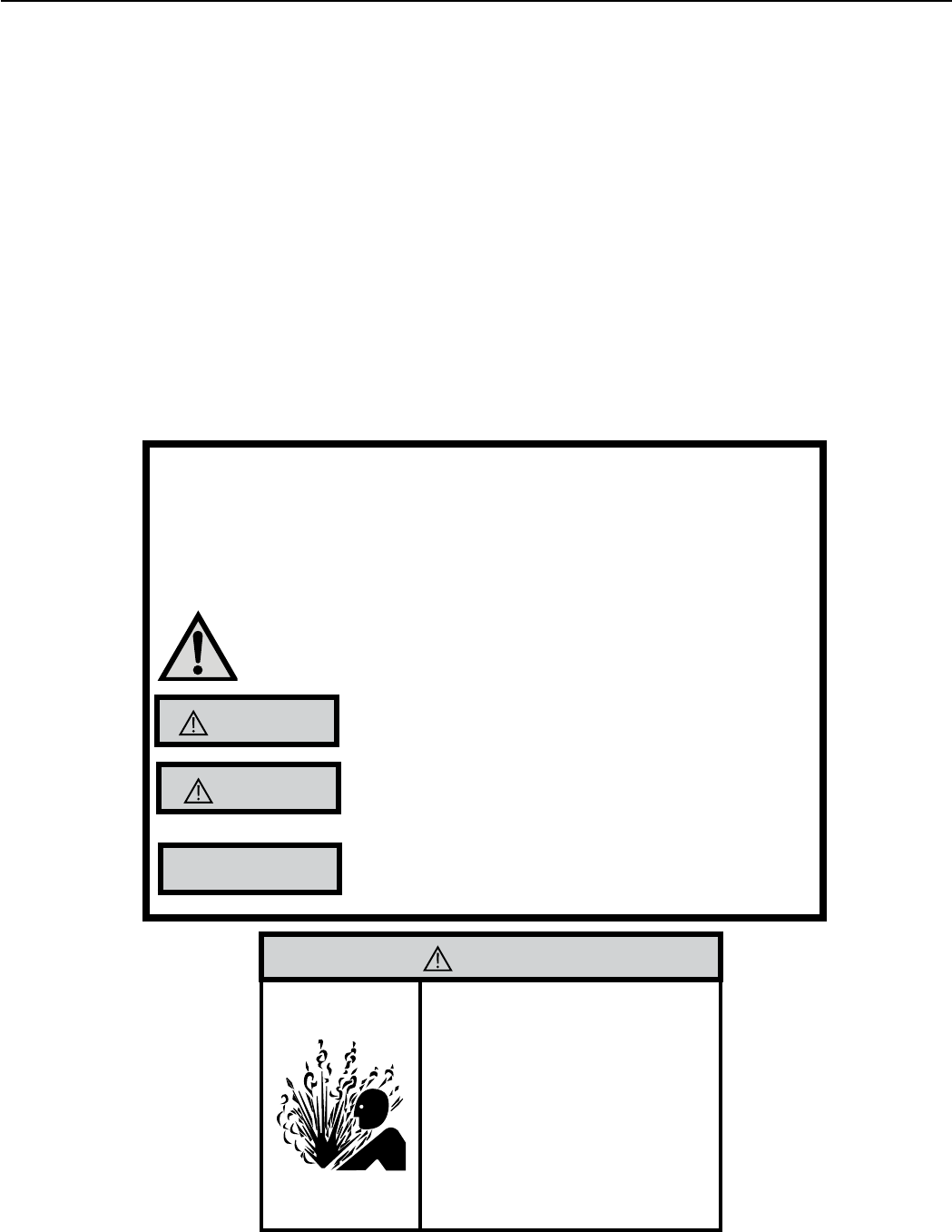
4 PB
Your safety and the safety of others is very
important.
We have provided many important safety messages in this manual and on your appliance. Always read
and obey all safety messages.
This is a safety Alert symbol.
This symbol alerts you to potential hazards that can kill or hurt you and others.
All safety messages will follow the safety alert symbol with the word
“WARNING”
or “CAUTION”. These words mean:
Indicates a hazard which, if not avoided, can result in severe personal
injury or death and damage to product or other property.
Indicates a hazard which, if not avoided, can result in personal injury and
damage to product or other property.
All safety messages will tell you what the potential hazard is, tell you
how to reduce the chance of injury, and tell you what will happen if the
instructions are not followed.
Indicates property damage can occur if instructions are not followed.
WARNING
Refrigeration system
under high pressure
Do not puncture, heat, expose to flame or
incinerate.
Only certified refrigeration technicians should
service this equipment.
R410A systems operate at higher pressures
than R22 equipment. Appropriate safe service
and handling practices must be used.
Only use gauge sets designed for use with
R410A.
Do not use standard R22 gauge sets.
NOTICE
CAUTION
WARNING
The information in this manual is intended for use by a qualied technician who is familiar with the safety procedures
required for installation and repair, and who is equipped with the proper tools and test instruments required to
service this product.
Due to continuing research in new energy-saving technology, all information in this manual is subject to change
without notice.
Installation or repairs made by unqualied persons can result in subjecting the unqualied person making such
repairs as well as the persons being served by the equipment to hazards resulting in injury or electrical shock
which can be serious or even fatal.
Safety warnings have been placed throughout this manual to alert you to potential hazards that may be encountered.
If you install or perform service on equipment, it is your responsibility to read and obey these warnings to guard
against any bodily injury or property damage which may result to you or others.
Important Safety Information
INTRODUCTION
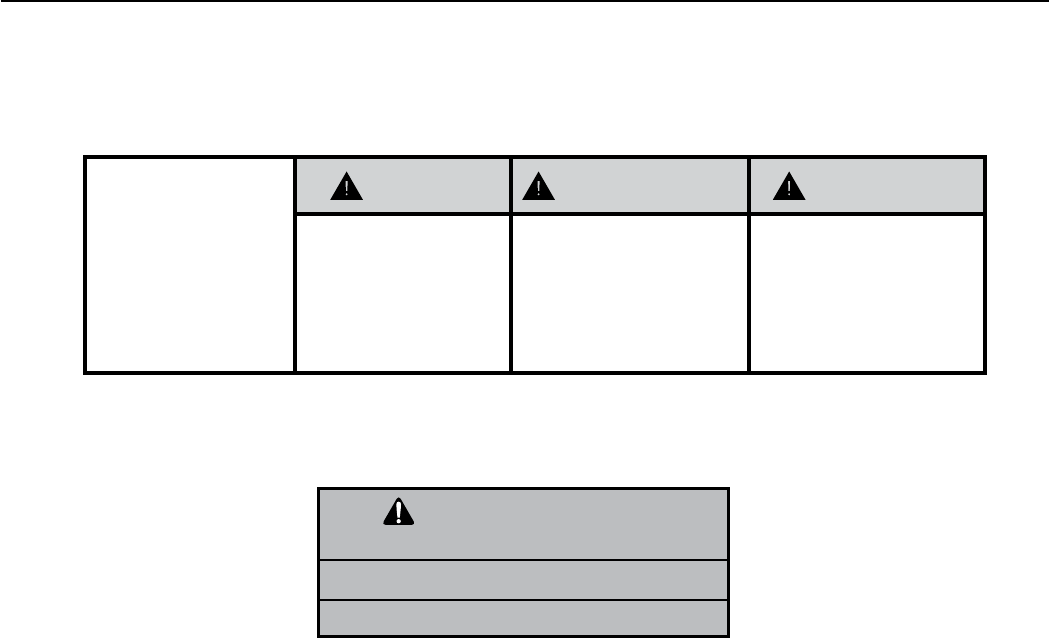
5 PB
SAFETY
FIRST
WARNING AVERTISSEMENT ADVERTENCIA
Do not remove, disable or
bypass this unit’s safety
devices. Doing so may
cause fire, injuries, or
death.
Ne pas supprime, désactiver
ou contourner cette l´unité
des dispositifs de sécurité,
faire vous risqueriez de
provoquer le feu, les
blessures ou la mort.
No eliminar, desactivar o
pasar por alto los dispositi-
vos de seguridad de la
unidad. Si lo hace podría
producirse fuego, lesiones o
muerte.
ELECTRICAL HAZARDS:
• Unplug and/or disconnect all electrical power to the unit before performing inspections, maintenance, or service.
• Make sure to follow proper lockout/tag out procedures.
• Always work in the company of a qualied assistant if possible.
• Capacitors, even when disconnected from the electrical power source, retain an electrical charge potential
capable of causing electric shock or electrocution.
• Handle, discharge, and test capacitors according to safe, established, standards, and approved procedures.
• Extreme care, proper judgment, and safety procedures must be exercised if it becomes necessary to test or
troubleshoot equipment with the power on to the unit.
• Do not spray water on the air conditioning unit while the power is on.
• Electrical component malfunction caused by water could result in electric shock or other electrically unsafe
conditions when the power is restored and the unit is turned on, even after the exterior is dry.
• Use air conditioner on a single dedicated circuit within the specied amperage rating.
• Follow all safety precautions and use proper and adequate protective safety aids such as: gloves, goggles,
clothing, properly insulated tools, and testing equipment etc.
• Failure to follow proper safety procedures and/or these warnings can result in serious injury or death.
INTRODUCTION
Personal Injury Or Death Hazards
WARNING
ALWAYS USE INDUSTRY STANDARD PERSONAL
PROTECTIVE EQUIPMENT (PPE)

6 PB
• REFRIGERATION SYSTEM REPAIR HAZARDS:
• Use approved standard refrigerant recovering procedures and equipment to relieve high pressure before
opening system for repair. Reference EPA regulations (40 CFR Part 82, Subpart F ) Section 608.
• Do not allow liquid refrigerant to contact skin. Direct contact with liquid refrigerant can result in minor to
moderate injury.
• Be extremely careful when using an oxy-acetylene torch. Direct contact with the torch’s ame or hot surfaces
can cause serious burns.
• Make certain to protect personal and surrounding property with re proof materials and have a re extinguisher
at hand while using a torch.
• Provide adequate ventilation to vent off toxic fumes, and work with a qualied assistant whenever possible.
• Always use a pressure regulator when using dry nitrogen to test the sealed refrigeration system for leaks,
ushing etc.
• MECHANICAL HAZARDS:
• Extreme care, proper judgment and all safety procedures must be followed when testing, troubleshooting,
handling, or working around unit with moving and/or rotating parts.
• Be careful when, handling and working around exposed edges and corners of the sleeve, chassis, and other unit
components especially the sharp ns of the indoor and outdoor coils.
• Use proper and adequate protective aids such as: gloves, clothing, safety glasses etc.
• Failure to follow proper safety procedures and/or these warnings can result in serious injury or death.
• PROPERTY DAMAGE HAZARDS
• FIRE DAMAGE HAZARDS:
• Read the Installation/Operation Manual for the air conditioning unit prior to operating.
• Use air conditioner on a single dedicated circuit within the specied amperage rating.
• Be extremely careful when using acetylene torch and protect surrounding property.
• Failure to follow these instructions can result in re and minor to serious property damage.
• WATER DAMAGE HAZARDS:
• Improper installation, maintenance or servicing of the air conditioner unit can result in water damage to personal
items or property.
• Insure that the unit has a sufcient pitch to the outside to allow water to drain from the unit.
• Do not drill holes in the bottom of the drain pan or the underside of the unit.
• Failure to follow these instructions can result in damage to the unit and/or minor to serious property damage.
INTRODUCTION
Personal Injury Or Death Hazards
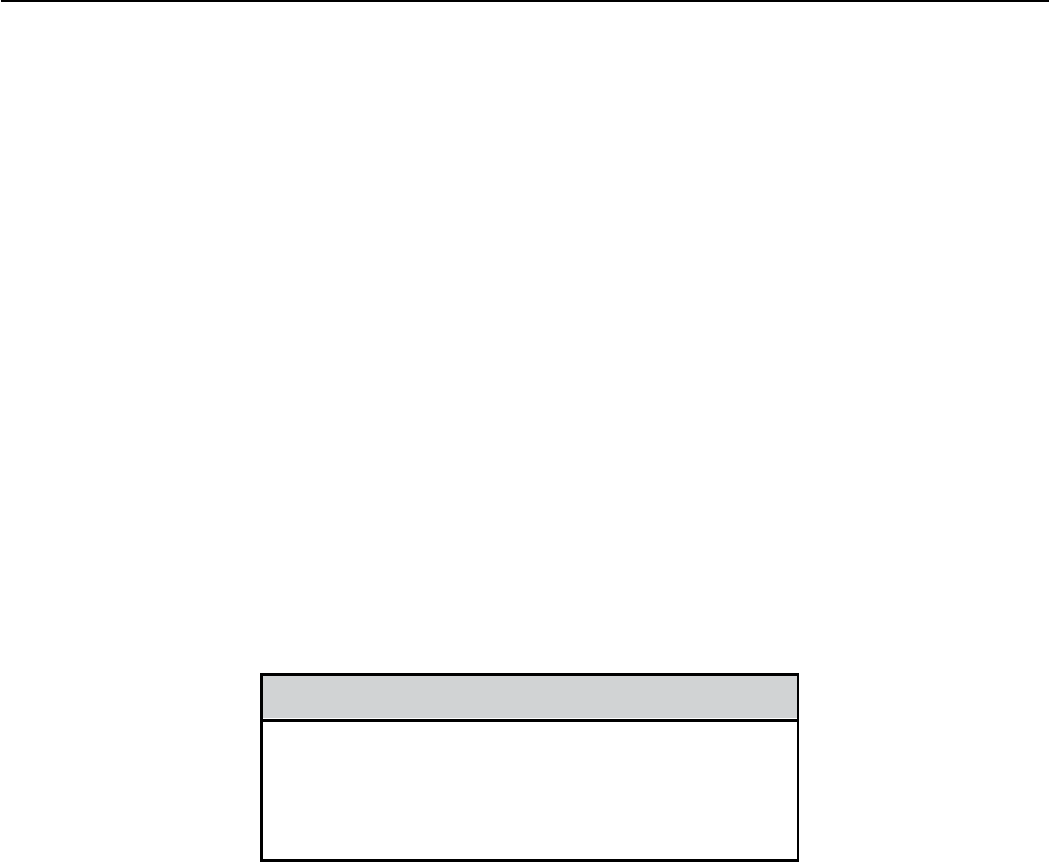
7 PB
INTRODUCTION
Operation of Equipment in During Construction
• OPERATION OF EQUIPMENT MUST BE AVOIDED DURING CONSTRUCTION PHASES WHICH
WILL PRODUCE AIRBORNE DUST OR CONTAMINTES NEAR OR AROUND AIR INTAKE
OPENINGS:
• Wood or metal framing;
• Drywalling or sheathing,
• Spackling or applying joint compound.
• Sanding or grinding.
• Moulding or trimwork.
• Concrete dust.
• Insulation .
• Spray foam.
• Stucco spray and mortar.
• Plastic sheathing.
NOTICE
Operating the equipment during any phase of
active construction noted above can void the
equipment’s warranty, and also lead to poor
performance and premature failure.
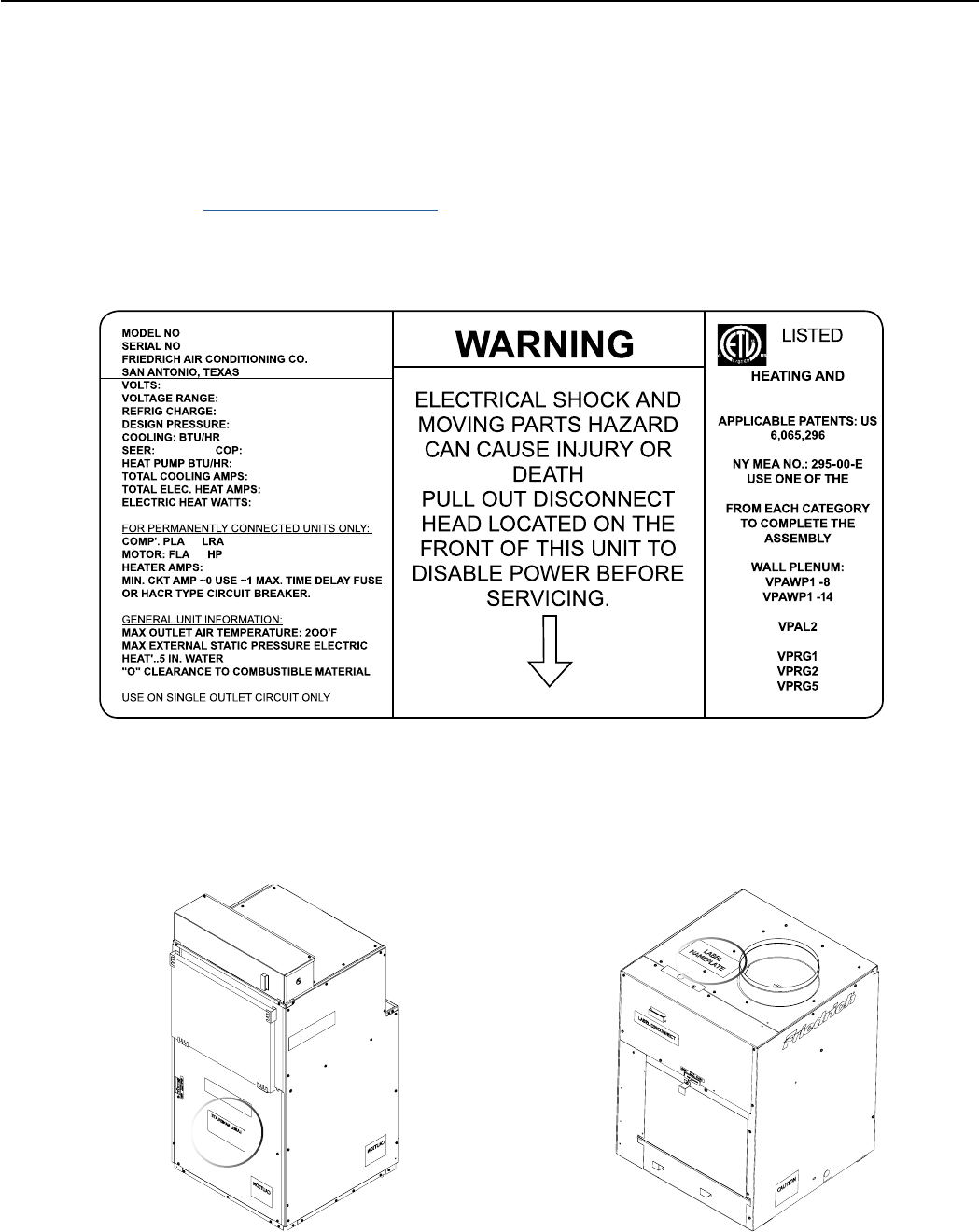
8 PB
INTRODUCTION
This service manual is designed to be used in conjunction with the installation and operation manuals provided
with each air conditioning system.
This service manual was written to assist the professional service technician to quickly and accurately diagnose
and repair malfunctions.
Installation procedures are not given in this manual. They are given in the Installation and Operation Manual which
can be aquired on the website (www.friedrich.com).
Model and Serial Number Location
Equipment Identication
Figure 101 (Equipment Identication Example)
Figure 102 (Model and Serial Number Location)
Model and Serial Number information is found on the Manufacturer’s DATA TAG, located on the front or top.
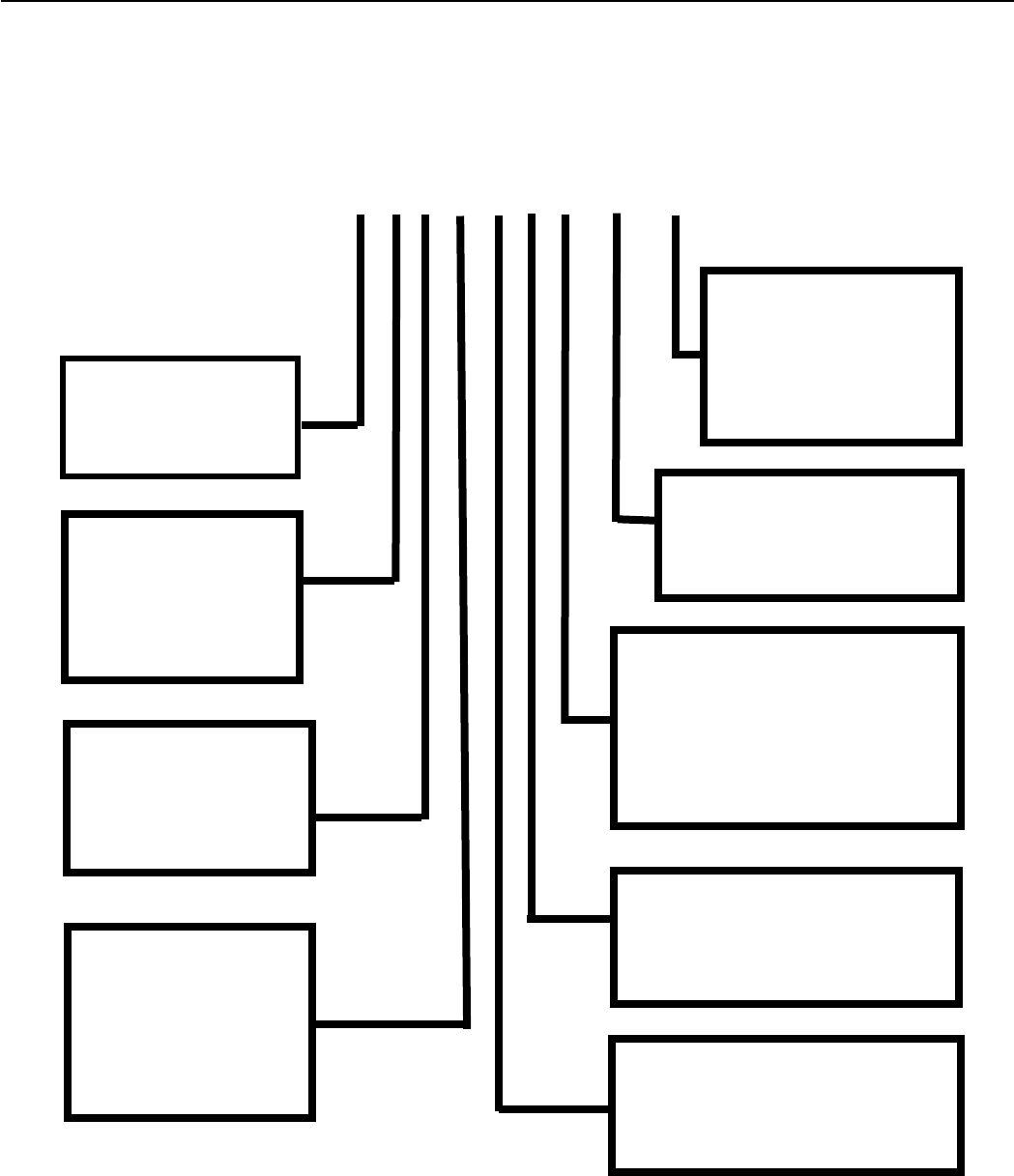
9 PB
INTRODUCTION
Model Number Reference Guide
SERIES
V=VERTICAL SERIES
FUNCTION
H - HEAT PUMP
DESIGN SERIES
A = 32”/47” CABINET
NOMINAL CAPACITY
A SERIES (Btu/h)
09= 9,000
12 = 12,000
18 = 18,000
24 = 24,000
ENGINEERING REVSION
LETTER INDICATES AN
ENGINEERING MODIFI-
CATION TO AN EXISTING
MODEL
MARKETING SUFFIX LETTER
INDICATES MODIFICATION TO
AN EXISTING MODEL SERIES
OPTIONS
RT = STANDARD REMOTE
OPERATION
ELECTRIC HEATER SIZE
A SERIES
25 = 2.5 KW 75 = 7.5KW
34 = 3.4 KW 10 = 10KW
50 = 5.0 KW
VOLTAGE
K = 208/230V - 1PH-60Hz
R = 265V
IMPORTANT: It will be necessary for you to accurately identify the unit you are servicing, so you can be certain of a
proper diagnosis and repair.
Figure 103
V H A 09 K 34 RT P - A
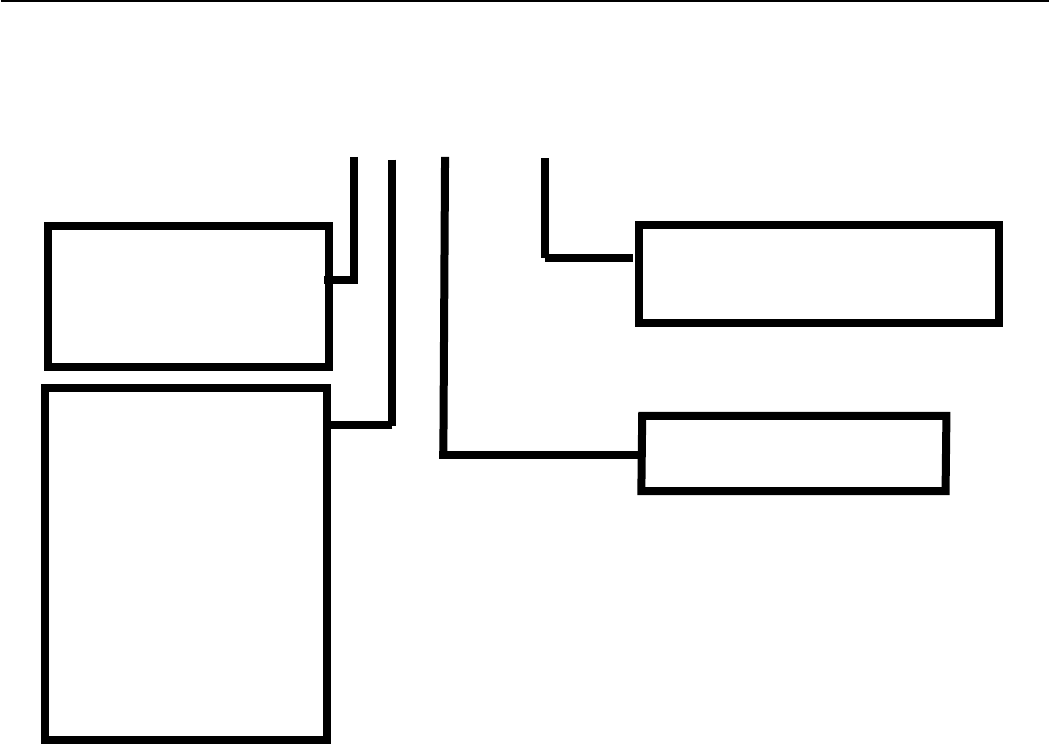
10 PB
INTRODUCTION
Serial Number Reference Guide
YEAR OF MANUFACTURE
17 = 2017 18 = 2018
19 = 2019 20 = 2020
21 = 2021 22 = 2022
MONTH OF MANUFACTURE
01 = JANUARY
02 = FEBRUARY
03 = MARCH
04 = APRIL
05 = MAY
06 = JUNE
07 = JULY
08 = AUGUST
09 = SEPTEMBER
10 = OCTOBER
11 = NOVEMBER
12 = DECEMBER
MANUFACTURING LOCATION
NUMERIC SEQUENCE
FIRST UNIT OF EACH MONTH = 00001
Figure 104
17 12 M 00001
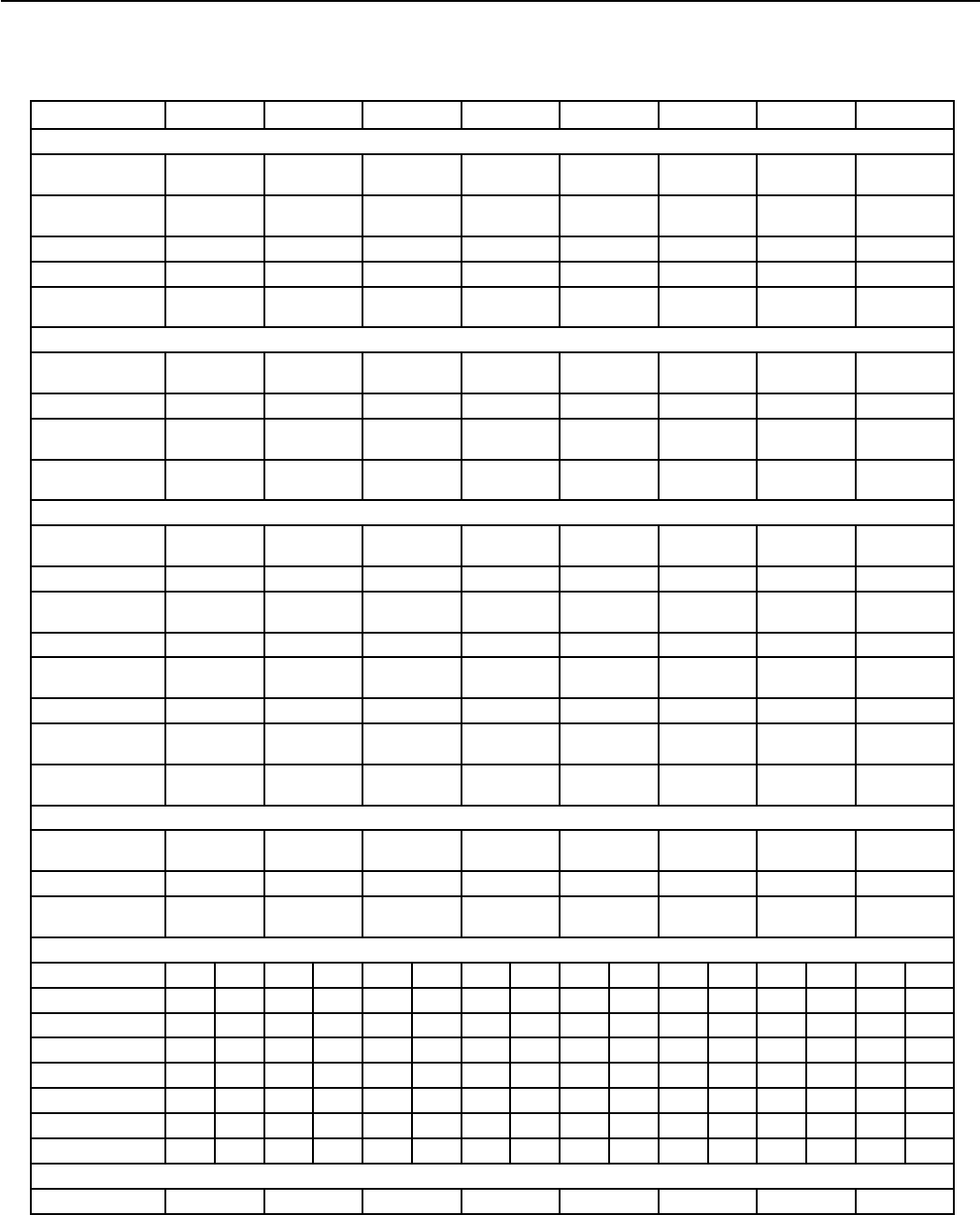
11 PB
SPECIFICATIONS
General Specications -A Models
MODEL VHA09K VHA09R VHA12K VHA12R VHA18K VHA18R VHA24K VHA24R
COOLING DATA
TOTAL COOLING
CAP.
9300 9300 11500 11500 18400 18400 22500 22500
SENSIBLE COOL
CAP.
7440 7440 9085 9085 13430 13430 15750 15750
POWER (W) 845 845 1045 1045 1670 1670 2045 2045
EER 11.0 11.0 11.0 11.0 11.0 11.0 11.0 11.0
HEATER SIZE (KW) 2.5/3.4/ 5.0 2.5/3.4/ 5.0 2.5/3.4/ 5.0 2.5/3.4/ 5.0 2.5/3.4/
5.0/7.5
2.5/3.4/
5.0/7.5
2.5/3.4/
5.0/7.5/ 10.0
2.5/3.4/
5.0/7.5/ 10.0
HEAT PUMP DATA
REVERSE HEATING
BTU
8300 8300 10600 10600 16700 16700 19500 19500
COP @ 47F 3.3 3.3 3.3 3.3 3.3 3.3 3.3 3.3
HEATING POWER
(W)
730 730 940 940 1480 1480 1732 1732
HEATING CURRENT
(A)
3.6 3.1 4.5 3.7 7.0 6.1 9.2 9.2
ELECTRICAL DATA
VOLTAGE (1 PHASE,
60 HZ)
208-230 265 208-230 265 208-230 265 208-230 265
VOLT RANGE 197-253 239-292 197-253 239-292 197-253 239-292 197-253 239-292
COOLING CUR-
RENT (A)
4.1 3.5 4.9 4.0 7.9 7.0 10.5 10.5
AMPS L.R 21.0 21.0 23.0 23.0 37.0 37.0 44.0 44.0
INDOOR MOTOR
(HP)
1/4 1/4 1/4 1/4 1/4 1/4 1/5 1/5
INDOOR MOTOR (A) 1.2 1.2 1.2 1.2 0.42 0.42 1.4 1.4
OUTDOOR MOTOR
(HP)
— — — — 1/4 1/4 1/4 1/4
OUTDOOR MOTOR
(A)
— — — — 1.6 1.6 1.7 1.7
PHYSICAL
DIMENSIONS
(W X D X H)
23” X23” X32” 23”X 23”X32” 23”X 23”X32” 23”X 23”X32” 23”X 23”X47” 23”X 23”X47” 23”X 23”X52” 23”X 23”X52”
NET WEIGHT (LBS) 142 144 147 149 190 192 225 227
R410A CHARGE
(OZ)
37.0 37.0 42.1 42.1 57 57 62 62
AIRFLOW DATA
INDOOR CFM LOW HIGH LOW HIGH LOW HIGH LOW HIGH LOW HIGH LOW HIGH LOW HIGH LOW HIGH
.10” ESP 430 490 430 490 430 490 430 490 630 675 630 675 660 700 660 700
.15” ESP 410 470 410 470 410 470 410 470 595 640 595 640 615 665 615 665
.20” ESP 360 440 360 440 360 440 360 440 550 600 550 600 575 625 575 625
.25” ESP 310 400 310 400 310 400 310 400 505 550 505 550 525 580 525 580
.30” ESP 260 350 260 350 260 350 260 350 455 500 455 500 485 540 485 540
.35" ESP - - - - - - - - 400 445 400 445 450 500 450 500
.40" ESP - - - - - - - - 345 400 345 400 415 465 415 465
VENT CFM
UP TO " " CFM 60 60 60 60 60 60 60 60
Figure 201a (General Specs - A Models)
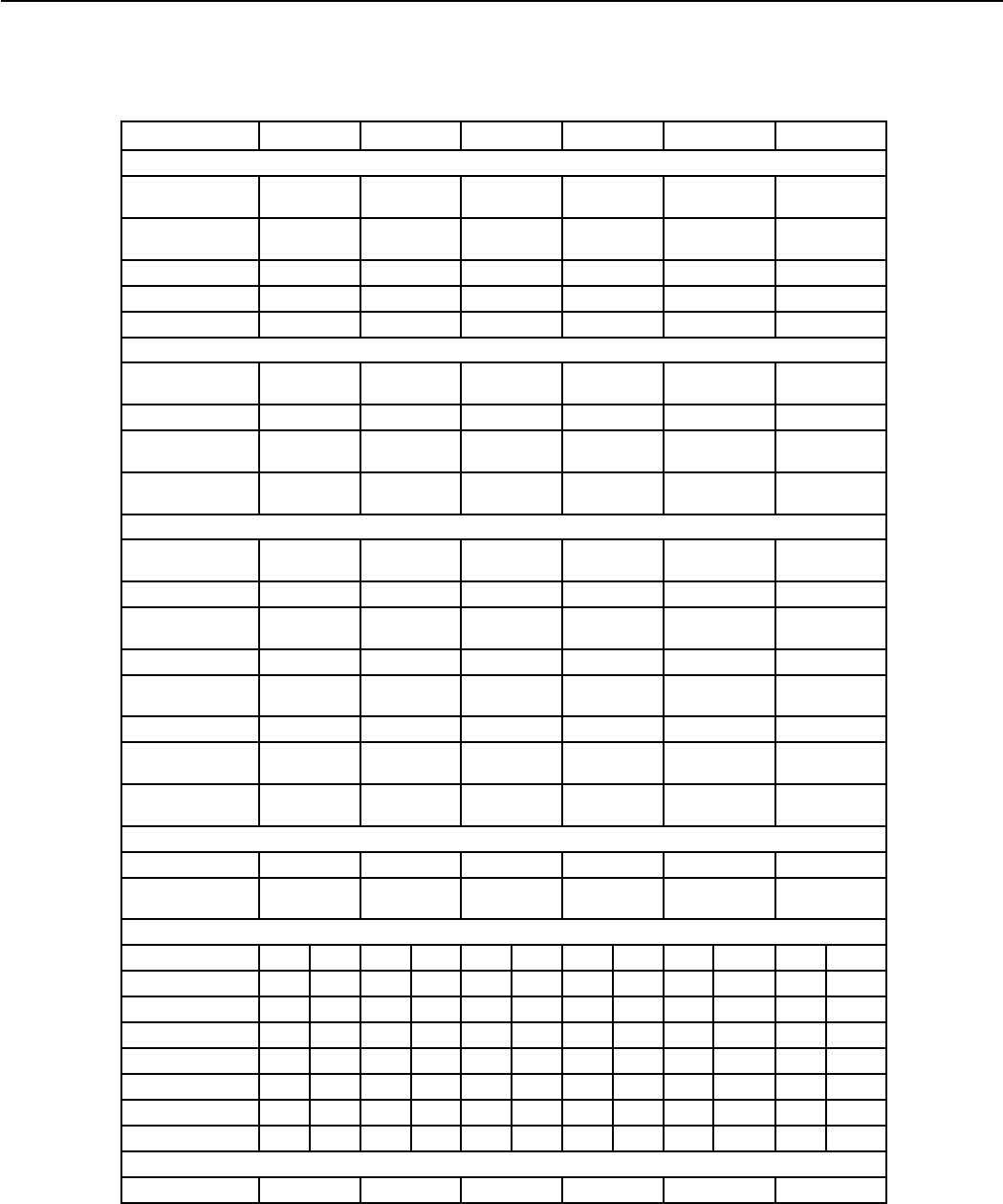
12 PB
SPECIFICATIONS
General Specications -B Models
Figure 201b (General Specs - B Models)
MODEL VHA09K VHA09R VHA12K VHA12R VHA18K VHA18R
COOLING DATA
TOTAL COOLING
CAP.
9300 9300 11500 11500 18400 18400
SENSIBLE COOL
CAP.
7440 7440 9085 9085 13430 13430
POWER (W) 845 845 1045 1045 1670 1670
EER 11.0 11.0 11.0 11.0 11.0 11.0
HEATER SIZE (KW) 2.5/3.4/5.0 2.5/3.4/5.0 2.5/3.4/5.0 2.5/3.4/5.0 2.5/3.4/5.0/7.5 2.5/3.4/5.0/7.5
HEAT PUMP DATA
REVERSE HEATING
BTU
8300 8300 10600 10600 16700 16700
COP @ 47F 3.3 3.3 3.3 3.3 3.3 3.3
HEATING POWER
(W)
730 730 940 940 1480 1480
HEATING CURRENT
(A)
3.6 3.1 4.5 3.7 7.0 6.1
ELECTRICAL DATA
VOLTAGE (1 PHASE,
60 HZ)
208-230 265 208-230 265 208-230 265
VOLT RANGE 197-253 239-292 197-253 239-292 197-253 239-292
COOLING CUR-
RENT (A)
4.1 3.5 4.9 4.0 7.9 7.0
AMPS L.R 21.0 21.0 23.0 23.0 37.0 37.0
INDOOR MOTOR
(HP)
1/4 1/4 1/4 1/4 1/4 1/4
INDOOR MOTOR (A) 1.2 1.2 1.2 1.2 0.42 0.42
OUTDOOR MOTOR
(HP)
— — — — 1/4 1/4
OUTDOOR MOTOR
(A)
— — — — 1.6 1.6
PHYSICAL
NET WEIGHT (LBS) 142 144 147 149 190 192
R410A CHARGE
(OZ)
38.0 38.0 42.1 42.1 58.5 58.5
AIRFLOW DATA
INDOOR CFM LOW HIGH LOW HIGH LOW HIGH LOW HIGH LOW HIGH LOW HIGH
.10” ESP 430 490 430 490 430 490 430 490 630 675 630 675
.15” ESP 410 470 410 470 410 470 410 470 595 640 595 640
.20” ESP 360 440 360 440 360 440 360 440 550 600 550 600
.25” ESP 310 400 310 400 310 400 310 400 505 550 505 550
.30” ESP 260 350 260 350 260 350 260 350 455 500 455 500
.35" ESP - - - - - - - - 400 445 400 445
.40" ESP - - - - - - - - 345 400 345 400
VENT CFM
UP TO " " CFM 60 60 60 60 60 60
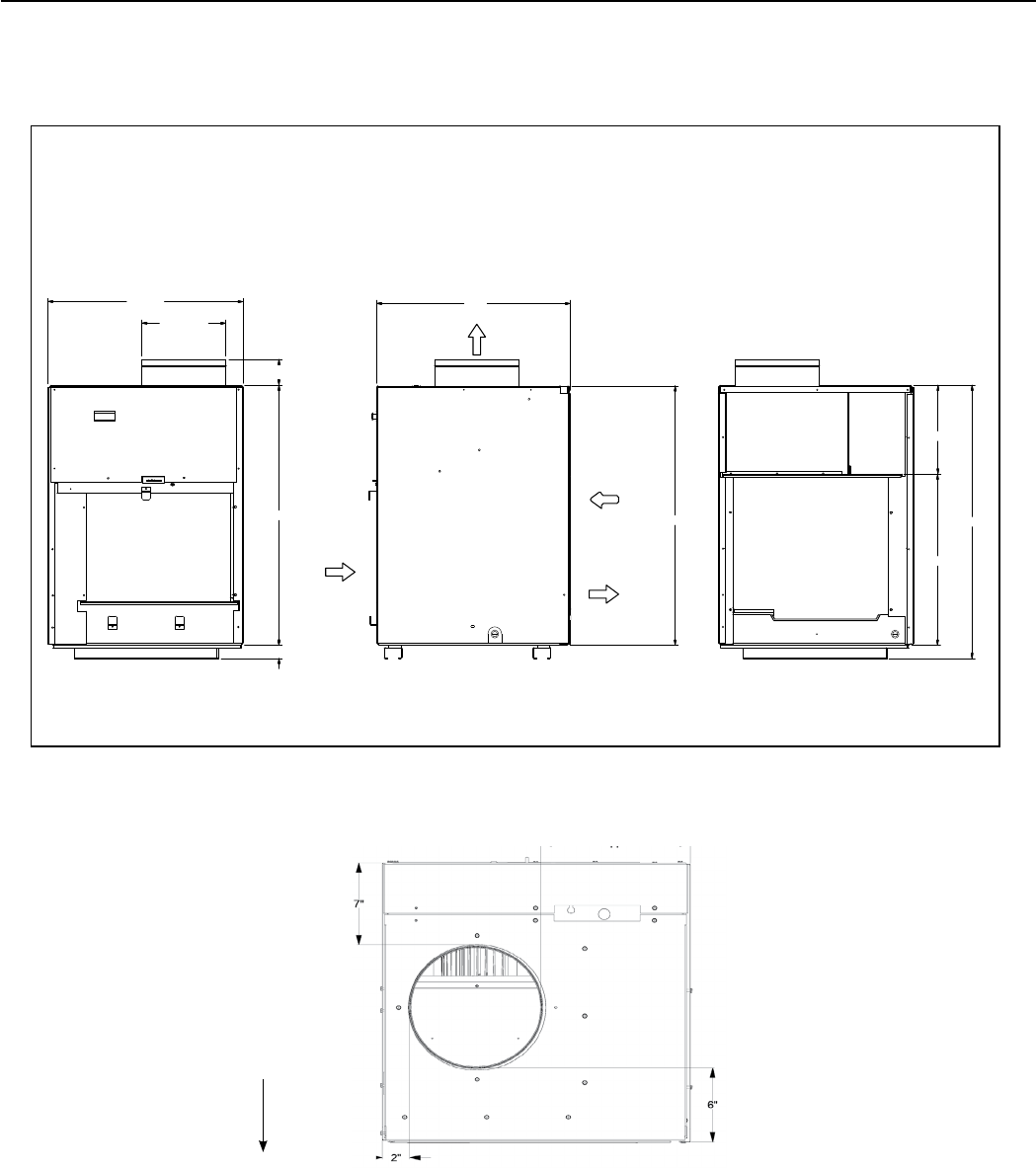
13 PB
SPECIFICATIONS
Chassis Specications 9K, 12K
D UC T
DIAMETER
SUPPLY
AIR
CONDEN SE R
INLET AIR
CONDENSER
AIR
EXHAUST
RETURN
AIR
SideFront Rear
23 1/8”
10”
2 15/16”
29 1/2”
29 1/2”
1 1/2”
23 1/8”
1/8” 10
1/2”
31”
19
UNIT TOP VIEW DIMENSIONS
O utside Wall
Figure 202 (9-12K Chassis Specs)
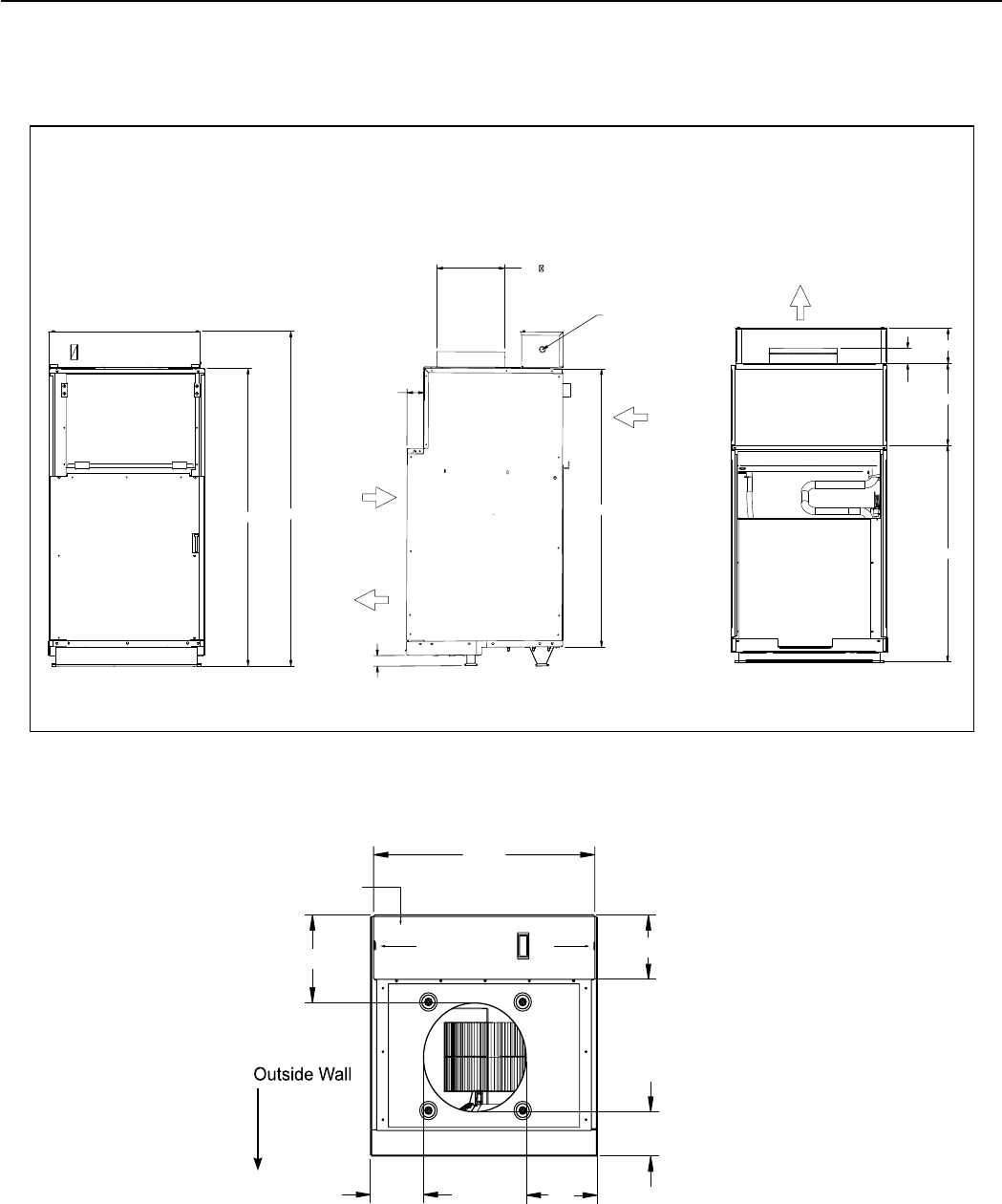
14 PB
SPECIFICATIONS
18K Dimensions
Figure 203 (18K Chassis Specs)
UNIT TOP VIEW DIMENSIONS
42 5/8
39 3/4
2 3/16
5 1/16
31
11 11/16
47 15/16
2 1/2
10
DUCT
DIAMETER
SUPPLY
AIR
AIR
RETURN
CONDENSER
INLET
AIR
ENTRY
ELECTRICAL
BOTH SIDES
CONDENSER
AIR
EXHAUST
FRONT
SIDE
REAR
1 1/2
electrical
entrance
control box
22
5
/
16
"
8
3
/
8
"
6
3
/
16
"
4
3
/
16
"
7
3
/
16
"
5
5
/
16
"
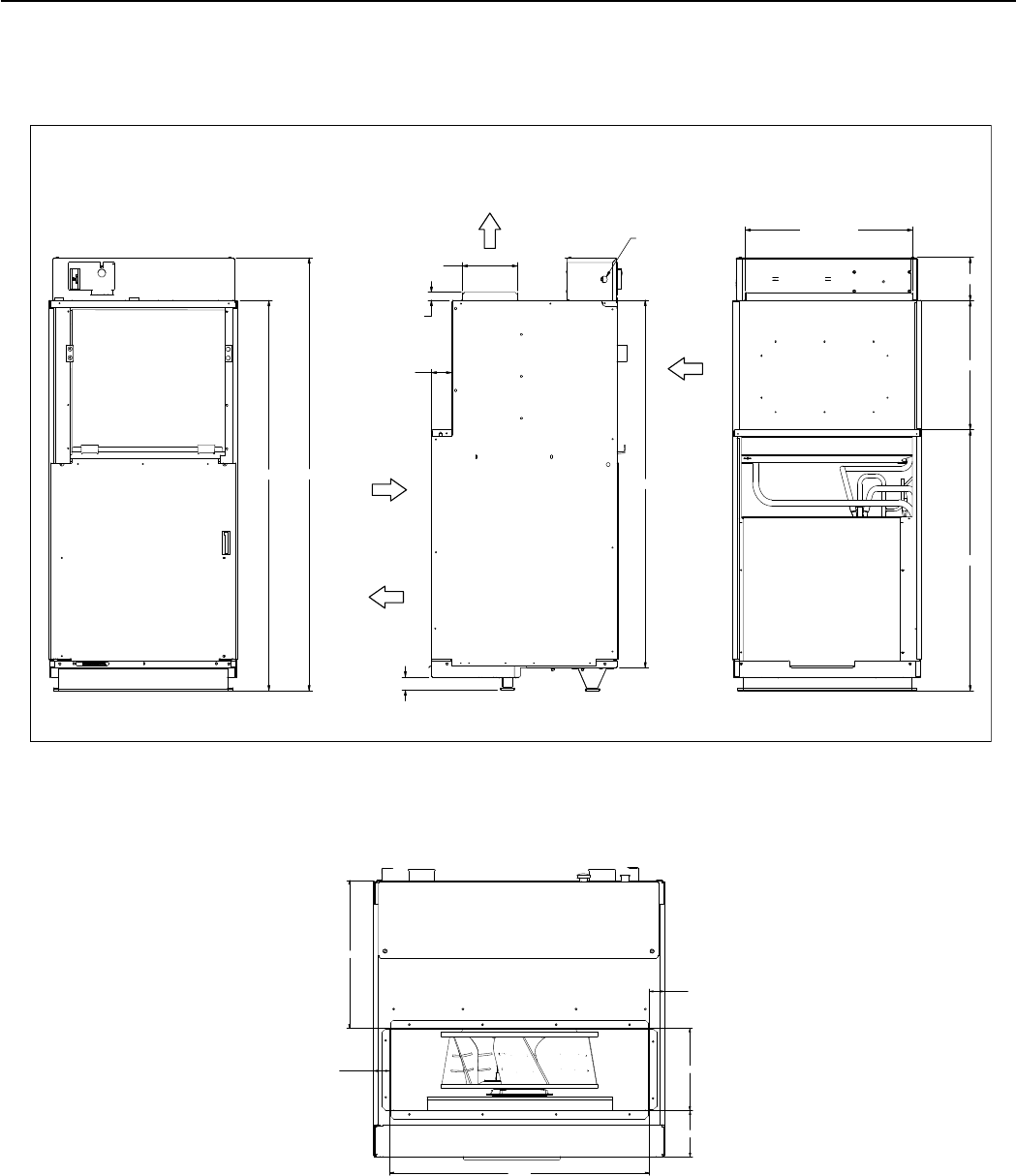
15 PB
SPECIFICATIONS
24K Dimensions
Figure 204 24K Chassis Specs)
UNIT TOP VIEW DIMENSIONS
46 23/32
51 7/8
1 1/2
44
2 1/2
CONDENSER
INLET
AIR
CONDENSER
AIR
EXHAUST
FRONT
SIDE
REAR
6 55/64 DUCT
1 DUCT
ENTRY
ELECTRICAL
BOTH SIDES
AIR
RETURN
15 7/16
31 9/32
5 5/32
20 5/8 DUCT
SUPPLY
AIR
3 55/64
1 1/2
12 19/64
1 1/2
6 55/64
20 5/8
Outside Wall
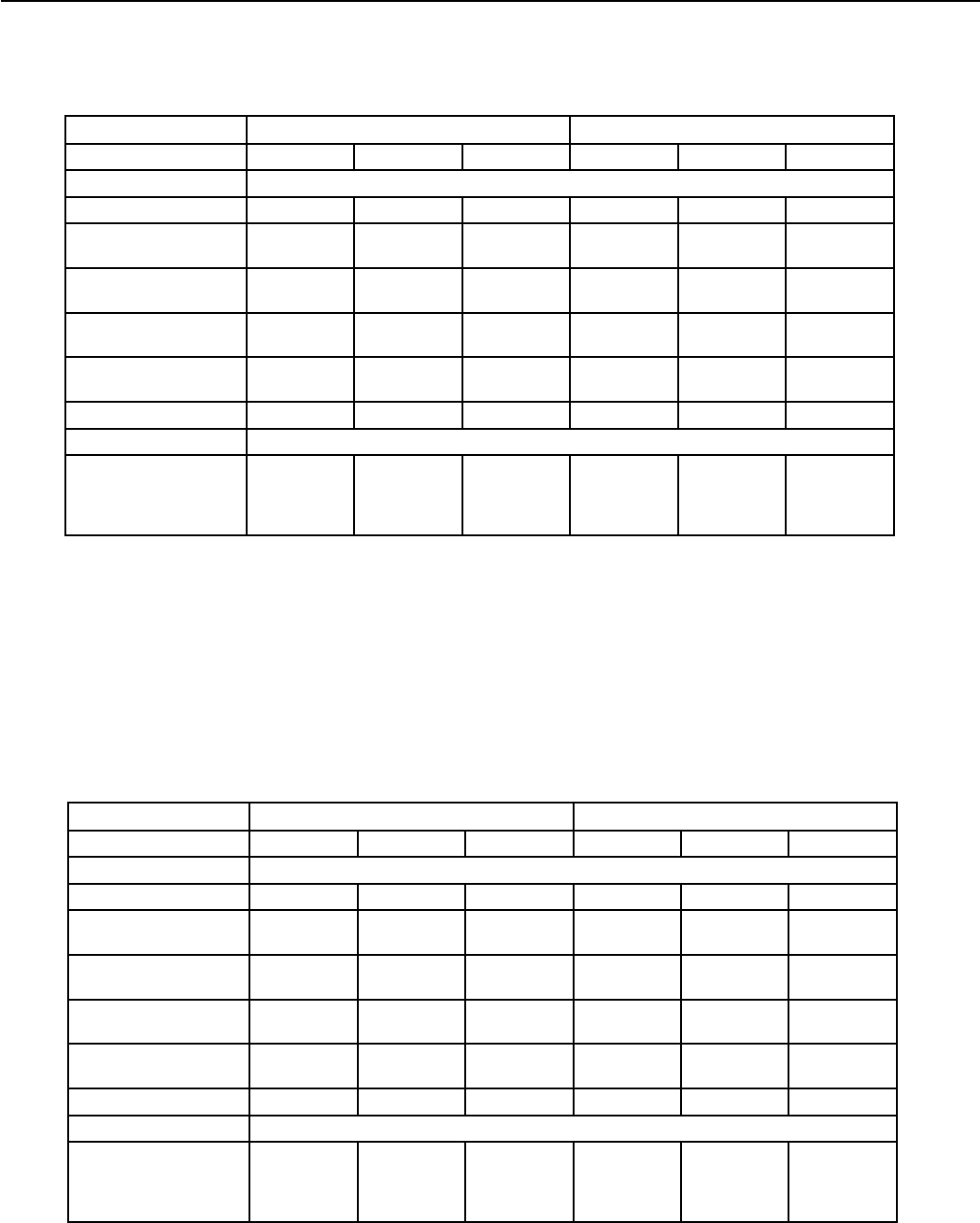
16 PB
SPECIFICATIONS
Electrical Data (208/ 230v 9K btu and 12K BTU)
MODEL 9K 12K
HEATER WATTS 2050-2500 2780-3400 4090-5000 2050-2500 2780-3400 4090-5000
VOLTAGE 208-230
ELECTRIC HEATING BTU 7000-8500 9500-11600 13900-17000 7000-8500 9500-11600 13900-17000
ELEC. HEATING CUR-
RENT (AMPS)
11.1-12.0 14.6-16.0 20.9-22.9 11.1-12.0 14.6-16.0 20.9-22.9
MINIMUM CIRCUIT
AMPACITY
15 20.0 29.2 15 20.0 29.2
BRANCH CIRCUIT FUSE
(AMPS)
15 20 30 15 20 30
LRA - COMPRESSOR
(AMPS)
21.0 21.0 21.0 23.0 23.0 23.0
BASIC HEATER SIZE 2.5 KW 3.4 KW 5.0 KW 2.5 KW 3.4 KW 5.0 KW
POWER CONNECTION HARD WIRED
RECOMMENDED
BRANCH CIRCUIT WIRE
SIZES* AWG-AMERI-
CAN WIRE GAUGE
14 12 10 12 12 10
Figure 205a (9&12K 208/230V Electrical Data) -A Models
MODEL 9K 12K
HEATER WATTS 2050-2500 2780-3400 4090-5000 2050-2500 2780-3400 4090-5000
VOLTAGE 208-230
ELECTRIC HEATING BTU 7000-8500 9500-11600 13900-17000 7000-8500 9500-11600 13900-17000
ELEC. HEATING CUR-
RENT (AMPS)
11.5-12.5 15.0-16.4 21.3-23.3 11.5-12.5 15.0-16.4 21.3-23.3
MINIMUM CIRCUIT
AMPACITY
16 20.9 29.6 16 20.9 29.6
BRANCH CIRCUIT FUSE
(AMPS)
20 25 30 20 25 30
LRA - COMPRESSOR
(AMPS)
21.0 21.0 21.0 23.0 23.0 23.0
BASIC HEATER SIZE 2.5 KW 3.4 KW 5.0 KW 2.5 KW 3.4 KW 5.0 KW
POWER CONNECTION HARD WIRED
RECOMMENDED
BRANCH CIRCUIT WIRE
SIZES* AWG-AMERI-
CAN WIRE GAUGE
12 12 10 12 12 10
Figure 205a (9&12K 208/230V Electrical Data) -B Models
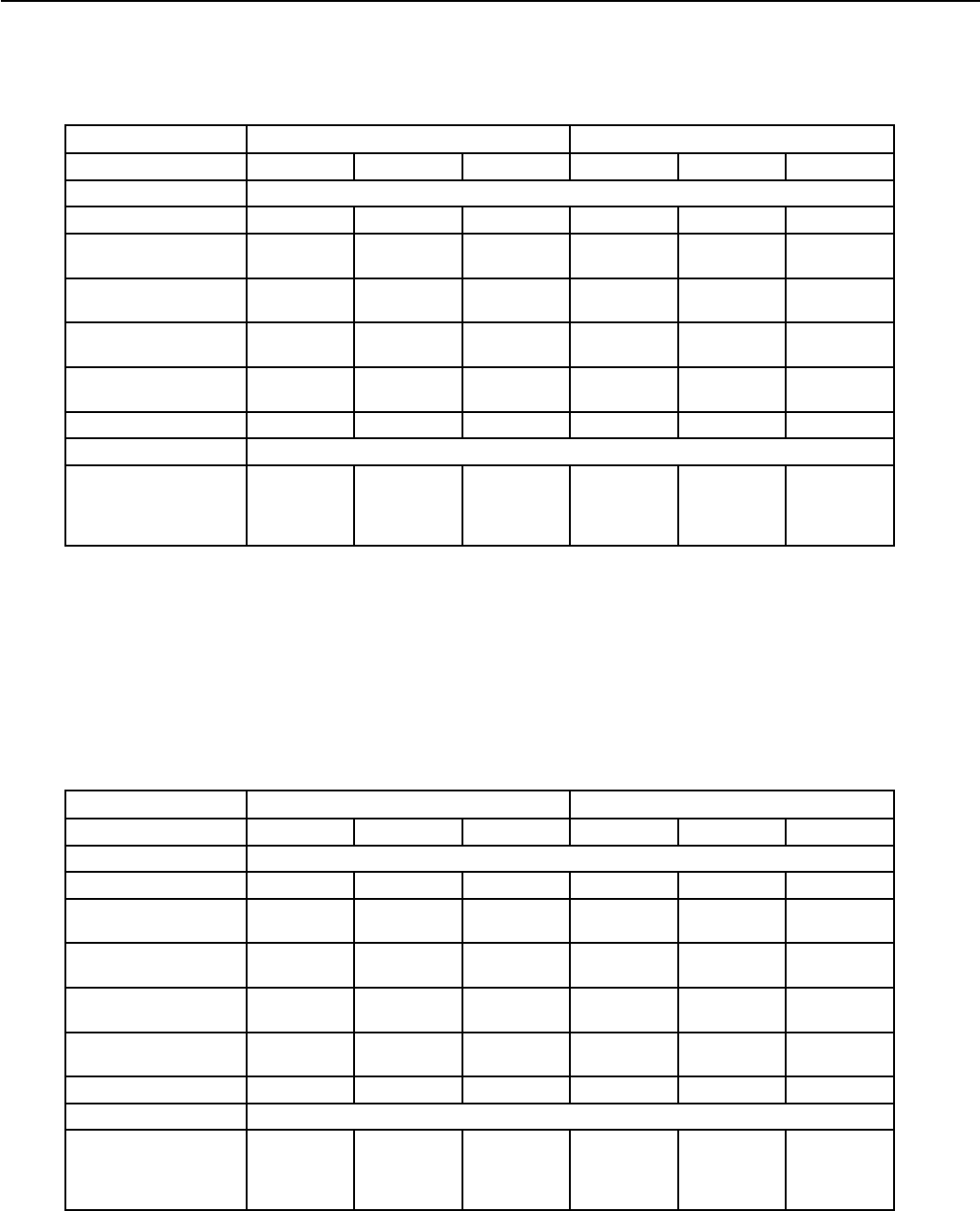
17 PB
MODEL 9R 12R
HEATER WATTS 2500 3400 5000 2500 3400 5000
VOLTAGE 265
ELECTRIC HEATING BTU 8500 11600 17000 8500 11600 7000
ELEC. HEATING CUR-
RENT (AMPS)
10.5 13.9 19.9 10.5 13.9 19.9
MINIMUM CIRCUIT
AMPACITY
13.8 18.0 25.7 13.8 18.0 25.7
BRANCH CIRCUIT FUSE
(AMPS)
15 20 30 15 20 30
LRA - COMPRESSOR
(AMPS)
21.0 21.0 21.0 23.0 23.0 23.0
BASIC HEATER SIZE 2.5 KW 3.4 KW 5.0 KW 2.5 KW 3.4 KW 5.0 KW
POWER CONNECTION HARD WIRED
RECOMMENDED
BRANCH CIRCUIT WIRE
SIZES* AWG-AMERI-
CAN WIRE GAUGE
14 12 10 12 12 10
Figure 206a (9K BTU&12K BTU 265 Electrical Data) -A Models
SPECIFICATIONS
Electrical Data (265v 9K and 12K BTU)
MODEL 9R 12R
HEATER WATTS 2500 3400 5000 2500 3400 5000
VOLTAGE 265
ELECTRIC HEATING BTU 8500 11600 17000 8500 11600 17000
ELEC. HEATING CUR-
RENT (AMPS)
11.0 14.4 20.5 11.0 14.4 20.5
MINIMUM CIRCUIT
AMPACITY
14.2 18.5 26.0 14.2 18.5 26.0
BRANCH CIRCUIT FUSE
(AMPS)
15 20 30 15 20 30
LRA - COMPRESSOR
(AMPS)
21.0 21.0 21.0 23.0 23.0 23.0
BASIC HEATER SIZE 2.5KW 3.4KW 5.0KW 2.5KW 3.4KW 5.0KW
POWER CONNECTION HARD WIRED
RECOMMENDED
BRANCH CIRCUIT WIRE
SIZES* AWG-AMERI-
CAN WIRE GAUGE
14 12 10 12 12 10
Figure 206b (9K BTU&12KBTU 265 Electrical Data) -B Models
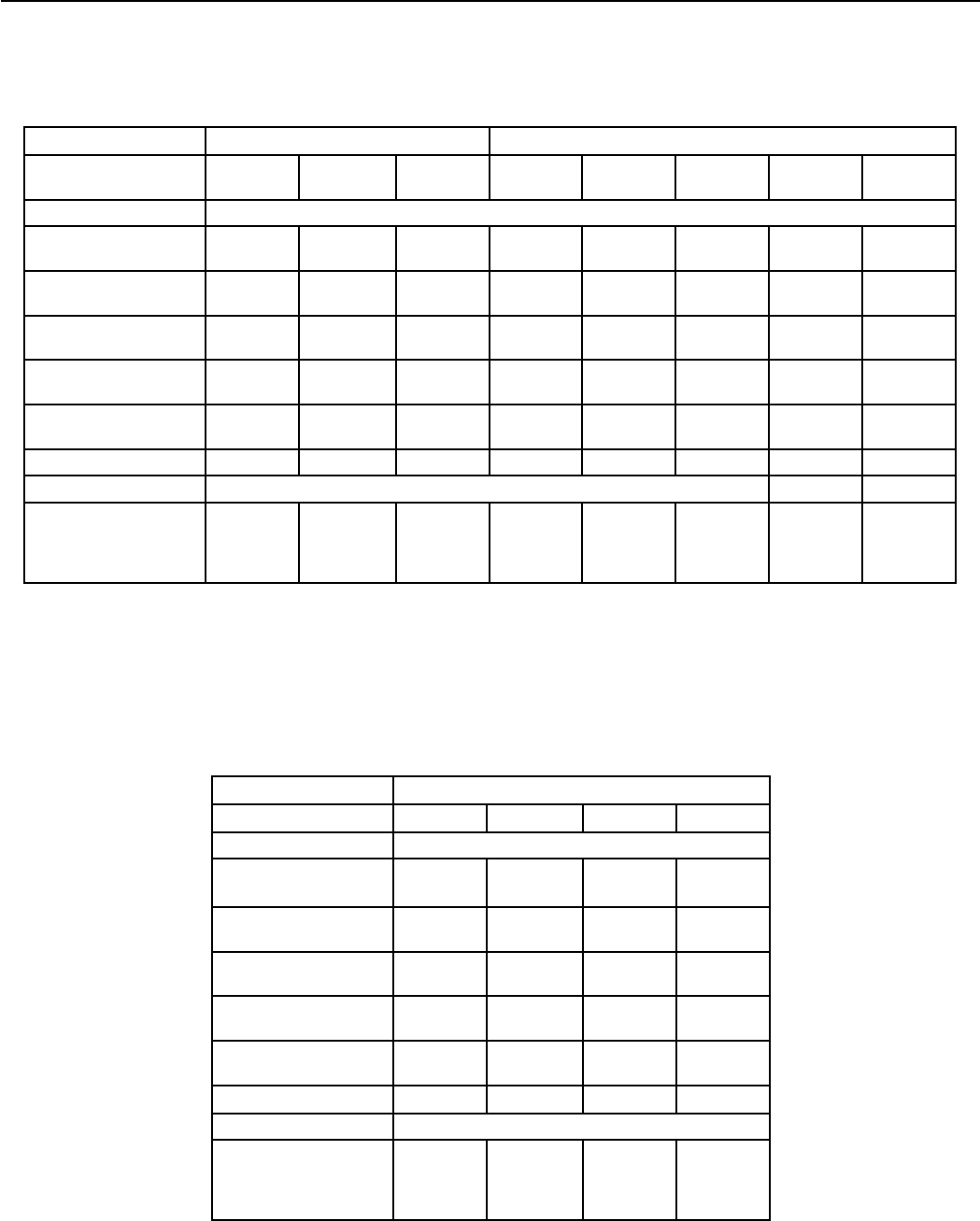
18 PB
SPECIFICATIONS
Electrical Data (208/ 230v 18K BTU and 24K BTU)
MODEL 18K 24K
HEATER WATTS 2050-2500 2780-3400 4090-5000 2050-2500 2780-3400 4090-5000 6135-7500 8180-
10000
VOLTAGE 208-230
ELECTIC HEATING BTU
7000-8500
9500-11600 13900-
17000
7000-8500
9500-11600 13900-
17000
20900-
25600
27900-
34100
ELEC. HEATING CUR-
RENT (AMPS)
11.1-12.0 14.6-16.0 20.9-22.9 11.3-12.3 14.8-16.2 21.1-23.1 30.9-34.0 40.7-44.9
MINIMUM CIRCUIT
AMPACITY
15.0 20.0 29.2 15.4 20.3 29.0 42.6 56.1
BRANCH CIRCUIT FUSE
(AMPS)
15 20 30 20 25 30 45 60
LRA - COMPRESSOR
(AMPS)
37.0 37.0 37.0 44.0 44.0 44.0 44.0 44.0
BASIC HEATER SIZE 2.5KW 3.4KW 5.0KW 2.5KW 3.4KW 5.0KW 7.5KW 10.0KW
POWER CONNECTION HARD WIRED
RECOMMENDED
BRANCH CIRCUIT WIRE
SIZES* AWG-AMERI-
CAN WIRE GAUGE
14 12 10 12 10 10 6 4
Figure 207a (18K BTU &24K BTU 208/230V Electrical Data)-A Models
MODEL 18K
HEATER WATTS 2050-2500 2780-3400 4090-5000
6135-7500
VOLTAGE 208-230
ELECTIC HEATING BTU
7000-8500
9500-11600 13900-
17000
20900-
25600
ELEC. HEATING CUR-
RENT (AMPS)
11.5-12.5 15.0-16.4 21.3-23.3
31.1-34.2
MINIMUM CIRCUIT
AMPACITY
15.6 20.5 29.2
42.8
BRANCH CIRCUIT FUSE
(AMPS)
20 25 30
45
LRA - COMPRESSOR
(AMPS)
37.0 37.0 37.0
37.0
BASIC HEATER SIZE 2.5KW 3.4KW 5.0KW
7.5KW
POWER CONNECTION HARD WIRED
RECOMMENDED
BRANCH CIRCUIT WIRE
SIZES* AWG-AMERI-
CAN WIRE GAUGE
12 12 10
6
Figure 207b (18K BTU 208/230V Electrical Data)-B Models
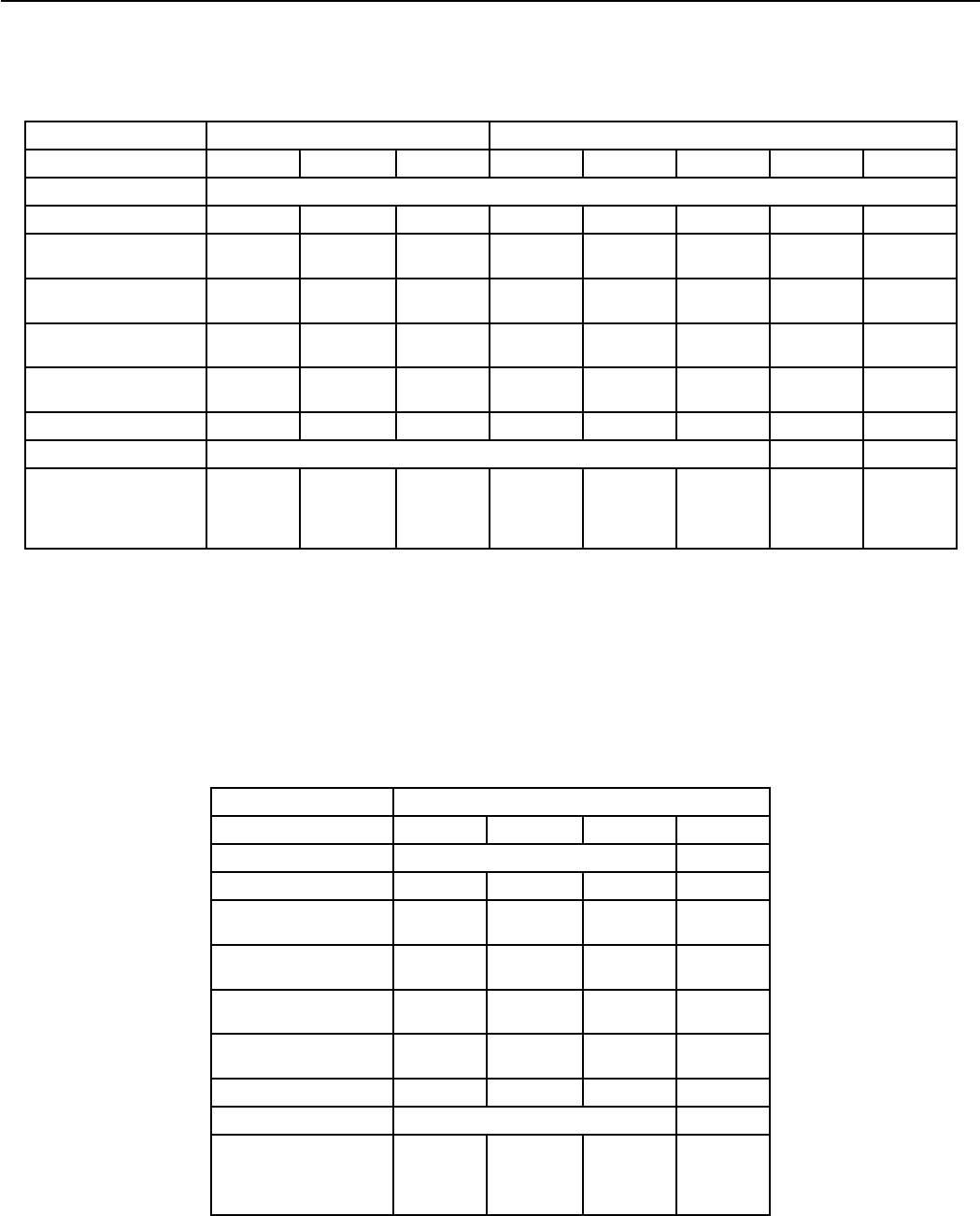
19 PB
MODEL 18R 24R
HEATER WATTS 2500
3400 5000 2500 3400 5000 7500 10000
VOLTAGE
265
ELECTIC HEATING BTU
8500 11600 17000 8500 11600 17000 25600 34100
ELEC. HEATING CUR-
RENT (AMPS)
10.5 13.9 19.9 10.8 14.2 20.3 29.7 39.1
MINIMUM CIRCUIT
AMPACITY
13.8 18.0 25.7 13.6 17.8 25.4 37.2 49.0
BRANCH CIRCUIT FUSE
(AMPS)
15 20 30 20 20 30 40 50
LRA - COMPRESSOR
(AMPS)
37.0 37.0 37.0 44.0 44.0 44.0 44.0 44.0
BASIC HEATER SIZE
2.5KW 3.4KW 5.0KW 2.5KW 3.4KW 5.0KW 7.5KW 10.0KW
POWER CONNECTION
HARD WIRED
RECOMMENDED
BRANCH CIRCUIT WIRE
SIZES* AWG-AMERI-
CAN WIRE GAUGE
14 12 10 12 12 10 6 4
SPECIFICATIONS
Electrical Data (265v 18K BTU and 24K BTU)
Figure 208a (18K BTU &24K BTU 265V Electrical Data)-A Models
MODEL 18R
HEATER WATTS 2500
3400 5000 7500
VOLTAGE
265
ELECTIC HEATING BTU
8500 11600 17000 25600
ELEC. HEATING CUR-
RENT (AMPS)
11.0 14.4 20.5 29.9
MINIMUM CIRCUIT
AMPACITY
13.8 18.1 25.6 37.4
BRANCH CIRCUIT FUSE
(AMPS)
15 20 30 40
LRA - COMPRESSOR
(AMPS)
37.0 37.0 37.0 37.0
BASIC HEATER SIZE
2.5KW 3.4KW 5.0KW 7.5KW
POWER CONNECTION
HARD WIRED
RECOMMENDED
BRANCH CIRCUIT WIRE
SIZES* AWG-AMERI-
CAN WIRE GAUGE
14 12 10 6
Figure 208b (18K BTU &24K BTU 265V Electrical Data)-B Models
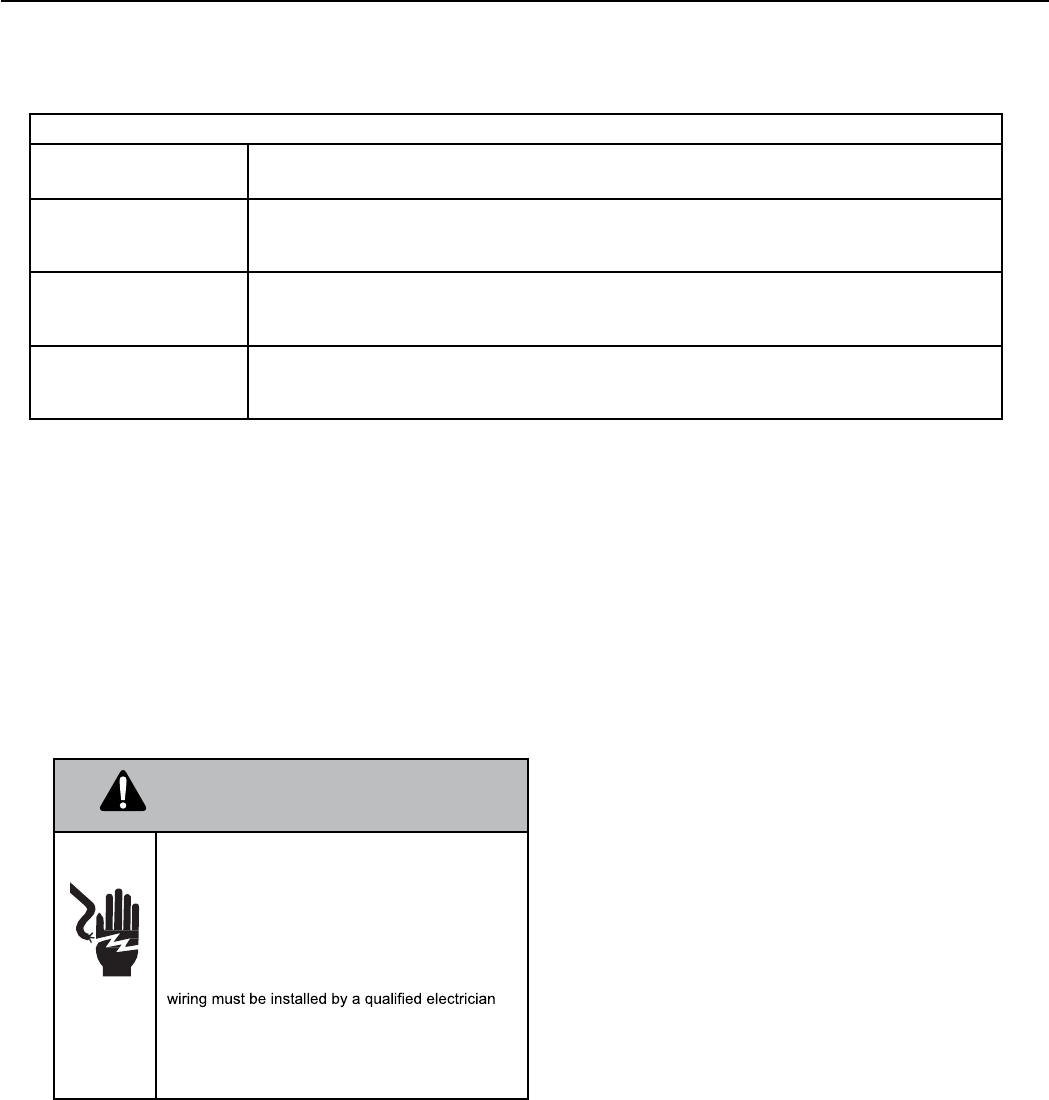
20 PB
SPECIFICATIONS
Electrical Requirements
ELECTRICAL REQUIREMENTS
WIRE SIZE
Use ONLY wiring size recommended by Local and/ or National electric codes for
single outlet branch circuit.
FUSE/CIRCUIT BREAK-
ER
USE ONLY TYPE AND SIZE FUSE OR HACR CIRCUIT BREAKER INDICATED ON UNIT’S
RATING GUIDE. PROPER OVER CURRENT PROTECTION TO THE UNITS IS THE RESPON-
SIBILITY OF THE OWNER.
GROUNDING UNIT MUST BE GROUNDED FROM BRANCH CIRCUIT TO UNIT, OR THROUGH SEPARATE
GROUND WIRE PROVIDED ON PERMANENTLY CONNECTED UNITS. ENSURE THAT
BRANCH CIRCUIT OR GENERAL PUR- POSE OUTLET IS GROUNDED.
WIRE SIZING USE RECOMMENDED WIRE SIZE GIVEN IN TABLES AND INSTALL A SINGLE BRANCH
CIRCUIT. ALL WIRING MUST COMPLY WITH LOCAL AND NATIONAL CODES. NOTE: USE
COPPER CONDUCTORS ONLY.
Electrical Ratings Table
NOTE: Use copper conductors ONLY. Wire sizes are per NEC.
AWG - American Wire Gauge
* Single circuit from main box.
** Based on 100’ or less of copper, single insulated conductor at 60˚ C
WARNING
Electrical Shock Hazard.
Turn OFF electric power before service or instal-
lation.
Unit must be properly grounded.
Unit must have correct fuse or circuit breaker pro-
tection. Unit’s supply circuit must have the correct
wire conductor size. All electrical connections and
and conform to the National Electrical Code and all
local codes which have jurisdiction. Failure to do so
can result in property
damage, personal injury and/or death.
NOTE: ALL 230/208 CHASSIS MUST BE HARD WIRED WITH A PROPERLY SIZED BREAKER. SEE UNIT NAMEPLATE
FOR SPECIFIC ELECTRICAL REQUIREMENTS.
USE HACR TYPE BREAKERS TO AVOID NUISANCE TRIPS. ALL FIELD WIRING MUST BE DONE IN ACCORDANCE
WITH NEC AND LOCAL CODES. IT IS THE INSTALLER’S
RESPONSIBILITY TO ENSURE THAT THE ELECTRICAL CODES ARE MET.

21 PB
SPECIFICATIONS
Sound Data
Figure 209 (Sound Data)
Sound Power and STC
MODEL INDOOR (DBA) OUTDOOR (DBA)
STC HIGH COOL LOW COOL HIGH COOL LOW COOL
VHA09 23 63.6 61.4 75.4 72.9
VHA12 23 63.0 60.8 75.3 72.7
VHA18 24 67.2 65.7 74.9 74.8
VHA24 25 67.8 66.4 78.5 72.7
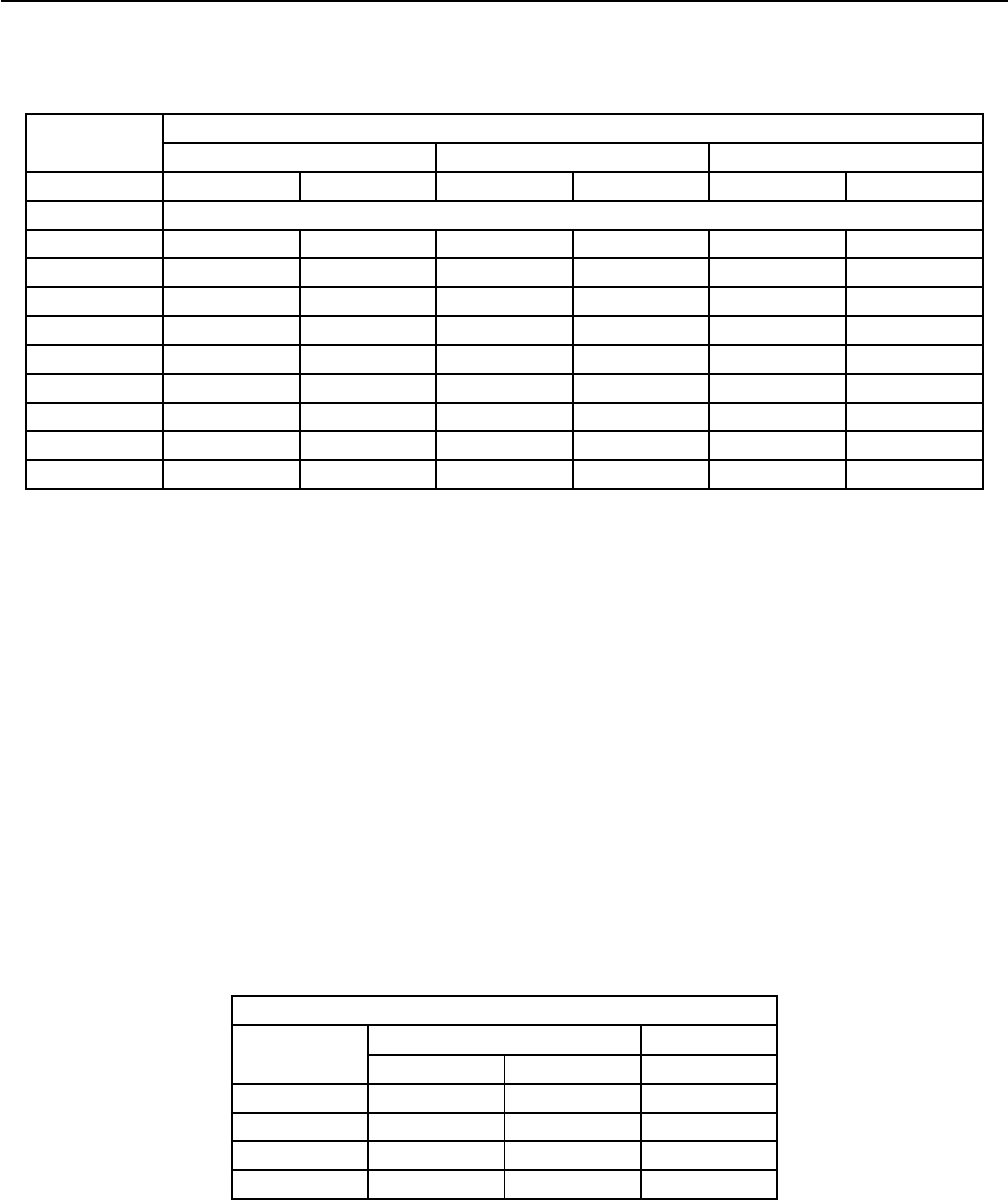
22 PB
SPECIFICATIONS
Supply Air Flow and Data
MODEL
VHA 09/12 VHA 18 VHA 24
FAN SPEED LOW HIGH LOW HIGH LOW HIGH
ESP (“) CFM
0.0” 470 520 730 800 755 805
0.05” 460 510 670 735 700 750
0.10” 430 490 630 675 660 700
0.15” 410 470 595 640 615 665
0.20” 360 440 550 600 575 625
0.25” 310 400 505 550 525 580
0.30” 260 350 455 500 485 540
0.35” -- -- 400 445 450 500
0.40” -- -- 345 400 415 465
Condenser External Static Pressure
Model Design Maximum
CFM ESP ("WC) ESP ("WC)
VHA09 650 0.03 0.12
VHA12 650 0.03 0.12
VHA18 950 0.03 0.12
VHA24 980 0.03 0.12
Indoor air ow may be determined by measuring the external static pressure (ESP) of the duct system using an inclined
manometer or magnahelic gauge and consulting the above chart to derive actual air ow. Under no circumstances
should the large chassis Vert-I-Pak equipment be operated at an external static pressure in excess of 0.4” W.C. Operation
of the Vert-I-Pak under these conditions will result in inadequate air ow, leading to poor performance and/or
premature component failure.
Control
For LOW speed only operation, connect the fan output terminal from the thermostat to the GL terminal of the electronic
control.
For HIGH speed only operation, connect the fan output terminal from the thermostat to the GH terminal of the electronic
control.
For thermostats with two-speed capability, connect the LOW speed output to the GL terminal and the HIGH speed output
to the GH terminal.
Condenser CFM & External Static Pressure
VPAK is designed to install through an exterior wall with a plenum (VPAWP-8, VPAWP-14) and a external louver .
NOTE: If the designed plenum and louver combinations are not used, the selections and design must be evaluated by to en-
sure the total pressure drop does not exceed the maximum allowable limits.
Figure 210 (Indoor CFM & External Static Pressure)
Figure 211 (Condenser CFM & External Static Pressure)
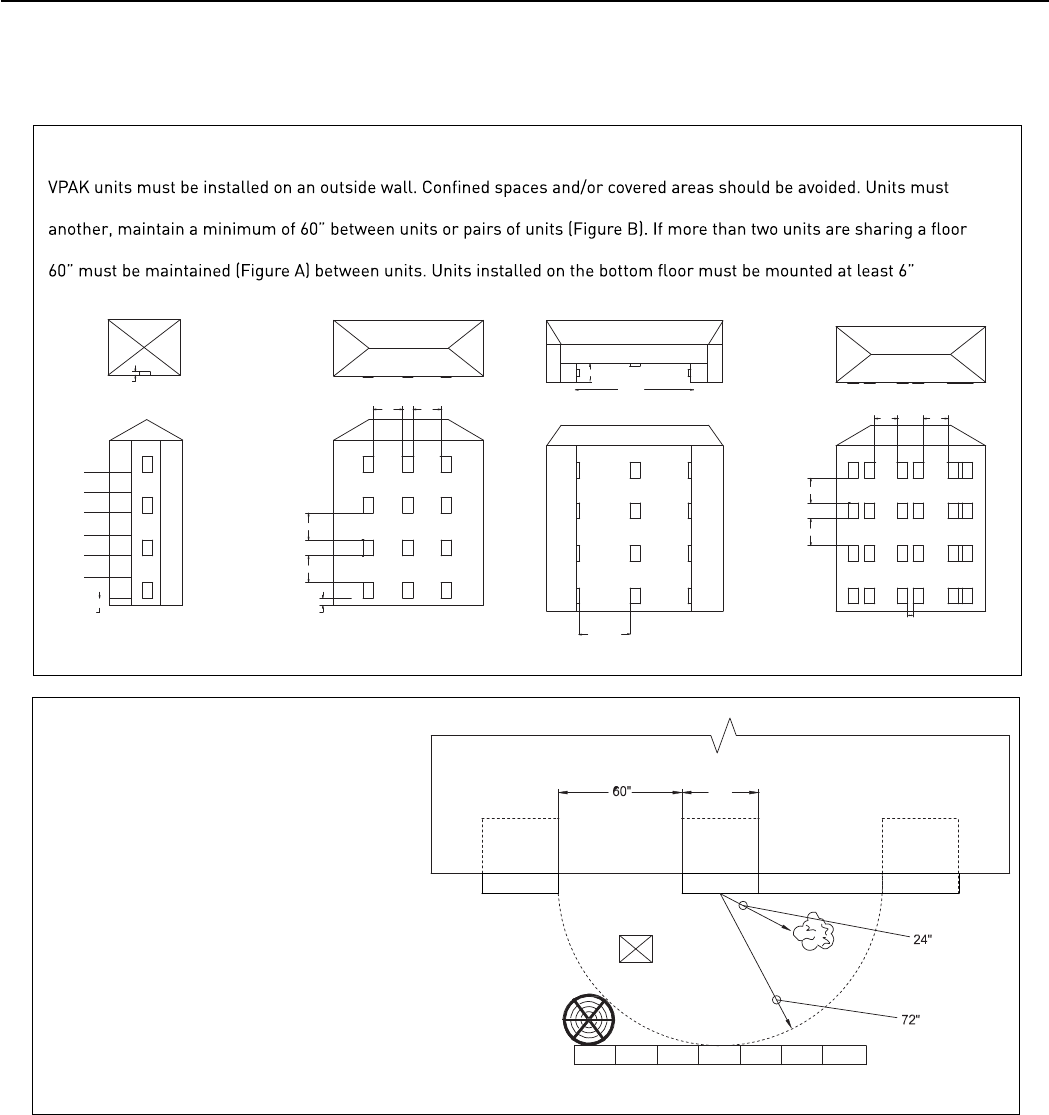
23 PB
SPECIFICATIONS
Required Minimum Clearances
6"
60" 60"
60"
60"
60"
60"
6"
6"
12"
60"
60"
60"
60" 60"
64"
160 “
32 “
Figure A Figure B Figure C Figure D
Building Exterior Unit Opening Requirements
be installed no closer than 12” apart when two units are side by side. If three or more units are to operate next to one
with adjacent, outset units, a minimum distance of 64” must be kept between units (Figure C). Also, a vertical clearance of
Grill Clearance Requirements
Where obstructions are present use the
following guidelines for proper spacing from
the VPAK exterior louvered grill. Friedrich
recommends that ALL obstructions are a
minimum of 72” from the exhaust.
For minor obstruction(s) such as lamp poles
or small shrubbery, a clearance of 24” from
the outdoor louver must be maintained.
For major obstructions such as a solid
fence, wall, railing, or other heat rejecting
devices
like a condensing unit, a minimum
of 72” must be kept.
24"
POLE
BUILDING
SHRUB
FENCE
OUTDOOR
CONDENSING
UNIT
MAJOR OBSTRUCTIONS
VPAK VPAK
VPAK
The the example pictured above is for reference only and does not represent all possible installations. Please contact Friedrich
Air Conditioning for information regarding eects of other installation arrangements.
above “FINISHED GRADE ELEVATION”. No exceptions.
distance
Figure 212
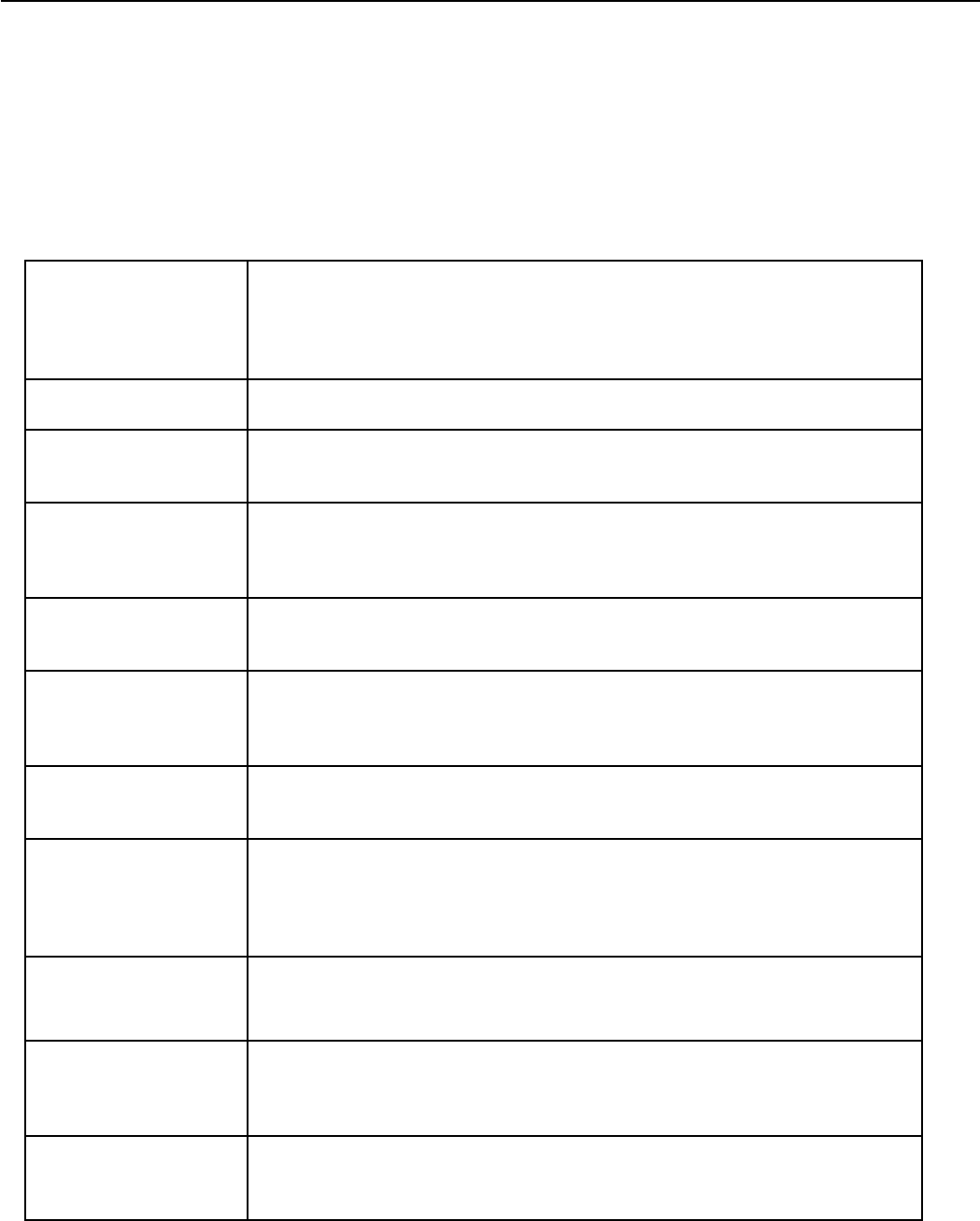
24 PB
OPERATION
Electronic Control Board Features
The Vert-I-Pak has state of the art features to improve guest comfort and conserve energy.
Below is a list of standard features on every VPAK and their benett to the owner.
Quite Start/ Stop
Fan Delay
The fan start and stop delays prevent abrupt changes in room acoustics due to the compressor
energizing or stopping immediately. Upon call for cooling or heating the unit fan will run for ve
seconds prior to en-ergizing the compressor. Also, the fan off delay allows for “free cooling” by
utilizing the already cool indoor coil to its maximum capacity by running for 30 seconds after the
compressor.
Remote Thermostat Opera-
tion
VPAK units can be congured to be set up with a wired thermostat, wireless thermostat, or an
ernegy management thermostat.
Internal Diagnostic Program The VPAK features a self diagnostic program that can alert maintenance to compo-nent failures
or operating problems. The internal diagnostic program saves properties valuable time when
diagnosing running problems.
Service Error Code Storage The self diagnosis program will also store error codes in memory if certain conditions occur and
correct themselves such as extreme high or low operating conditions or activation of the room
freeze protection feature. Storing error codes can help properties determine if the unit faced
obscure conditions or if an error occurred and corrected itself.
Random Compressor Restart Multiple compressors starting at once can often cause electrical overloads and premature unit
failure. The random restart delay eliminates multiple units from starting at once following a
power outage or initial power up. The compressor delay will range from 180 to 240 seconds.
Heat Pump Units Digital
Defrost Thermostat
The VPAK uses a digital thermister to accurately monitor the outdoor coil conditions to allow the
heat pump to run whenever conditions are correct. Running the VPAK in heat pump mode save
energy and reduces operating costs. The digital thermostat allows maximization of heat pump
run time.
Instant Heat Heat Pump
Mode
Heat pump models will automatically run the electric heater during compressor lock-out to
quickly provide heat when initially energized, then return to heat pump mode. This ensures that
the room is heated quickly without the usual delay associated with heat pump units.
Room Air Sampling Feature The room air sampling feature maintains a balanced temperature throughout the room by
circulating the air for 90 seconds once every 9 minutes that the unit is not running when it is set
to cooling or heating mode. By circulating the air, the unit can detect hot or cold areas in the room
and operate the unit to cool or warm the room as necessary. This function is only available when
the fan mode is set to ‘AUTO’ during COOL or HEAT Mode.
Desk Control Ready All electronic VPAK units have low voltage terminals ready to connect a desk control energy
management system. Controlling the unit’s on/off operation from a remote location like the front
desk can reduce energy usage and requires no additional accessories at the VPAK.
Indoor Coil Frost Sensor The frost sensor protects the compressor from damage in the event that airow is reduced or
low outdoor temperatures cause the indoor coil to freeze. When the indoor coil reaches 30°F the
compressor is diabled and the fan continues to operate based on demand. Once the coil tempera-
ture returns to 45°F the compressor returns to operation.
Auxiliary Fan Ready The VPAK features a 24V AC terminal for connection to a relay that may be used to operate an
auxiliary fan to transfer air to adjoining rooms. Auxiliary fans can provide air conditioning to odd
shaped rooms.

25 PB
Operation
Electronic Sequence of Operation
Compressor and Reversing Valve Control
Active Mode Compressor Reversing Valve
Cooling On De-Energized
Heat - Pump On Energized
Heat - Electric Off
Fan Only Off
Reversing Valve
The reversing valve stays in the last state until a call for heat or cooling.
The reversing valve only changes when required to provide coooling or heat pump. Leave the reversing valve in it’s last state
until it’s required to change.
Unit Cooling Mode
Once the ambient temperature rises past the cool demand set point of the t-stat (see gure below), and the
compressor is not locked out, the cooling cycle begins. As shown in the gure below, the fan is started 5 seconds
prior to the compressor. Once the ambient temperature has been lowered to the cool set point, the cooling cycle
starts to terminate by shutting off the compressor. After a 30 seconds delay, the fan is shut off.
Heating Mode Control Operation
There are two heating methods: Heat Pump and Electric Resistance Heat.
There are 2 Types of units that provide heating:
Cool / Heat Pump with Electric Heat and Cool with Electric heat.
Heat Mode in Cool with Electric Heat Units
When the t-stat is in the Heat Mode, if the indoor ambient temperature is below the heat set point, the fan turns on 5 sec-
onds prior then the electric heat will turn on. When the t-stat is satised, the electric heat will turn off. The fan turns off 15
seconds later.
Heat Pump With Electric Heat Operation
This heating has two heating methods. If the ambient indoor temperature is below the heat set point and the compressor is
not locked out, the compressor turns on. If the ambient temperature rises above the t-stat’s heat set point, the compressor
turns off.
If the Compressor is Locked Out on the 3 Minute Time Delay and Electric Heat is Available
1. The control turns on the electric heat until the compressor is not locked out.
2. After lockout, the control turns off the electric heat, waits 5 seconds, then turns on the compressor.(The wired
remote wall t-stat’s time delay may override this feature).
Condition 1
If the outdoor coil temperature sensor drops to 30 degrees F for less than 2 consecutive minutes, the unit will switch to elec-
tric heat if available. Thereafter, the unit will switch back to Heat Pump heat until the outdoor coil temperature sensor rises
to 45 degrees F or greater.
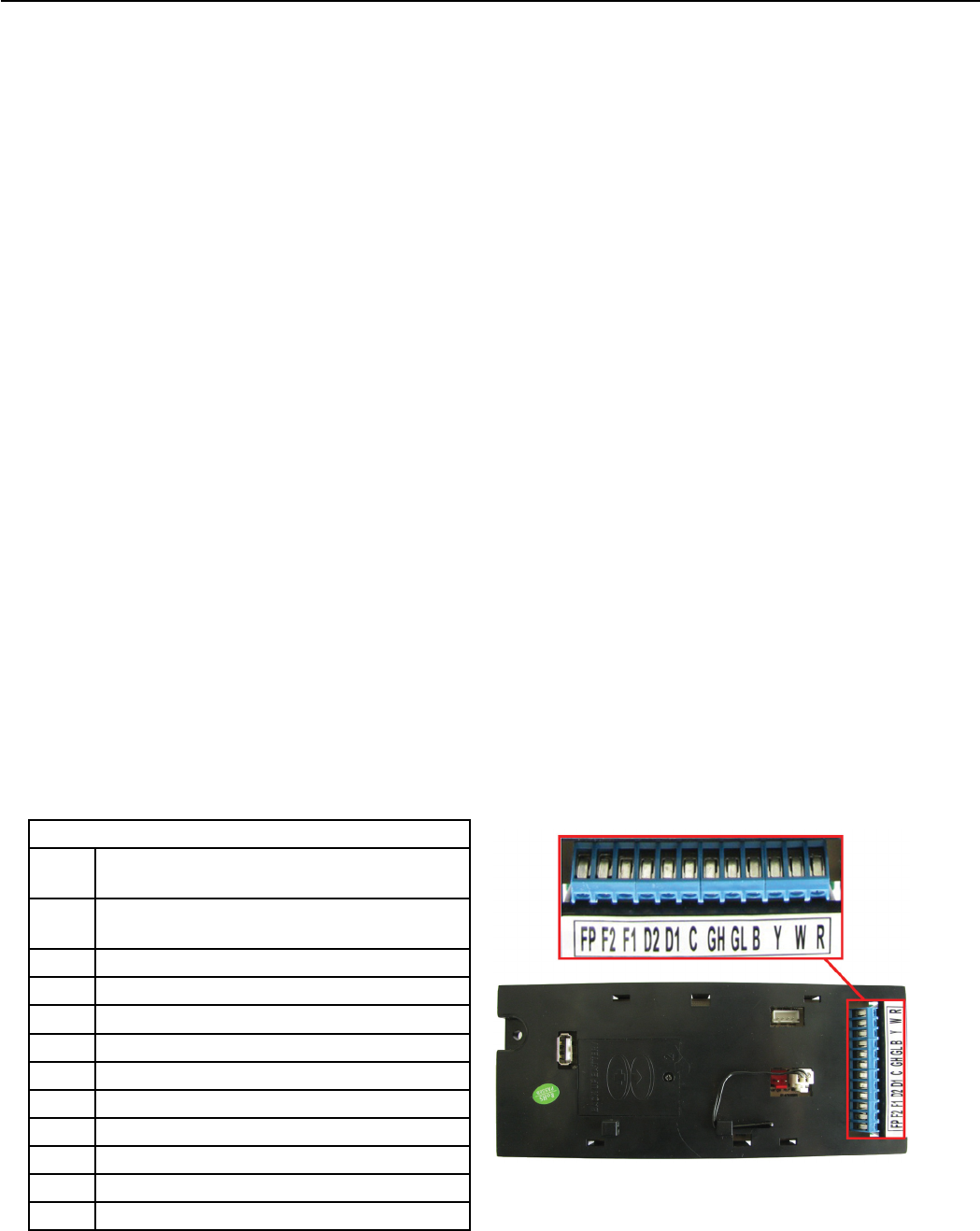
26 PB
OPERATION
Compressor Lock Out Time
The lockout feature ensures that the compressor is de-energized for a period of time. The timer varies randomly
from 180 to 240 seconds.
The compressor lockout is initiated every time the compressor is “off” due to:
(1) Satisfying the T-stat temperature set point
(2) Changing mode to fan only or heat
(3) Turning the unit off
(4) Power is restored after failure
(5) Line power is restored from a brown out condition
Cooling Fan Delay
This is only for t-stat Fan Auto Mode only.
When unit cycles cooling ON – starts the fan 5 seconds EARLY. When unit cycles cooling OFF – DELAYS the fan off for 30
seconds
Heating Fan Delay
This is only for Fan Auto Mode (Fan cycles with cool/heat operation) and not for continuous fan mode. When unit cycles Heat-
ing ON – starts the fan 5 seconds EARLY. When unit cycles Heating OFF – DELAYS the fan off for 15 seconds.
Continuous fan operation enables fan to run continuously.
Fan Speed Change Delay
Relay activation is delayed by a minimum number of seconds. The default for this value is 2 seconds and is used to eliminate
relay chatter.
Room Air Sampling Feature
The room air sampling feature maintains a balanced temperature throughout the room by circulating the air for 90 seconds
once every 9 minutes that the unit is not running when it is set to cooling or heating mode. By circulating the air, the unit can
detect hot or cold areas in the room and operate the unit to cool or warm the room as neces-sary. This function is only avail-
able when the fan mode is set to ‘AUTO’ during COOL or HEAT Mode.
Low Voltage Interface Connections
All Vert-I-Pak units have a low voltage interface connector through
which a Remote Wall Thermostat, Desk Control and Auxiliary Fan’s
Relay can be connected. The interface connector is located on the electronic control board.
Interface Connector Denitions
FP Factory use only.
(Ensure there is no jumper at FP an F2)
F2 Used with F1 to provide 24 VAC to external
fan relay. (Ensure there is no jumper at FP an F2
F1 Used with F2 to provide 24 VAC to external fan relay.
D2 Used with D1 for desk control on or off operation.
D1 Used with D2 for desk control on or off operation.
C Common Ground TerminaL
GH Call for high fan
GL Call for low fan
B Call for heat pump reversing valve
Y Call for compressor
W Call for heating
R 24V Power from Electronic Control to Wall
Figure 301 (Inteface Connections) Figure 302 (Inteface Connections)
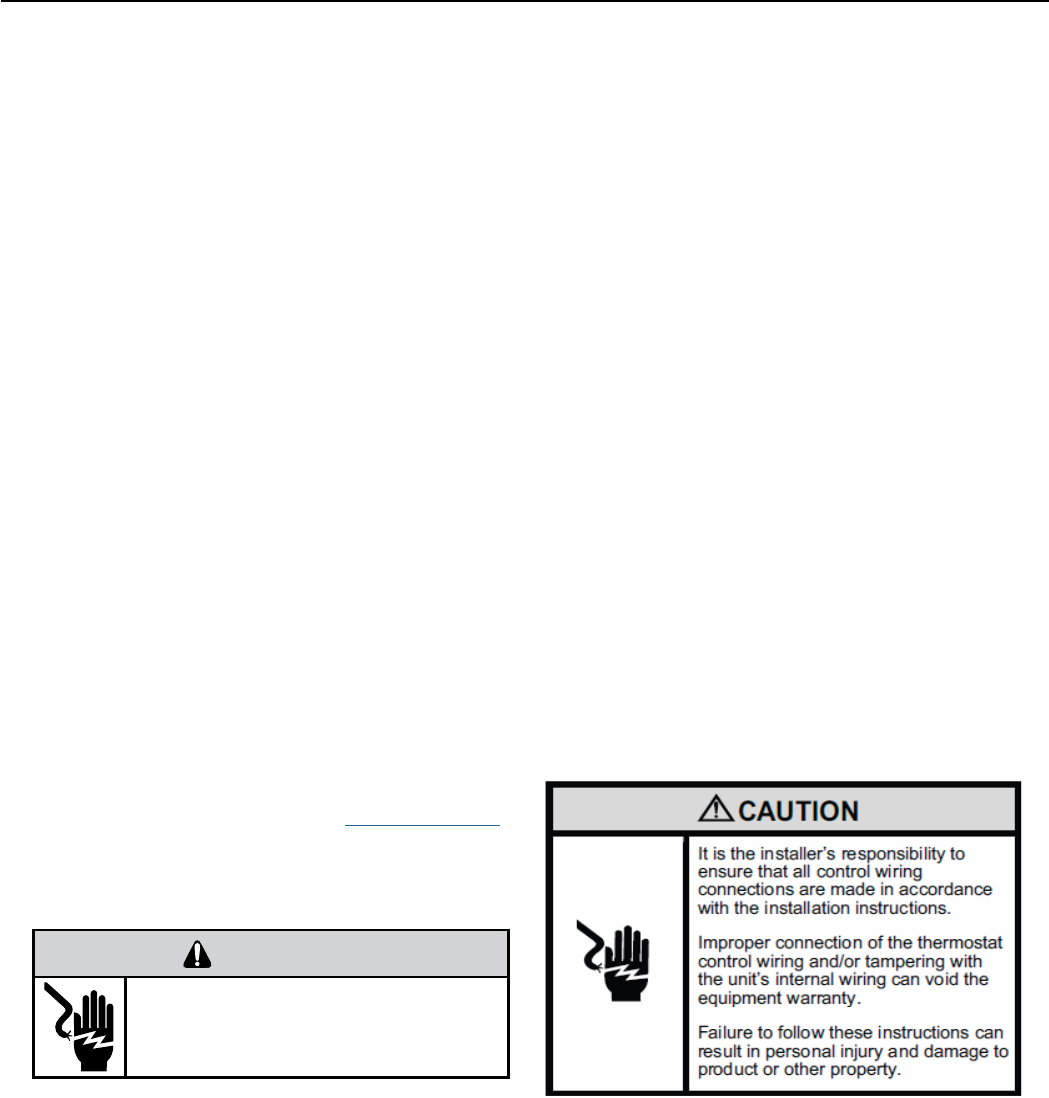
27 PB
OPERATION
Remote Wall Thermostat
All Vert-I-Pak units are factory congured to be controlled by using a single stage heat/cool remote wired wall mounted ther-
mostat.
Thermostat Selection
SINGLE STAGE THERMOSTATS
RT7P
Wired, single stage, wall-mounted programmable thermostat with two fan speeds
and backlight. Controls VERT-I-PAK.
RT7
Wired, single stage, wall-mounted digital thermostat with two fan speeds and
backlight. Controls VERT-I-PAK.
WRT2
Wireless, single stage, wall-mounted programmable thermostat with two fan
speeds and backlight. Controls VERT-I-PAK.
ENERGY MANAGEMENT THERMOSTATS
EMRT2/EMWRT2
Wired/Wirelss thermostat with occupancy sensor
Thermostat terminals requirements:
C, R, G, Y, W, B.
For two fan speeds, thermostat must have 2 fan speed selection.
During Heat Mode:
The B terminal must be continuously energized. The W terminal must have 24 VAC output to call for heat. The control board
decides on whether to turn on the Heat Pump Heat (compressor) or Electric Heat. The Y terminal should not have 24 VAC output
during heat mode.
Connecting a Remote Wall Thermostat
WARNING
ELECTRIC SHOCK HAZARD
Disconnect power to the unit before
servicing. Failure to follow this warning
could result in serious injury or death.
1) Ensure jumper Is not Installed At FP And F2
2) Disconnect power to the unit.
3) Unscrew and remove the electrical control box’s cover.
4) Locate the Interface Connector (24 VAC terminal strip (See gure 1 at left).
5) Make the wire connections according to the con guration needed for
your unit Use #18 gauge wire size.
6) Once each wire is matched and connected, the unit is now ready to be controlled by the thermostat.
7) Reattach the electrical control box’s cover.
CONNECT THERMOSTAT USING FIGURES 301, 302, and 303.
Refer to thermosts Manuals for installation. Current thermo-
stat manuals may be obtained online at www.friedrich.com.
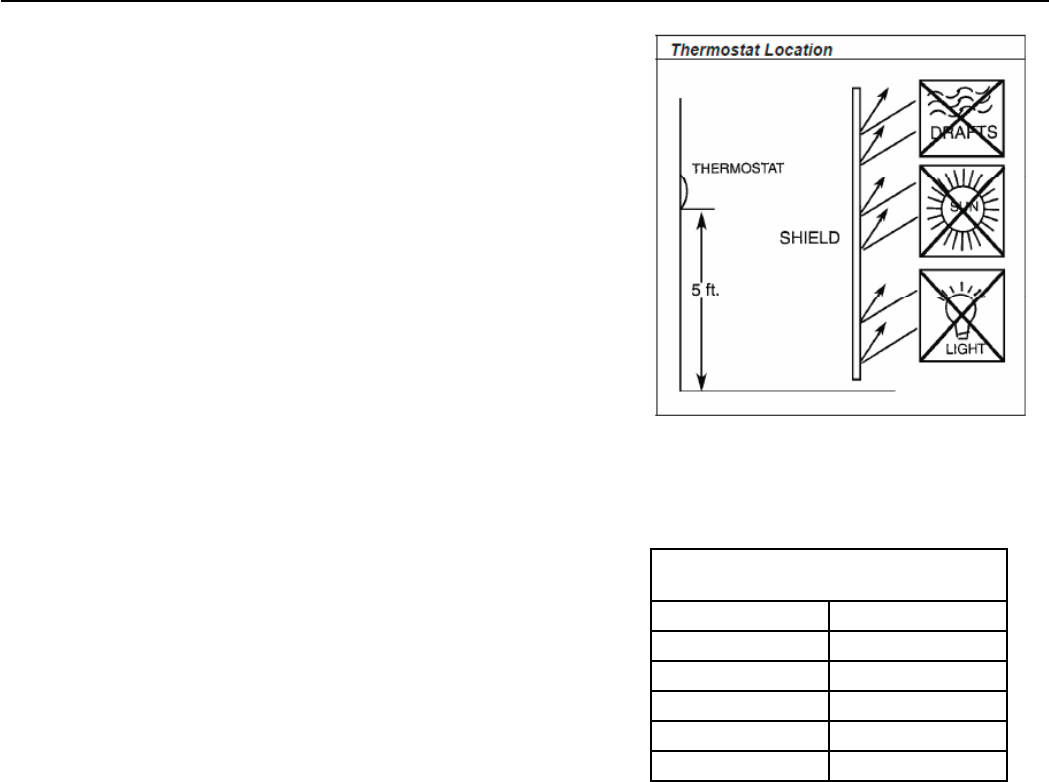
28 PB
OPERATION
Remote Wall Thermostat Location
The thermostat should not be mounted where it may be affected by drafts,
discharge air from registers (hot or cold), or heat radiated from the sun
appliances, windows etc.. The thermostat should be located about 5 Ft. above
the oor in an area of average temperature, with good air circulation.
Thermostats should be level for aesthetics.
Note: An improperly operating or poorly located remote wall thermostat
can be the source of perceived equipment problems. A careful check of the
thermostat’s location and wiring must be made to ensure that it is not the
source of problems.
Desk Control
The unit’s electronic control has built-in provisions for connection to an exter-
nal switch to control power to the unit. The switch can be a central desk control
system or even a normally open door switch.
For desk control operation, connect one side of the switch to the D1 terminal and the
other to the D2 terminal (See page 12). Whenever the switch closes, the unit operation
will stop.
Maximum wire Length for Desk Control
Switch
Wire Size Maximum Length
#24 400 ft.
#22 600 ft.
#20 900 ft.
#18 1500 ft.
#16 2000 ft.
Auxiliary Fan Control
The electronic control also has the ability to control a 24 VAC relay to activate an auxiliary, or transfer fan. The outputs are
listed as F1 and F2 on the interface connector (See page 12).
To connect the relay, simply wire one side of the relay to F1 and the other side to F2. Anytime that the fan runs, the terminals
will send a 24 VAC signal to the relay. The relay must be 24 VAC, 50mA or less.
Note: The Desk Control, Auxiliary Fan relay and wires must be eld supplied.
Figure 303 (Thermostat Locations)

29 PB
OPERATION
Unit Heat Control Operation - Heat Pump With Electric Heat
Automatic Emergency Heat
If the sealed system fails with a bad reversing valve or anything that causes the indoor coil to get colder than the
indoor ambient temperature:
1) If the indoor coil thermistor senses a 5 degree temperature drop as compared to the ambient temperature
thermistor and this lasts up to 5 minutes, the control board will switch the unit to electric heat and continue
heating with it.
2) At this point, error code 15 is generated; heat pump failure. Indoor coil temperature lower than indoor ambient
temperature for 5 or more degrees for 5 consecutive minutes.
Note: It is Ok to continue to use the unit with the electric heater until the heat pump is repaired.
Heat Control Operation - Electric Heat Only
When in the Heat mode, with and without Fan Mode Auto (Fan cycling):
If the indoor ambient temperature is below the Heat Demand Threshold (Heat Set Point minus 1.5 ˚F), turn on
electric heat. If Ambient is 0.3 ˚F above the Heat Set Point turn off the electric heat.
System Mode Auto
This mode provides automatic change over between cool and heat. The auto mode runs based on the room ambient
temperature vs. the Demand Thresholds. It is only available in Heat-Cool Unit.
Notes:
There is a buffer zone between the cool and heat set points where no heating or cooling is allowed to occur. It is
critical that the Cool Demand Threshold be greater than the Heat Demand Threshold by a minimum of 3° while
in the Auto System Mode. For example, if a user enters a value for the Auto Cooling Set Point that violates the
minimum delta 3° rule, the Auto Heating Set Point will adjust accordingly.
Automatic Change Over Delay (Cool with Heat Units)
The change over delay ensures that any system heating or cooling over shoot does not trigger an opposite demand
cycle. The change over delay = 15 min. This timer blocks the opposite demand cycle from running until the timer
expires. As an example, if the last demand was a cool cycle, and another cool cycle is requested, the timer will not
block the request. However, if the last demand cycle was a cool cycle, and heat cycle is requested, the timer will
block the request until the change over delay is expired.
Compressor Lock Out Time
The lockout feature ensures that the compressor is de-energized for a period of time. The timer varies randomly
from 180 to 240 seconds
The compressor lockout is initiated every time the compressor is “off” due to:
(1) Satisfying the temperature set point
(2) Changing mode to fan only or heat
(3) Turning the unit off
(4) Control is rst plugged in or power is restored after failure
(5) Line power is restored from a brown out condition
Cooling Fan Delay
Fan cycle/Auto mode only
When unit cycles cooling ON – starts the fan 5 seconds EARLY. When unit cycles cooling OFF – DELAYS the fan off
for 30 seconds.
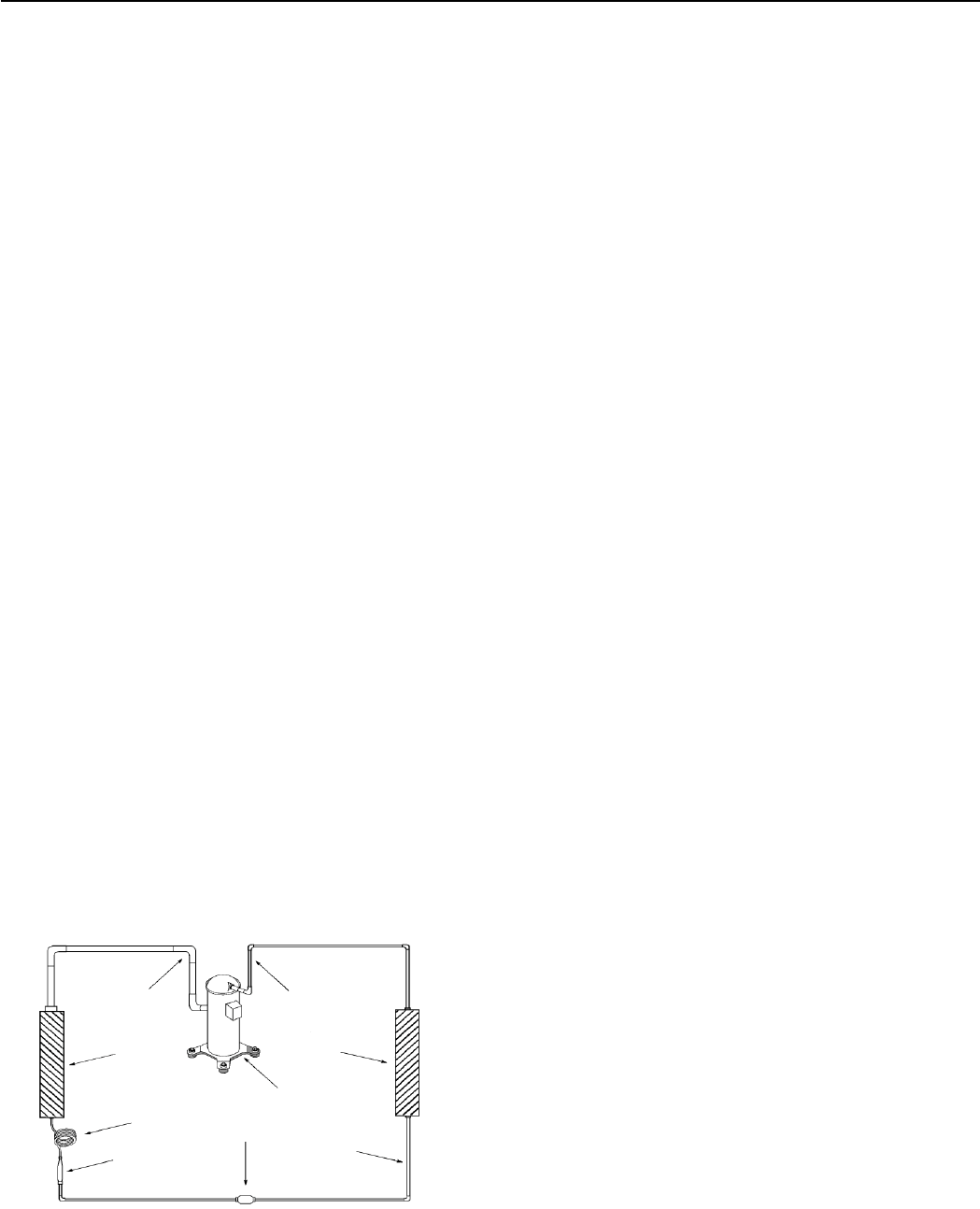
30 PB
OPERATION
General Knowledge Sequence Of Refrigeration
A good understanding of the basic operation of the refrigeration system is essential for the service technician. Without this
understanding, accurate troubleshooting of refrigeration system problems will be more difcult and time consuming, if not (in
some cases) entirely impossible. The refrigeration system uses four basic principles in its operation which are as follows:
1. “Heat always ows from a warmer body to a cooler body.”
2. “Heat must be added to or removed from a substance before a change in state can occur”
3. “Flow is always from a higher pressure area to a lower pressure area.”
4. “The temperature at which a liquid or gas changes state is dependent upon the pressure.”
The refrigeration cycle begins at the compressor when a demand is received from the thermostat. Starting the compressor
creates a low pressure in the suction line which draws refrigerant gas (vapor) into the compressor. The compressor then
“compresses” this refrigerant vapor, raising its pressure and its (heat intensity) temperature.
The refrigerant leaves the compressor through the discharge line as a hot high pressure gas (vapor). The refrigerant enters the
condenser coil where it gives up some of its heat. The condenser fan moving air across the coil’s nned surface facilitates the
transfer of heat from the refrigerant to the relatively cooler outdoor air.
When a sufcient quantity of heat has been removed from the refrigerant gas (vapor), the refrigerant will “condense” (i.e.
change to a liquid). Once the refrigerant has been condensed (changed) to a liquid it is cooled even further by the air that
continues to ow across the condenser coil.
The design determines at exactly what point (in the condenser) the change of state (i.e. gas to a liquid) takes place. In all cases,
however, the refrigerant must be totally condensed (changed) to a liquid before leaving the condenser coil.
The refrigerant leaves the condenser coil through the liquid line as a warm high pressure liquid. It next will pass through the
refrigerant drier (if equipped). It is the function of the drier to trap any moisture present in the system, contaminants, and large
particulate matter.
The liquid refrigerant next enters the metering device. The metering device is called a capillary tube. The purpose of the
metering device is to “meter” (i.e. control or measure) the quantity of refrigerant entering the evaporator coil.
In the case of the capillary tube this is accomplished (by design) through size (and length) of device, and the pressure difference
present across the device. Since the evaporator coil is under a lower pressure (due to the suction created by the compressor)
than the liquid line, the liquid refrigerant leaves the metering device entering the evaporator coil. As it enters the evaporator
coil, the larger area and lower pressure allows the refrigerant to expand and lower its temperature (heat intensity). This
expansion is often referred to as “boiling” or atomizing. Since the unit’s blower is moving indoor air across the nned surface
of the evaporator coil, the expanding refrigerant absorbs some of that heat. This results in a lowering of the indoor air
temperature, or cooling.
The expansion and absorbing of heat cause the liquid refrigerant to evaporate (i.e. change to a gas). Once the refrigerant has
been evaporated (changed to a gas), it is heated even further by the air that continues to ow across the evaporator coil.
The particular system design determines at exactly what point (in the
evaporator) the change of state (i.e. liquid to a gas) takes place. In all
cases, however, the refrigerant must be totally evaporated (changed)
to a gas before leaving the evaporator coil.
The low pressure (suction) created by the compressor causes the
refrigerant to leave the evaporator through the suction line as a cool
low pressure vapor. The refrigerant then returns to the compressor,
where the cycle is repeated.
Suction
Line
Evaporator
Coil
Metering
Device
Refrigerant
Strainer
Discharge
Line
Condenser
Coil
Compressor
Refrigerant Drier
Liquid
Line
Figure 304 (Sequence of Operation)

31 PB
Coils & Chassis
NOTE: Do not use a caustic (alakaline) or acidic cleaning agent on coils or base pan. Use a biodegradable cleaning agent and
degreaser. The use of harsh cleaning materials may lead to deterioration of the aluminum ns or the coil end plates.
The indoor coil and outdoor coils and base pan should be inspected periodically (annually or semi-annually) and cleaned of all
debris (lint, dirt, leaves, paper, etc.) as necessary. Under extreme conditions, more frequent cleaning may be required. Clean the
coils with and base pan with a coil comb or soft brush and compressed air or vacuum. A low pressure washer device may also be
used; however, you must be careful not to bend the aluminum n pack. Use a sweeping up and down motion in the direction of
the vertical aluminum n pack when pressure cleaning coils.
NOTE: It is extremely important to insure that none of the electrical and/ or electronic parts of the unit get wet when cleaning.
Be sure to cover all electrical components to protect them from water or spray.
NOTE: When installed on or near sea coast environments, it recommended that all coils be cleaned at minimum biannually.
Decorative Front
Use a damp (not wet) cloth when cleaning the control area to prevent water from entering the unit, and possibly damaging the
electronic control.
The decorative front and the cabinet can be cleaned with warm water and a mild liquid detergent. Do NOT use solvents or
hydrocarbon based cleaners such as acetone, naphtha, gasoline, benzene, etc.
The indoor coil can be vacuumed with a dusting attachment if it appears to be dirty. DO NOT BEND FINS. The outdoor coil can be
gently sprayed with a garden hose.
The air lter should be inspected weekly and cleaned if needed by vacuuming with a dust attachment or by cleaning in the sink
using warm water and a mild dishwashing detergent. Dry the lter thoroughly before reinstalling. Use caution, the coil surface
can be sharp.
Fan Motor & Compressor
The fan motor & compressor are permanently lubricated and require no additional lubrication.
Wall Sleeve
Inspect the inside of the wall sleeve and drain system periodically (annually or semi-annually) and clean as required. Under
extreme conditions, more frequent cleaning may be necessary. Clean both of these areas with an] bio-growth cleaner. Rinse
both items thoroughly with water and ensure that the drain outlets are operating correctly. Check the sealant around the sleeve
and reseal areas as needed.
Inspect for bio-growth periodically. If present, ensure the sealing gasket around the unit is in good condition and not allowing
outside air (or light) through the gasket.
Blower Wheel / Housing / Condensor Fan / Shroud
Inspect the indoor blower and its housing, evaporator blade, condenser fan blade and condenser shroud periodically (yearly or
bi-yearly) and clean of all debris (lint, dirt, bio-growth etc.). Clean the blower housing area and blower wheel with a bio-growth
cleaner. Use a biodegradable cleaning agent and degreaser on condenser fan and condenser shroud. Use warm or cold water
when rinsing these items. Allow all items to dry thoroughly before reinstalling them.
Electrical / Electronic
Periodically (at least yearly or bi-yearly) inspect all control components: electronic, electrical and mechanical, as well as the
power supply. Use proper testing instruments (voltmeter, ohmmeter, ammeter, wattmeter, etc.) to perform electrical tests. Use
an air conditioning or refrigeration thermometer to check room, outdoor and coil operating temperatures.
Air Filter
To ensure proper unit operation, the air lter should be cleaned at least monthly, and more frequently if conditions warrant. The unit
must be turned off before the lter is cleaned.
Routine Maintenance
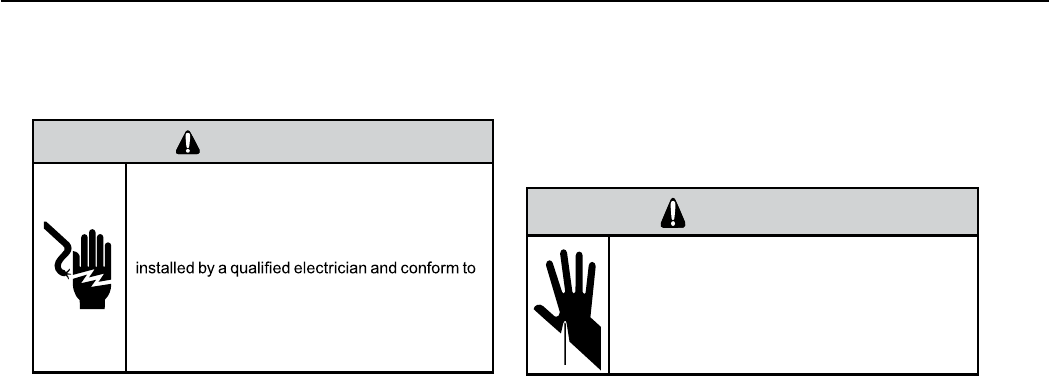
32 PB
REMOVE AND INSTALL THE CHASSIS
Remove The Chassis
WARNING
ELECTRIC SHOCK HAZARD
Turn off electric power before service or
installation.
All electrical connections and wiring MUST be
the National Electrical Code and all local codes
which have jurisdiction.
Failure to do so can result in personal injury or
death.
WARNING
CUT/SEVER HAZARD
Be careful with the sharp edges and corners.
Wear protective clothing and gloves, etc.
Failure to do so could result in serious injury.
Servicing / Chassis Quick Changeouts
The chassis is designed for quick disconnect and change out. For minor electrical service, the control box cover lifts straight up
after the screws & disconnect head are removed. For major electrical, refrigeration and fan service the chassis may be re-
moved from utility closet.
To Remove the Chassis from the Closet:
A. Disconnect the power coming into the unit from the main breaker panel or the closet mounted disconnect.
B. Switch the wall Thermostat off.
C. Pull the Power Disconnect located in the front of the chassis.
D. Disconnect the electrical connection.
E. Disconnect the duct work.
F. Disconnect condensate drain on 9-18,000 BTU models (2018 18,000 BTU models excluded).
G. Slide the chassis out of the wall plenum.
H. Lift the chassis out of the utility closet.

33 PB
External Static Pressure can best be described as the pressure difference (drop) between the Positive Pressure (discharge)
and the Negative Pressure (intake) sides of the blower. External Static Pressure is developed by the blower as a result of
resistance to airow (Friction) in the air distribution system EXTERNAL to the VERT-I-PAK cabinet.
Resistance applied externally to the VERT-I-PAK (i.e. duct work, lters, etc.) on either the supply or return side of the system
causes an INCREASE in External Static Pressure accompanied by a REDUCTION in airow.
External Static Pressure is affected by two factors.
1. Resistance.
2. Blower Speed (Changing to a higher or lower blower speed will raise or lower the External Static Pressure
accordingly).
These affects must be understood and taken into consideration when checking External Static Pressure/Airow to insure that
the system is operating within design conditions.
Operating a system with insufcient or excessive airow can cause a variety of different operating problems. Among these are
problems such as, reduced capacity, freezing evaporator coils, premature compressor’ heating component failures, and/ or
other air local distribution issues..
System airow should always be veried upon completion of a new installation, or before a change-out, compressor
replacement, or in the case of heat strip failure to insure that the failure was not caused by improper airow.
Checking External Static Pressure
The airow through the unit can be determined by measuring the external static pressure of the system, and consulting the
blower performance data for the specic VERT-I-PAK.
1. Set up to measure external static pressure at the supply and return air.
2. Ensure the coil and lter are clean, and that all the registers are open.
3. Determine the external static pressure with the blower operating.
Use a digital manometer to measure. The supply measurement should be taken roughly 3-6” from the Vert-I-Pak
collar and the return measurement taken from center of the indoor coil with the lter installed.
NOTE: Ensure that the closet door is closed. Failure to close closet door will result in erroneous readings.
4. Refer to the Air Flow Data for your VERT-I-PAK system to nd the actual airow for factory-selected fan speeds.
5. If the actual airow is either too high or too low, the blower speed will need to be changed to appropriate setting or
the ductwork will need to be reassessed and corrections made as required.
6. Select a speed, which most closely provides the required airow for the system.
7. Recheck the external static pressure with the new speed. External static pressure (and actual airow) will have
changed to a higher or lower value depending upon speed selected. Recheck the actual airow (at this “new” static
pressure) to conrm speed selection.
8. Repeat steps 7 and 8 (if necessary) until proper airow has been obtained.
EXAMPLE: Airow requirements are calculated as follows: (Having a wet coil creates additional resistance to airow. This
additional resistance must be taken into consideration to obtain accurate airow information.
EXTERNAL STATIC PRESSURE
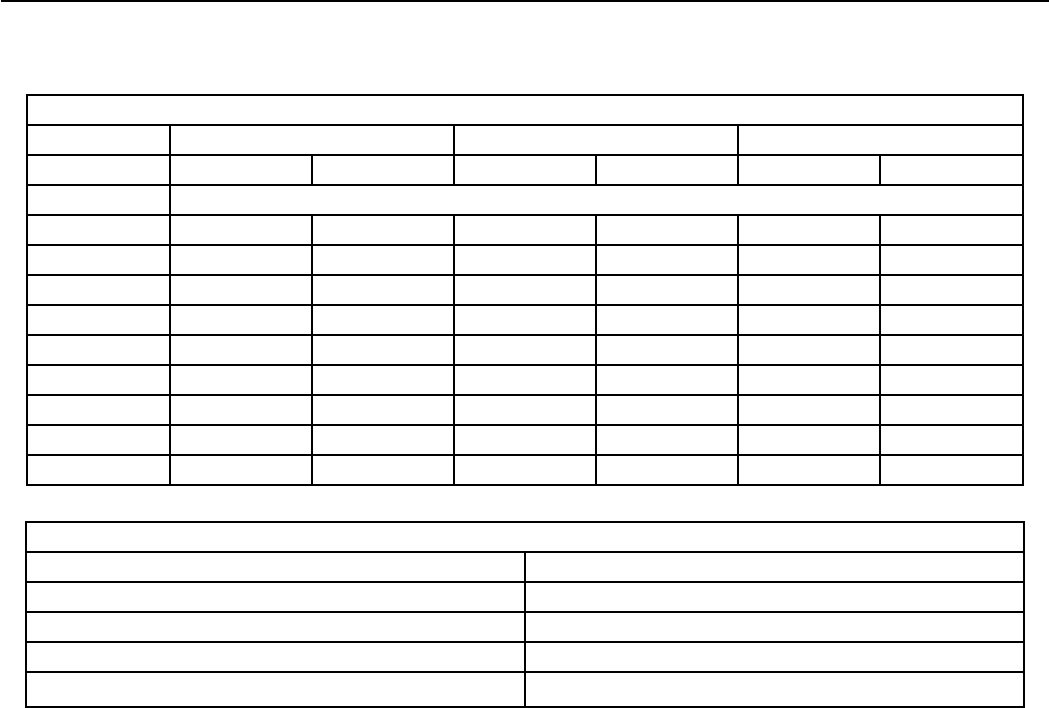
34 PB
External Static Pressure
Determining the Indoor CFM
MODEL VHA 09/12 VHA 18 VHA 24
FAN SPEED LOW HIGH LOW HIGH LOW HIGH
ESP (“) CFM
0.0” 470 520 730 800 755 805
0.05” 460 510 670 735 700 750
*0.10” 430 490 630 675 660 700
0.15” 410 470 595 640 615 665
0.20” 360 440 550 600 575 625
0.25” 310 400 505 550 525 580
0.30” 260 350 455 500 485 540
0.35” -- -- 400 445 450 500
0.40” -- -- 345 400 415 465
* values indicate rated performance point
Correct CFM (if needed): Correction Multipliers
230V 1.00
208V 0.97
265V
Heating 1.00
Cooling 0.95
Explanation of charts
Chart A is the nominal dry coil VERT-I-PAK CFMs. Chart B is the correction factors beyond nominal conditions.
1 ½ TON SYSTEM ( 18,000 Btu)
Operating on high speed @ 230 volts with dry coil
measured external static pressure .10
Air Flow = 450 CFM
In the same SYSTEM used in the previous example but having a WET coil you must use a correction factor of .95 (i.e. 450 x
.95=428 CFM) to allow for the resistance (internal) of the condensate on the coil.
It is important to use the proper procedure to check external Static Pressure and determine actual air ow. Since in the case
of the VERT-I-PAK, the condensate will cause a reduction in measured External Static Pressure for the given air ow.
It is also important to remember that when dealing with VERT-l-PAK units that the measured External Static Pressure in-
creases as the resistance is added externally to the cabinet. Example: duct work, lters, grilles.
Indoor Airow Data
The Vert-I-Pak A series units must be installed with a free return air conguration. The table below lists the indoor airow at
corresponding static pressures. All units are rarted at low speed.
The Vert-I-Pak units are designed for either single speed or two fan speed operation. For single speed operation refer to the
airow table below and select the most appropriate CFM based on the ESP level. Connect the fan output from the thermostat
to the unit on either the GL terminal for low speed or to the GH terminal for high speed operation.
For thermostats with two-speed fan outputs connect the low speed output to the unit GL terminal and the high speed output
to the GH terminal.
Ductwork Preparation
If ex duct is used, be sure all the slack is pulled out of the ex duct. Flex duct ESP can increase considerably when not fully
extended. DO NOT EXCEED a total of .30 ESP, as this is the MAXIMUM design limit for the VERT-I-PAK A-Series unit.
IMPORTANT: FLEX DUCT CAN COLLAPSE AND CAUSE AIRFLOW RESTRICTIONS. DO NOT USE FLEX DUCT FOR: 90 DEGREE
BENDS, OR UNSUPPORTED RUNS OF 5 FT. OR MORE.

35 PB
Fresh Air Door
The Fresh Air Door is an “intake” system. The fresh air door opened via a slide on the front of the chassis located just above the indoor coil. Move the slide left
to open and right to close the fresh air door. The system is capable of up to 60 CFM of fresh air @ ~.3” H20 internal static pressure.
Checking Approximate Airow
If a digital manometer is not available to check the External Static Pressure, or the blower performance data is unavailable for your unit, approximate airflow
call be calculated by measuring the temperature rise, then using tile following criteria.
CFM =
Kilowatts × 3413
Temp Rise × 1.08
Electric Heat Strips
The approximate CFM actually being delivered can be calculated by using the following formula:
DO NOT simply use the Kilowatt Rating of the heater (i.e. 2.5, 3.4, 5.0) as this will result in a less-than-correct air ow cal-
culation. Kilowatts may be calculated by multiplying the measured voltage to the unit (heater) times the measured current
draw of all heaters (ONLY) in operation to obtain watts. Kilowatts are than obtained by dividing by 1000.
EXAMPLE: Measured voltage to unit (heaters) is 230 volts. Measured Current Draw of strip heaters is 11.0 amps.
230 x 11.0 = 2530
2530/1000 = 2.53 Kilowatts
2.53 x 3413 = 8635
Supply Air = 95°F
Return Air = - 75°F
Temperature Rise = 20°F
20 x 1.08 = 21.6
8635
21.6
= 400
External Static Pressure
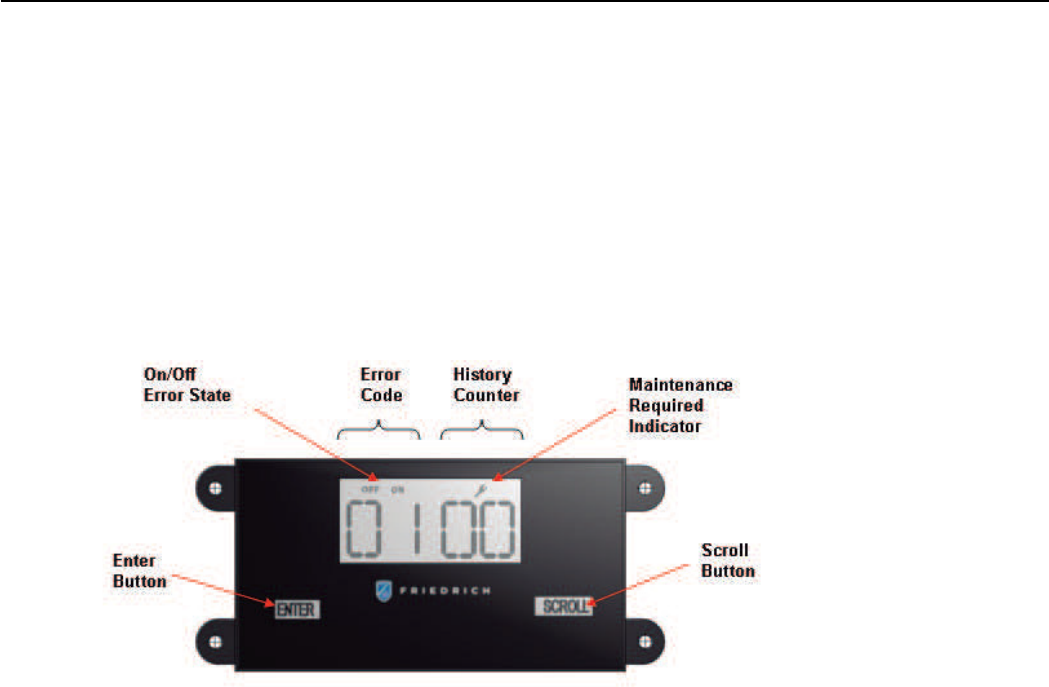
36 PB
TROUBLESHOOTING
Error Codes and Alarm Status
Unit Control Panel
The display shown below has four digits. The left two digits indicate the error code # ( 1 to 24 ), The On/Off icons above these
two digits indicate the currents state of the error code. The right two digits show the history count (up to 99) of the associated
ERROR CODE. THE DISPLAY CONTAINS A MAINTENANCE ICON (WRENCH) THAT WILL ILLUMINATE TO INDICATE WHEN THE
UNIT NEEDS SERVICE.
THIS WRENCH INDICATES AN ERROR CODE # IS ON (ACTIVE). TO FIND OUT WHICH ONE, CHECK ALL ERROR CODES.
CHECK ERROR CODES
1. Press the Enter key to activate the display.
2. Each press of the scroll key display the next error code.
Clear History Counters
1. Press & hold the Enter key and the Scroll Key for 6 seconds.
FIGURE 715 (SERVICE MODULE CONNECTOR)
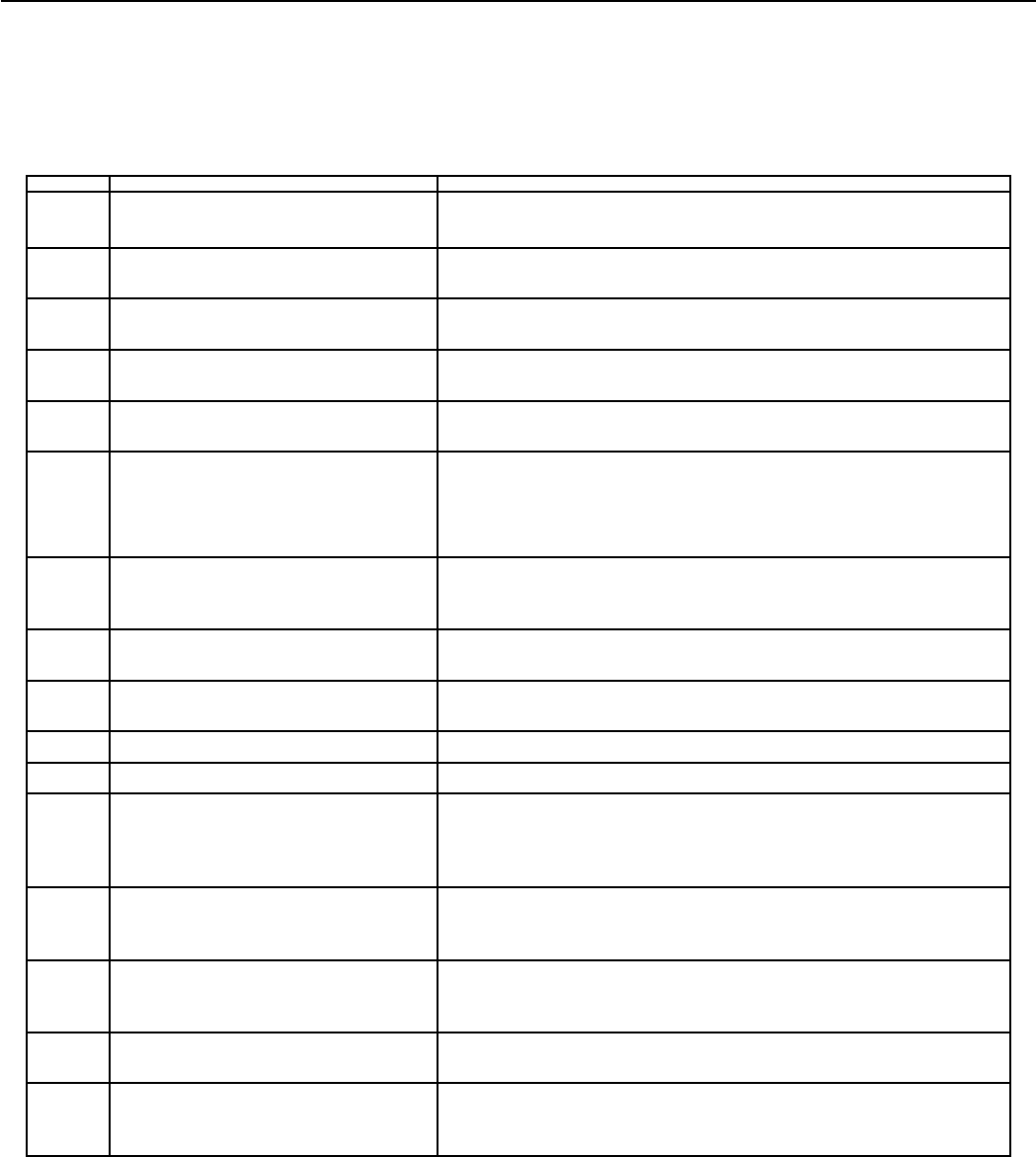
37 PB
DIAG
CODE
PROBLEM CONTROL BOARD'S ACTION
1 Front Panel Button Stuck For More Than
20 Seconds
Continue to monitor for “OPEN” (Unstuck) switch. Do not process switch
input.
2 Input Voltage Out of Specification (187 -
253)
Unit stops, open all relays until voltage is back within specs then resume
operation.
3 Indoor Temperature Sensor is Open or
Shorted
Unit defaults to 75°F in COOLING or 68°F in HEATING and will continue to
operate if setting is below 75°F in cool mode or if above 68°F in heat mode.
4 Indoor Coil Temperature Sensor is Open
or Shorted
The unit’s control board defaults to 40°F. It will override the sensor and the
unit will continue to operate.
5 Outdoor Coil Temperature Sensor is Open
or Shorted
The unit defaults to 20°F, overriding the sensor. The unit will continue to
operate.
Using Elec Heat if available for HEATING. If not available, it will use HEAT
PUMP if the outdoor temperature allows.
6 Outdoor Coil > (grater than) 175 F The unit will shut down for 5 minutes. resume operation for 3 minutes. If test
fails 3 times, the unit operation is locked out. See troubleshooting figure 715.
To reset, turn power off and on.
7 Indoor Coil < (less than) 30 F for 2
consecutive minutes
The compressor will turn off and the High Fan speed will run. When coil
temp reachs 45°F the unit will resume operation after lockout time.
8 Unit Cycles > (greater than) 9 Times per
hour
The unit will continue to operate and be monitored.
9 Unit Cycles < (less than) 3 Times per Hour The unit will continue to operate and be monitored.
11 WallStat Problem or Connection Issue The unit will not operate.
13 VPAK 18K, 24K Unit Only
High Pressure Limit Switch is Open
If unit is cooling or heat pump is on, shut down compressor. Run high fan
until switch closes, then resume operation. The third occurance in 1 hour
locks unit out.
Applicable to 24K unit only. To reset, turn power off and on.
15 Heat Pump Error If indoor coil temperature is less than ambient temperature for 3 minutes,
the unit will use electric heat to satisfy the heating demand. Causes could be
bad reversing valve, heat load too high.
16 Temperature beyond operating limits Occurs if the indoor ambient temperature range falls below 0°F or greater
than 130°F. The error code will remain on until the temperature reaches the
operating range and then the unit will return to normal operation.
17 Equipment Doesn’t Meet Minimum
Configuration
The compressor must be enabled and have at least 2 fan speeds.
22 (Not an error code)
Outdoor Coil Temperature < 30 F for 2
consecutive minutes
Unit will use electric heat to satisfy heating demands until the temperature
equals or exceeds 45°F. Applicable for Heat Pump models only.
TROUBLESHOOTING
Error Codes and Alarm Status
FIGURE 715 (ERROR CODES AND ALARM STATUS)
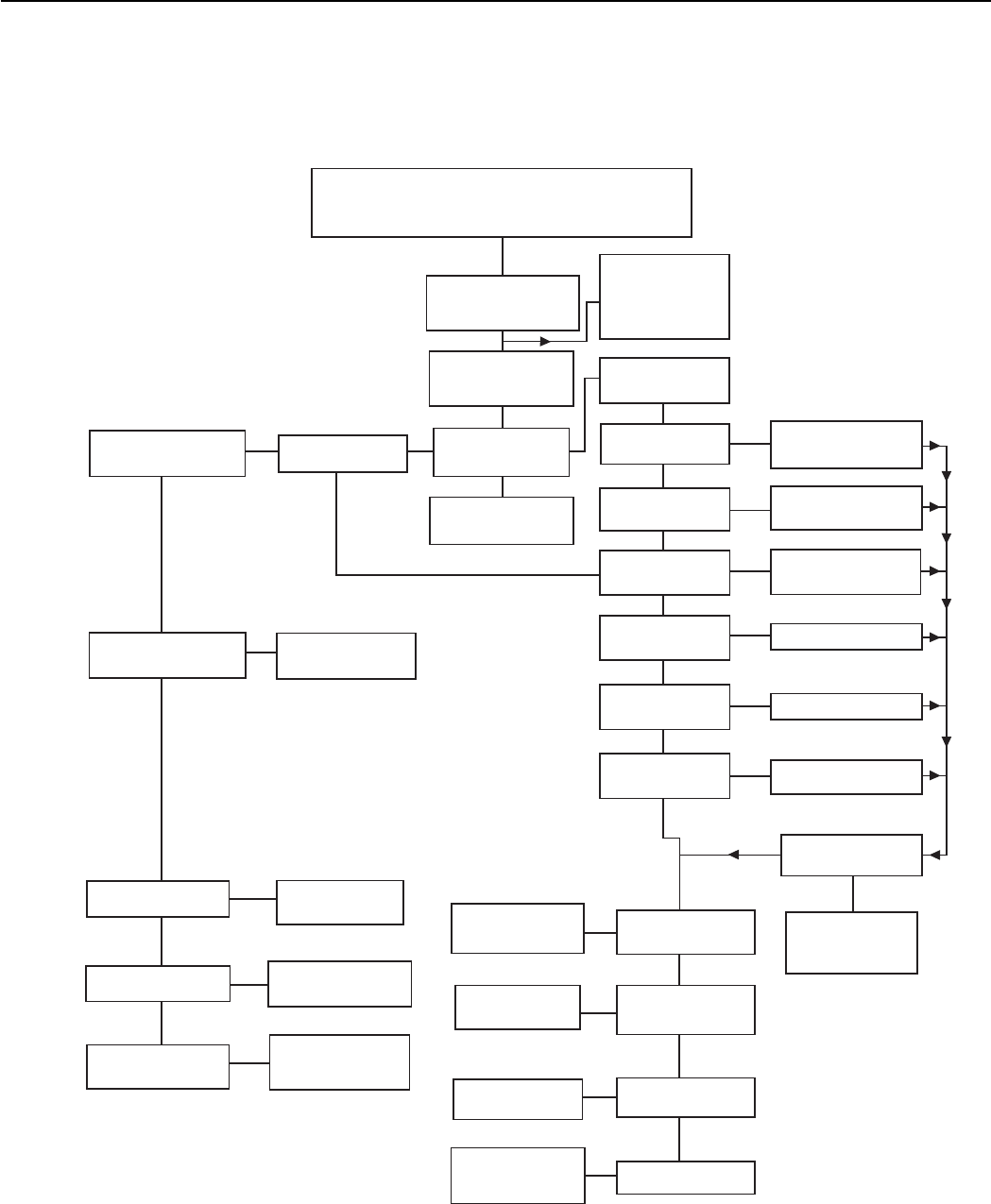
38 PB
TROUBLESHOOTING
Electrical Troubleshooting Chart - Cooling
9K Btu, 12K Btu, & 18K Btu
FIGURE 716 (TROUBLESHOOTING)
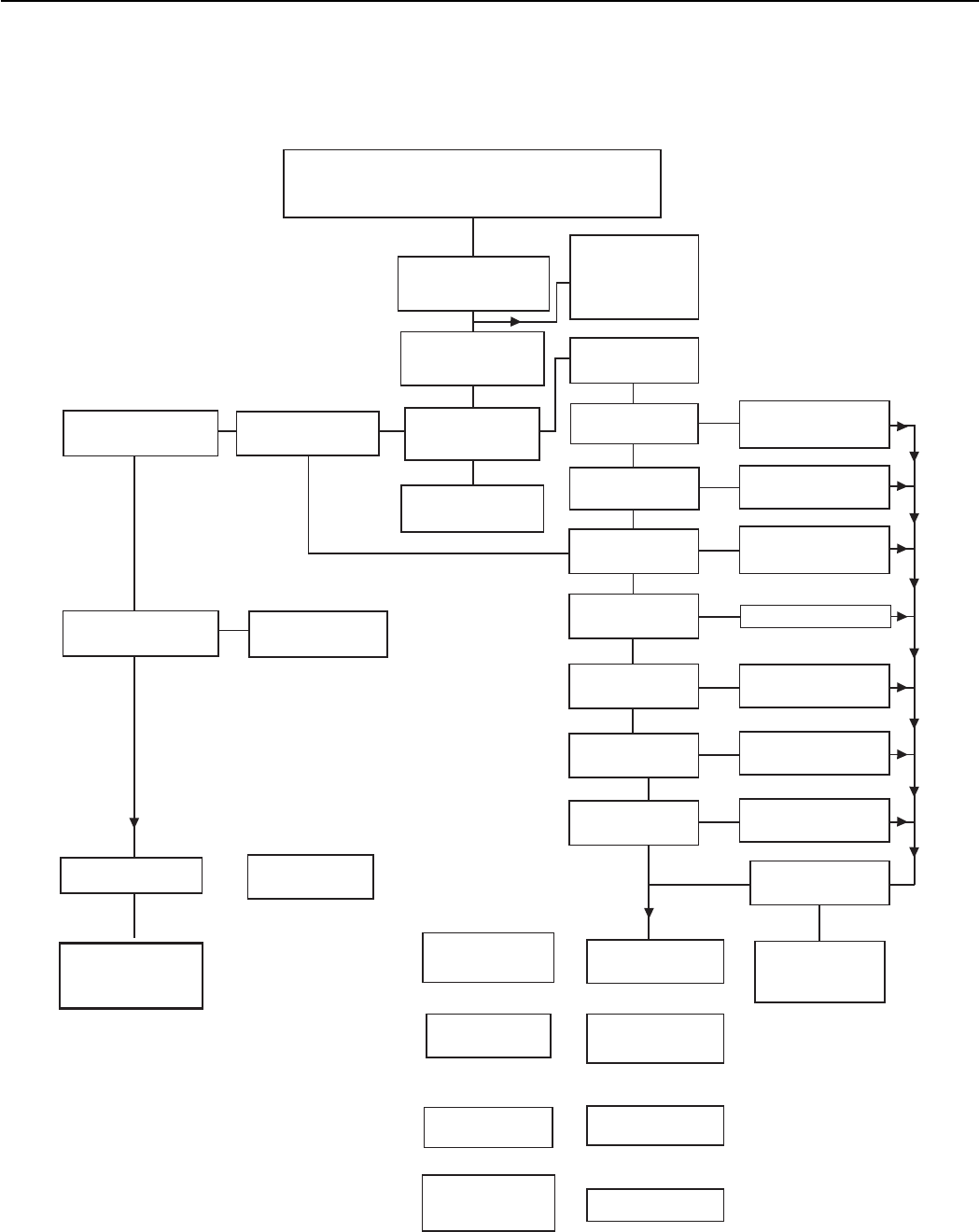
39 PB
TROUBLESHOOTING
Electrical Troubleshooting Chart - Cooling
24K Btu
See Component Testing
24k Indoor Blower
FIGURE 717 (TROUBLESHOOTING)
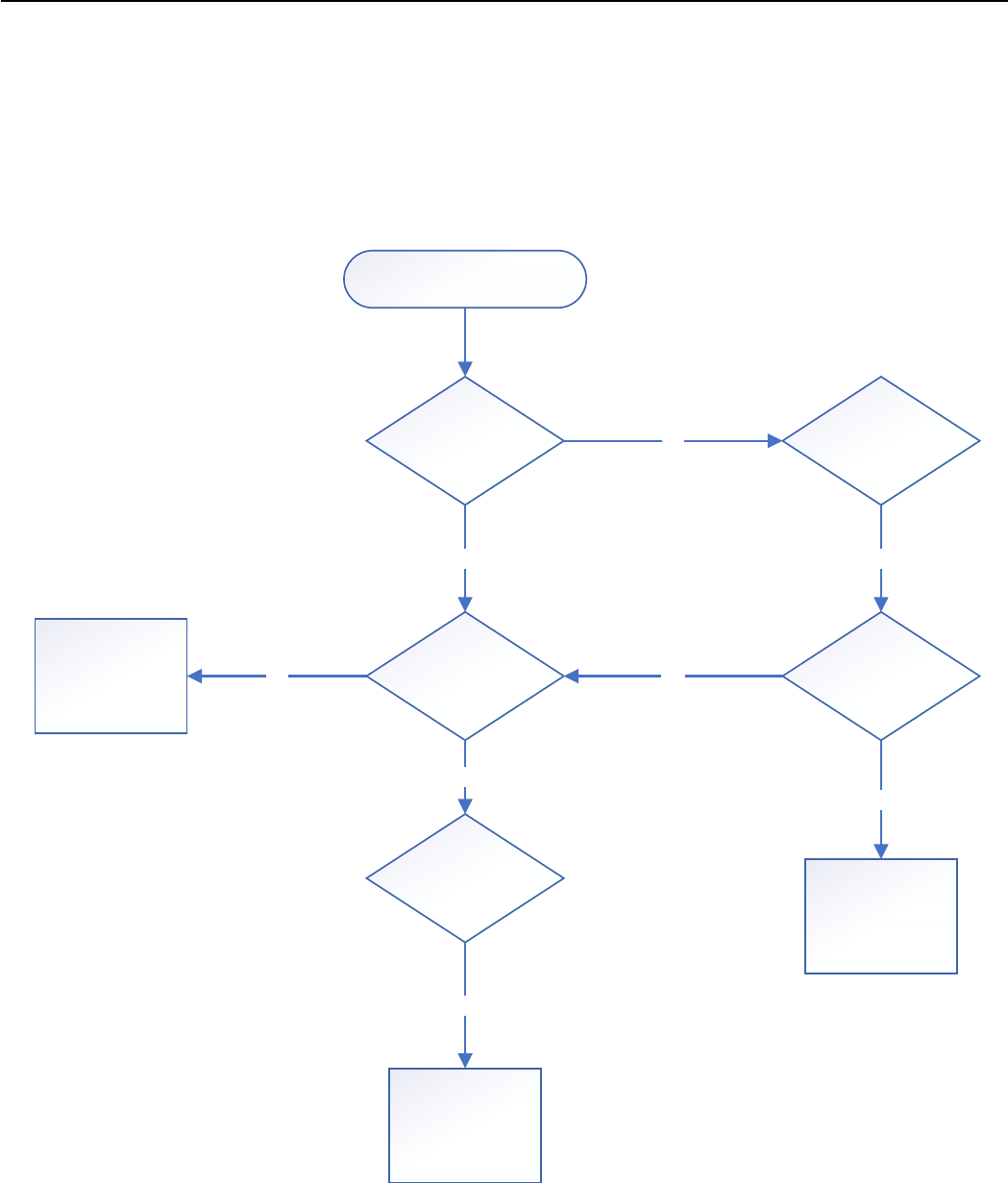
40 PB
TROUBLESHOOTING
Electrical Troubleshooting Chart - Heat Pump
FIGURE 718 (TROUBLESHOOTING)
HEATPUMPMODE
Systemcoolswhenheatingis
desired
Islinevoltagepresent
atsolenoidvalve?
Isselectorswitchset
forheat?
NO
IsroomTSTAT
configuredforB
signal?
YES
ConfigureTSTATfor
Bsignal
NO
Isthesolenoidcoil
good?
YES
YES
ReplaceSole noid
Coil
Isthereversingvalve
stuck?
ReplaceSole noid
Coil
NO
YES
YES
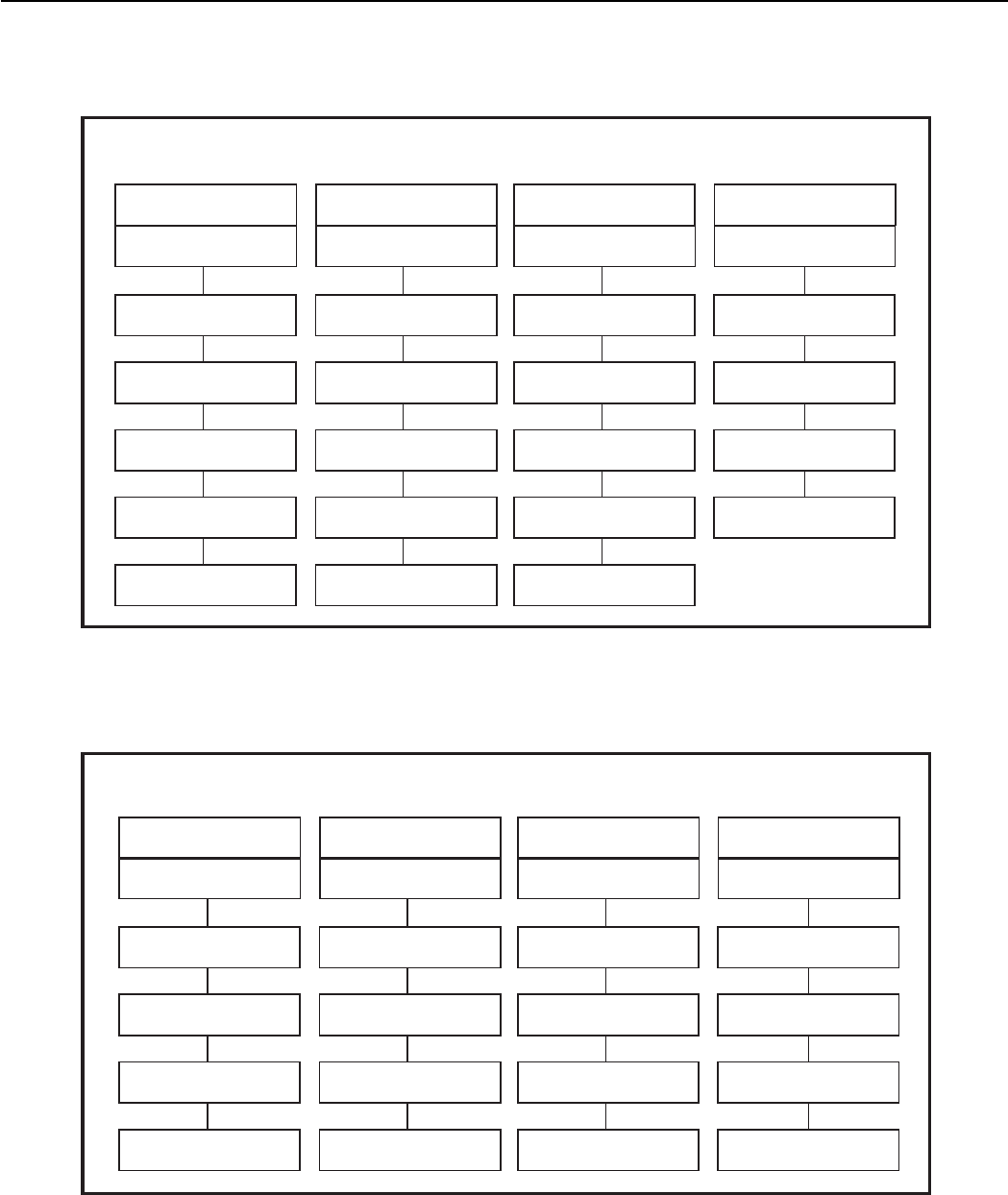
41 PB
TROUBLESHOOTING
Troubleshooting Chart - Cooling
FIGURE 719 (TROUBLESHOOTING)
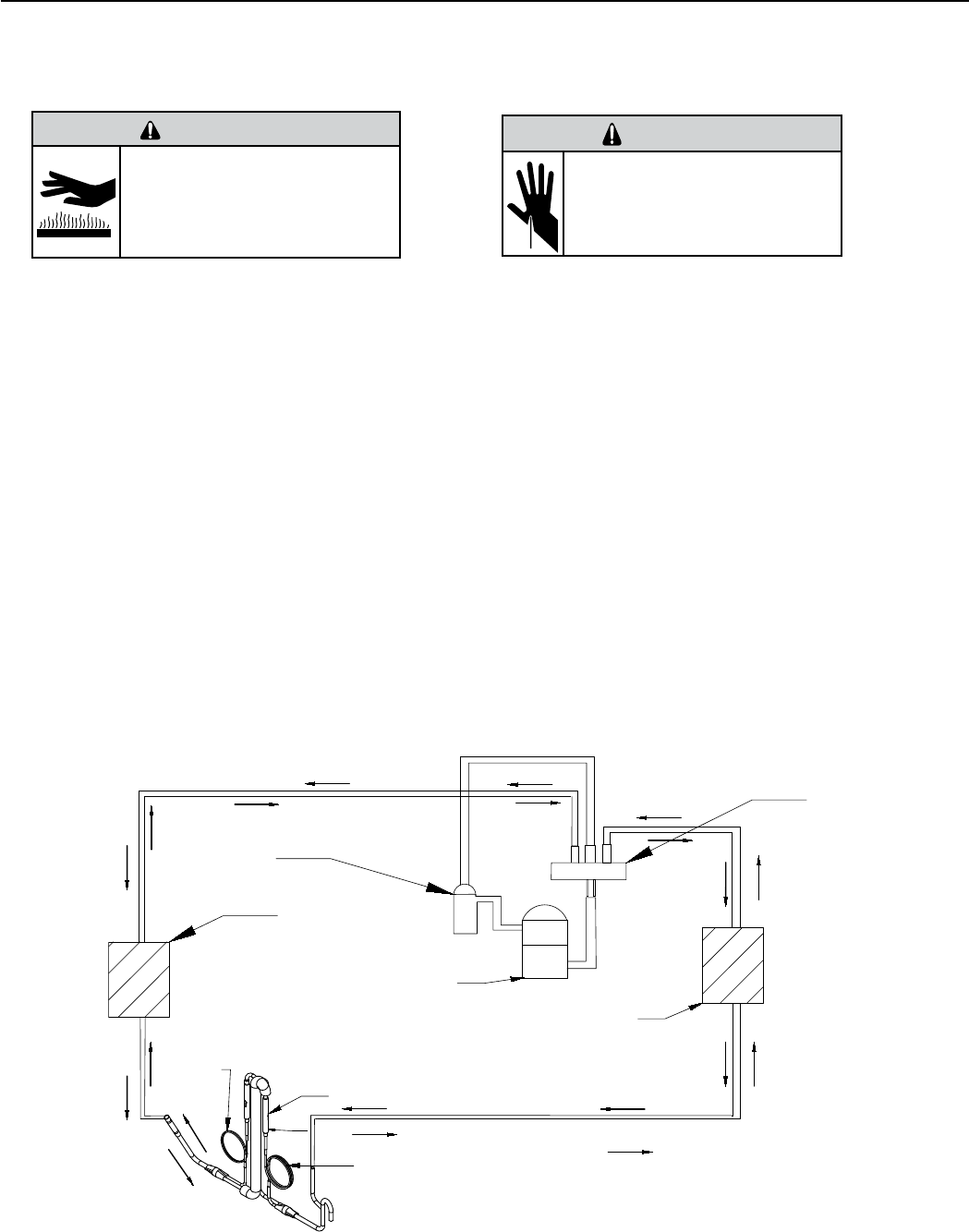
42 PB
CHECK VALVE OPERATION
Check Valves
2 check valves are installed on Heat pump units. They are pressure operated and used to direct the ow of refrigerant to the
proper capillary tube during either the heating or cooling cycle.
COOLING MODE
In the cooling mode of operation, high pressure liquid enters the check valve forcing the slide to close the opposite port (liquid
line) to the indoor coil. Refer to gure 701a. This directs the refrigerant through the cooling capillary tube to the indoor coil.
HEATING MODE
In the heating mode of operation, high pressure refrigerant enters the check valve from the opposite direction, closing the port
(liquid line) to the outdoor coil. The ow path of the refrigerant is then through the heating capillary to the outdoor coil.
Failure of the slide in the check valve to seat properly in either mode of operation will cause ooding of the cooling coil. This is
due to the refrigerant bypassing the heating or cooling capillary tube and entering the liquid line.
Test the Capillary Tube and Check Valve Assy
Allow unit to run for ten minutes before checking temps in order for unit to stabilize. Units tested at low ambient temps may
frost momentarily, but will retun to normal once unit pressure stabilizes. If frost does not stop after 10 minutes then a possible
restricition or low refrigerant charge may be present.
1. Check the capillary tube temperature by hand where the refrigerant enters the capillary tube. A partial restriction of
the capillary tube will be indicated by frost or freezing in that area.
2. If check valve fails closed or the capillary tube is fully restricted, then pressure will increase and pressure switch will
open if installed. If no pressure switch is installed, the unit will shut down due to the compressor overload opening.High
discharge temperature will be present at the compressor.
3. If check valve fails open the unit will continue to run, but there will be little to no cooling or heating.
In normal operation, the tube will be cooler on the side where the coolant is entering the cap tube then where it exits. If
the check valve is stuck open, there will be little difference in temperature.
COMPONENT TESTING
Capillary Tube and Check Valve Assy (Heat Pump Units)
BURN HAZARD
Proper safety procedures must be followed,
and proper protective clothing must be worn
when working with a torch.
Failure to follow these procedures could
result in moderate or serious injury.
WARNING
WARNING
CUT/SEVER HAZARD
Be careful with the sharp edges and corners.
Wear protective clothing and gloves, etc.
Failure to do so could result in serious injury.
Indoor
Coil
(Evaporator)
Accumulator
Compressor
Outdoor Coil
(Condensor)
Reversing Valve
Cap Tube
(Heating)
Cap Tube Cooling
Check Valve
Arrows Indicate Direction of Flow in Cooling Mode
Arrows Indicate Direction of Flow in Heating Mode
Figure 701a (Heat Pump Regerant Flow)
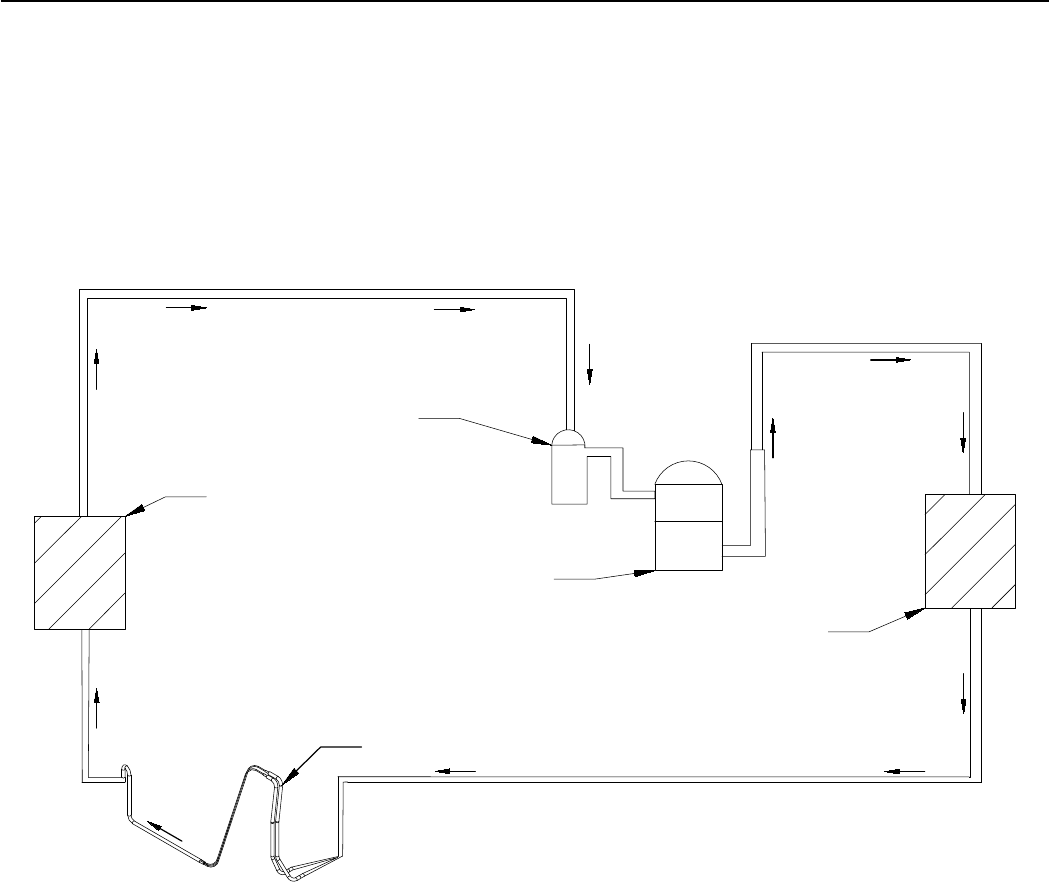
43 PB
COMPONENT TESTING
Capillary Tube Assy (Cool Only Units)
Test the Capillary Tube and Check Valve Assy
1. Check the capillary tube temperature by hand where the refrigerant enters the capillary tube. A partial restriction of
the capillary tube will be indicated by frost or freezing in that area.
2. If the capillary tube is fully restricted, then pressure will increase and pressure switch will open if installed. If
no pressure switch is installed, the unit will shut down due to the compressor overload opening. High discharge
temperature will be present at the compressor.
Indoor
Coil
(Evaporator)
Accumulator
Compressor
Outdoor Coil
(Condensor)
Cap Tube (Cooling Only)
Arrows Indicate Direction of Flow
Figure 701b (Cooling Only Regerant Flow)
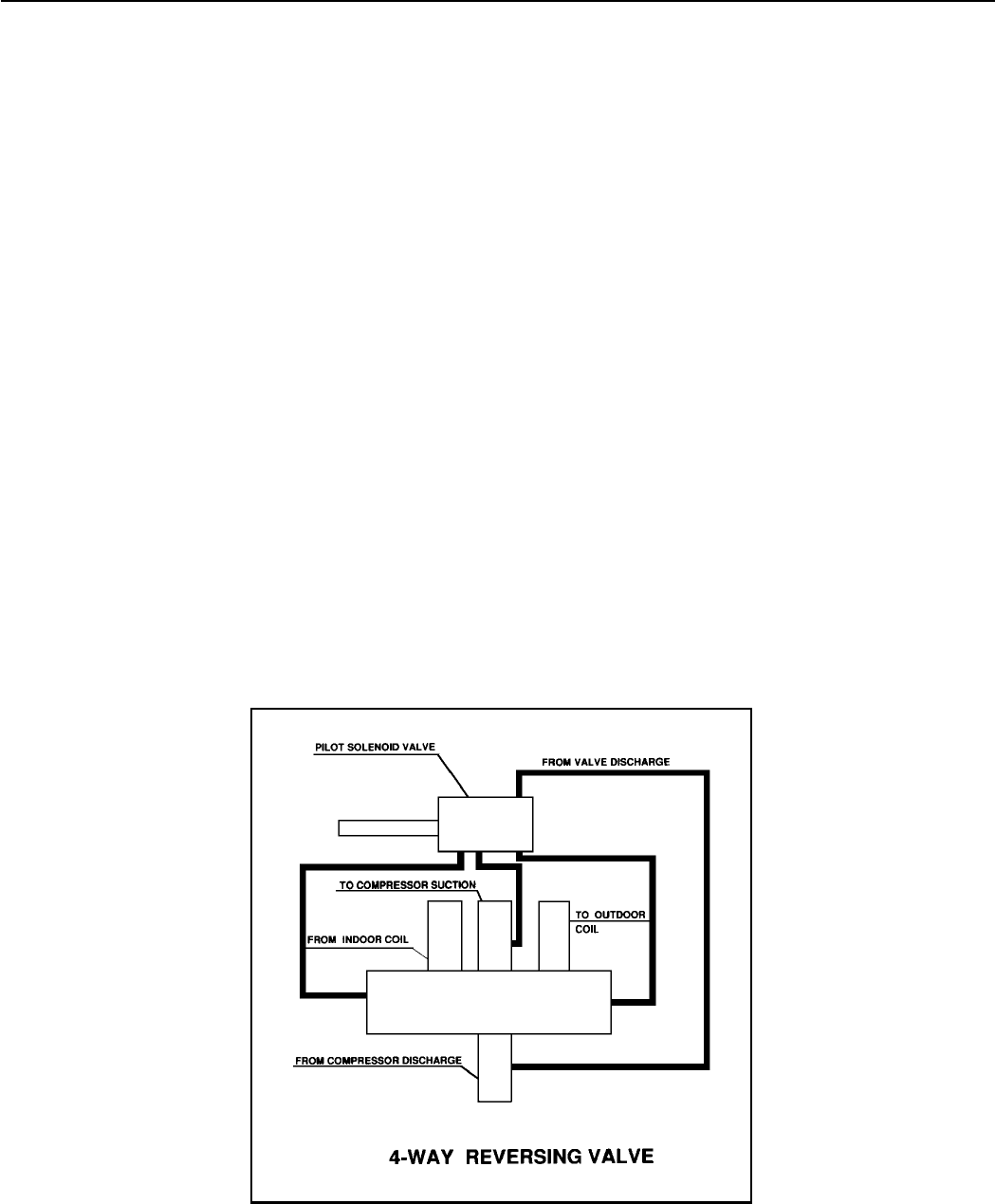
44 PB
COMPONENT TESTING
Reversing Valve Description And Operation
The Reversing Valve controls the direction of refrigerant ow to the indoor and outdoor coils. It consists of a
pressure-operated, main valve and a pilot valve actuated by a solenoid plunger. The solenoid is energized during
the heating cycle only. The reversing valves used in the RAC system is a 2-position, 4-way valve.
The single tube on one side of the main valve body is the high-pressure inlet to the valve from the compressor.
The center tube on the opposite side is connected to the low pressure (suction) side of the system. The other two
are connected to the indoor and outdoor coils. Small capillary tubes connect each end of the main valve cylinder
to the “A” and “B” ports of the pilot valve. A third capillary is a common return line from these ports to the suction
tube on the main valve body. Four-way reversing valves also have a capillary tube from the compressor discharge
tube to the pilot valve.
The piston assembly in the main valve can only be shifted by the pressure differential between the high and low
sides of the system. The pilot section of the valve opens and closes ports for the small capillary tubes to the main
valve to cause it to shift.
NOTE: System operating pressures must be near normal before valve can shift.
A
B
Figure 702 (Reversing Valve)
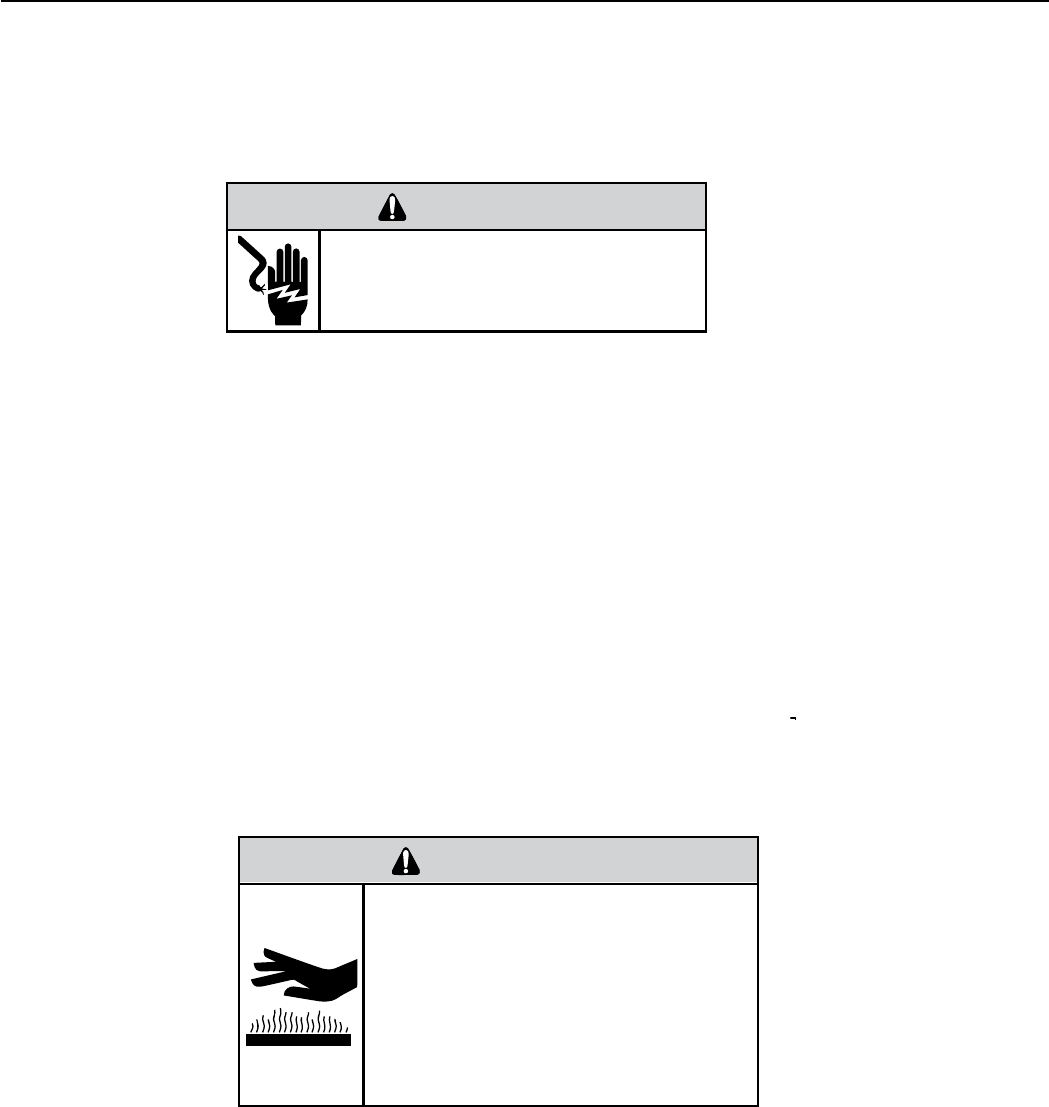
45 PB
COMPONENT TESTING
Testing The Reversing Valve Solenoid Coil
The solenoid coil is an electromagnetic type coil mounted on the reversing valve and is energized during the
operation of the compressor in the heating cycle.
1. Turn off high voltage electrical power to unit.
2. Unplug line voltage lead from reversing valve coil.
3. Check for electrical continuity through the coil. If you do not have continuity replace the coil.
4. Check from each lead of coil to the copper liquid line as it leaves the unit or the ground lug. There should be no
continuity between either of the coil leads and ground; if there is, coil is grounded and must be replaced.
5. If coil tests okay, reconnect the electrical leads.
6. Make sure coil has been assembled correctly.
NOTE: Do not start unit with solenoid coil removed from valve, or do not remove coil after unit is in operation.
This will cause the coil to burn out.
Touch Test in Heating/Cooling Cycle
WARNING
ELECTRIC SHOCK HAZARD
Disconnect power to the unit before
servicing. Failure to follow this warning
could result in serious injury or death.
BURN HAZARD
Proper safety procedures must be followed,
and proper protective clothing must be worn
when working with a torch.
Failure to follow these procedures could
result in moderate or serious injury.
WARNING
WARNING
BURN HAZARD
Certain unit components operate at
temperatures hot enough to cause burns.
Proper safety procedures must be followed,
and proper protective clothing must be
worn.
Failure to follow these procedures could
result in minor to moderate injury.
The only denite indications that the slide is in the mid-position is if all three tubes on the suction side of the valve
are hot after a few minutes of running time.
NOTE: If both tubes shown as hot or cool are not the same corresponding temperature, refer to gure 703, then
the reversing valve is not shifting properly.
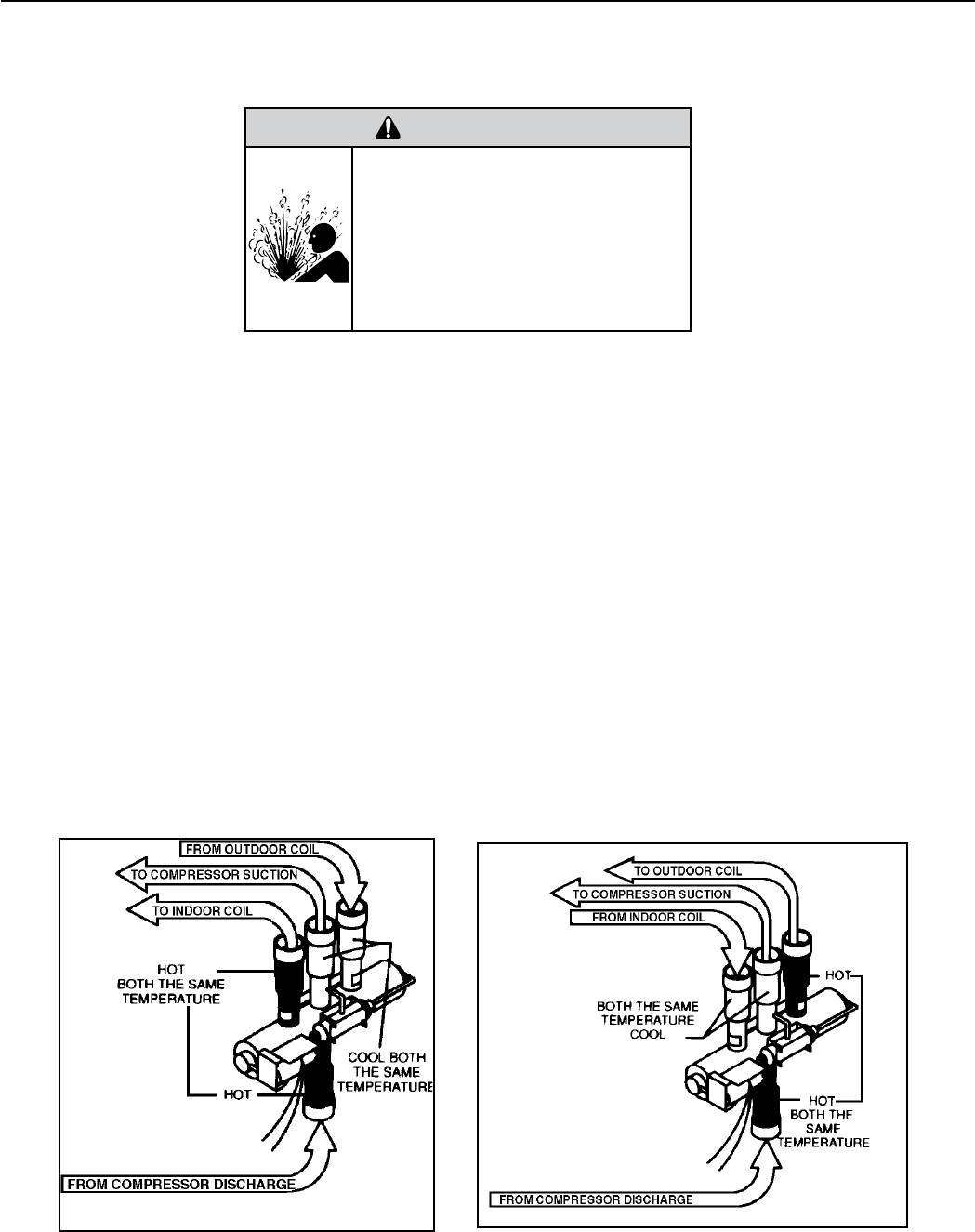
46 PB
NOTE: You must have normal operating pressures before the reversing valve can shift.
Check the operation of the valve by starting the system and switching the operation from “Cooling” to “Heating”
and then back to “Cooling”. Rapidly cycle. Do not hammer on valve.
Occasionally, the reversing valve may stick in the heating or cooling position or in the mid-position.
When sluggish or stuck in the mid-position, part of the discharge gas from the compressor is directed back to the
suction side, resulting in excessively high suction pressure.
Should the valve fail to shift from cooling to heating, block the air ow through the outdoor coil and allow the
discharge pressure to build in the system. Then switch the system from heating to cooling.
If the valve is stuck in the heating position, block the air ow through the indoor coil and allow discharge pressure
to build in the system. Then switch the system from heating to cooling.
Should the valve fail to shift in either position after increasing the discharge pressure, replace the valve.
Dented or damaged valve body or capillary tubes can prevent the main slide in the valve body from shifting.
If you determing this is the problem, replace the reversing valve.
After all of the previous inspections and checks have been made and determined correct, then perform the
“Touch Test” on the reversing valve.
COMPONENT TESTING
Checking The Reversing Valve
Reversing Valve in Heating Mode
WARNING
HIGH PRESSURE HAZARD
Sealed Refrigeration System contains refrigerant
and oil under high pressure.
Proper safety procedures must be followed,
and proper protective clothing must be worn
when working with refrigerants.
Failure to follow these procedures could
result in serious injury or death.
Figure 703 (Checking The Reversing Valve)
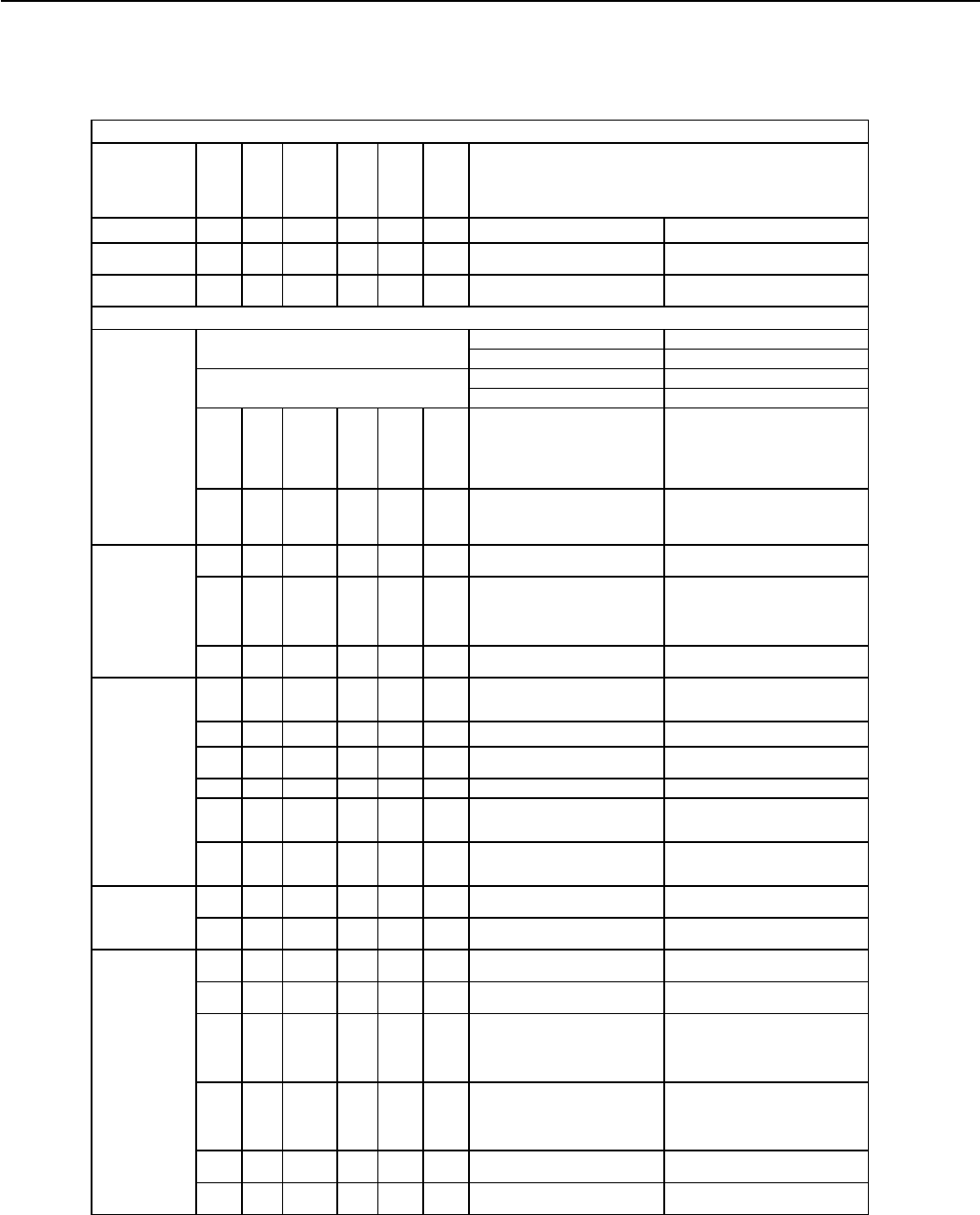
47 PB
COMPONENT TESTING
Touch Test Chart : To Service Reversing Valves
DISCHARGE TUBE
from Compressor
Tube to INSIDE
T
ube to INSIDE
Capillary Tube
RIGHT Pilot
Capillary Tube
Capillary Tube
LEFT Pilot
SUCTION
to Compressor
TUBE to
Compressor
Capillary Tube
COIL
14
COIL
NORMAL FUNCTION OF VALVE
VALVE
OPERATING
from Compressor
DISCHARGE TUBE
SUCTION TUBE
Tube to Indoor
COIL
Tube to OUTSIDE
LEFT Pilot
RIGHT Pilot
CONDITION
NOTES:
1 2 3 4 6 5 POSSIBLE CAUSES
* TEMPERATURE OF VALVE BODY
** WARMER THAN VALVE BODY
Hot
Normal Cooling
CORRECTIONS
Cool
Cool
as (2)
Hot
as (1)
*TVB TVB
Normal Heating
Hot Cool
Hot
as (1)
Cool
as (2)
*TVB TVB
MALFUNCTION OF VALVE
Valve will not
to heat.
shift from cool
Check Electrical circuit and coil
Repair electrical circuit. No voltage to coil.
Replace coil. Defective coil.
Check refrigeration charge
Repair leak, recharge system. Low charge.
Pressure differential too high. Recheck system.
Hot Cool
Cool,
as (2)
Hot,
as (1)
Hot *TVB Pilot valve okay. Dirt in one bleeder hole.
Piston cup leak
Deenergize solenoid, raise head pressure,
reenergize solenoid to break dirt loose.
If unsuccessful, remove valve, wash
out. Check on air before installing. If no
movement, replace valve, add strainer to
discharge tube, mount valve horizontally.
Valve will not
Stop unit. After pressures equalize, restart
with solenoid energized. If valve shifts,
reattempt with compressor running. If still
no shift, replace valve.
shift from cool
to heat.
Hot Cool
Cool,
as (2)
Hot,
as (1)
*TVB *TVB Clogged pilot tubes.
Raise head pressure, operate solenoid to
free. If still no shift, replace valve.
Hot Cool
Cool,
as (2)
Hot,
as (1)
Hot Hot
Both ports of pilot open. (Back seat port
did not close).
Cool Warm
Raise head pressure, operate solenoid
to free
partially clogged port. If still no shift,
replace valve.
Cool,
as (2)
Hot,
as (1)
*TVB Warm Defective Compressor. Replace compressor
Starts to shift
complete
reversal.
but does not
Hot Warm Warm Hot Hot *TVB
Check unit for correct operating pressures
and charge. Raise head pressure. If no
shift, use valve with smaller port.
Not enough pressure differential at start
of stroke or not enough fl
ow to maintain
pressure differential.
Replace valve Body damage.
Hot Warm Warm Hot Hot Hot Both ports of pilot open.
Raise head pressure, operate solenoid. If
no shift, use valve with smaller ports.
Replace valve Body damage. Hot *TVB Hot Hot Hot Hot
Hot Hot
Raise head pressure, operate solenoid. If
no shift, use valve with smaller ports.
Hot Hot
Valve hung up at mid-stroke. Pumping
volume of compressor not suffi cient to
maintain reversal.
Hot Hot Both ports of pilot open.
Apparent
Raise head pressure, operate solenoid.
If no
shift, replace valve.
leap in heat-
ing.
Hot Cool
Hot,
as (1)
Cool,
as (2)
*TVB *TVB Piston needle on end of slide leaking.
Hot Cool
Operate valve several times, then recheck.
If excessive leak, replace valve.
Hot,
as (1)
Cool,
as (2)
**WVB **WVB Pilot needle and piston needle leaking.
Operate valve several times, then recheck.
If excessive leak, replace valve.
Will not shift
cool.
from heat to
Hot Cool
Hot,
as (1)
Cool,
as (2)
*TVB *TVB Pressure differential too high.
Clogged pilot tube.
Stop unit. Will reverse during equalization
period. Recheck system
Hot
Raise head pressure, operate solenoid to
free dirt. If still no shift, replace valve.
Cool
Hot,
as (1)
Cool,
as (2)
Hot *TVB Dirt in bleeder hole.
Hot Cool
Hot,
as (1)
Cool,
as (2)
Hot
Raise head pressure, operate solenoid.
Remove valve and wash out. Check on air
before reinstalling, if no movement, replace
valve. Add strainer to discharge tube.
Mount valve horizontally.
Piston cup leak. *TVB
Hot Cool
Hot,
as (1)
Stop unit. After pressures equalize, restart
with solenoid deenergized. If valve shifts,
reattempt with compressor running. If it
still will not reverse while running, replace
the valve.
Cool,
as (2)
Replace valve. Defective pilot. Hot Hot
Warm Cool
Warm,
as (1)
Cool,
as (2)
Warm *TVB Defective compressor. Replace compressor
Figure 704 (Touch Test Chart)

48 PB
COMPONENT TESTING
Compressor Checks
Locked Rotor Voltage (L.R.V.) Test
Locked rotor voltage (L.R.V.) is the actual voltage available at the compressor under a stalled condition.
Single Phase Connections
Disconnect power from unit. Using a voltmeter, attach one lead of the meter to the run “R” terminal on the compressor and the
other lead to the common “C” terminal of the com-pressor. Restore power to unit.
Determine L.R.V.
Start the compressor with the volt meter attached; then stop the unit. Attempt to restart the compressor within a couple
of seconds and immediately read the voltage on the meter. The compressor under these conditions will not start and will
usually kick out on overload within a few seconds since the pressures in the system will not have had time to equalize. Voltage
should be at or above minimum voltage of 197 VAC, as specied on the rating plate. If less than minimum, check for cause of
inadequate power supply; i.e., incorrect wire size, loose electrical connections, etc.
Amperage (R.L.A) Test
The running amperage of the compressor is the most important of these readings. A running amperage higher than that
indicated in the performance data indicates that a problem exists mechanically or electrically.
Single Phase Running and L.R.A. Test
NOTE: Consult the specication and performance section for running amperage. The L.R.A. can also be found on the rating
plate.
Select the proper amperage scale and clamp the meter probe around the wire to the “C” terminal of the compressor.
Turn on the unit and read the running amperage on the meter. If the compressor does not start, the reading will indicate the
locked rotor amperage (L.R.A.).
Overloads
The compressor is equipped with either an external or internal overload which senses both motor amperage and winding
temperature. High motor temperature or amperage heats the overload causing it to open, breaking the common circuit within
the compressor. Heat generated within the compressor shell, usually due to recycling of the motor, is slow to dissipate. It may
take anywhere from a few minutes to several hours for the overload to reset.
Checking the Overloads
External Overloads VPAK 9, 12, and 18K BTUs
With power off, remove the leads from compressor terminals. If the compressor is hot, allow the overload to cool before
starting check. Using an ohmmeter, test continuity across the terminals of the external overload. If you do not have continuity;
this indicates that the overload is open and must be replaced.
Internal Overloads VPAK 24k BTUs
The overload is embedded in the motor windings to sense the winding temperature and/or current draw. The overload is
connected in series with the common motor terminal.
Should the internal temperature and/or current draw become excessive, the contacts in the overload will open, turning off the
compressor. The overload will automatically reset, but may require several hours before the heat is dissipated.
Checking the Internal Overload
WARNING: Make sure Compressor is cool to the touch prior to OHMs testing.
1. With no power to unit, remove the leads from the compressor terminals.
2. Using an ohmmeter, test continuity between terminals
C-S and C-R. If no continuity, the compressor overload is open and the compressor must be replaced.
WARNING
ELECTRIC SHOCK HAZARD
Turn off electric power before service or
installation.
All electrical connections and wiring MUST be
the National Electrical Code and all local codes
which have jurisdiction.
Failure to do so can result in personal injury or
death.
BURN HAZARD
Proper safety procedures must be followed,
and proper protective clothing must be worn
when working with a torch.
Failure to follow these procedures could
result in moderate or serious injury.
WARNING
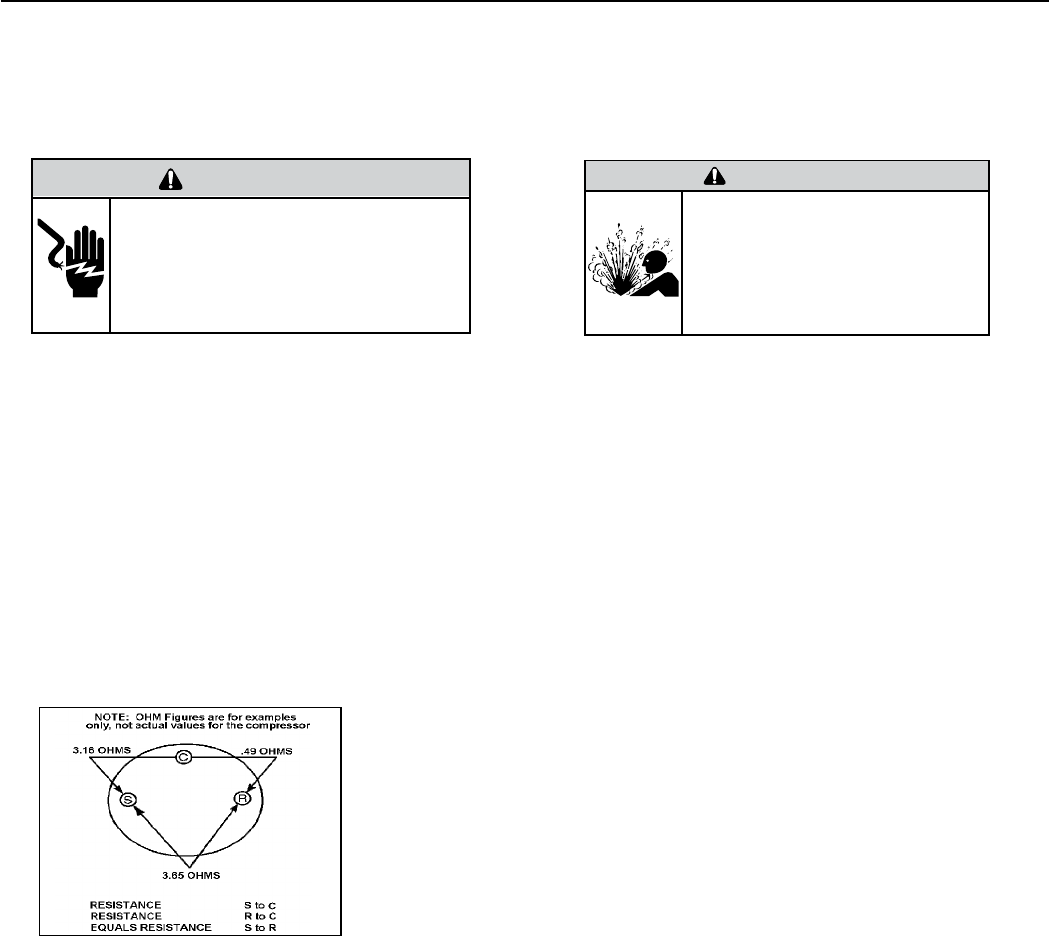
49 PB
WARNING
ELECTRIC SHOCK HAZARD
Turn off electric power before service or
installation. Extreme care must be used, if it
becomes necessary to work on equipment with
power applied.
Failure to do so could result in serious injury or
death.
Single Phase Resistance Test
Remove the leads from the compressor terminals and set the ohmmeter on the lowest scale (R x 1).
Touch the leads of the ohmmeter from terminals common to start (“C” to “S”). Next, touch the leads of the ohmmeter from
terminals common to run (“C” to “R”).
Add values “C” to “S” and “C” to “R” together and check resistance from start to run terminals (“S” to “R”). Resistance “S” to
“R” should equal the total of “C” to “S” and “C” to “R.”
In a single phase PSC compressor motor, the highest value will be from the start to the run connections (“S” to “R”). The next
highest resistance is from the start to the common connections (“S” to “C”). The lowest resistance is from the run to common.
(“C” to “R”) Before replacing a compressor, check to be sure it is defective.
GROUND TEST
Use an ohmmeter set on its highest scale. Touch one lead to the compressor body (clean point of contact as a good connection
is a must) and the other probe in turn to each compressor terminal. If a reading is obtained the compressor is grounded and
must be replaced.
Check the complete electrical system to the compressor and compressor internal electrical system, check to be certain that
compressor is not out on internal overload.
Complete evaluation of the system must be made whenever you suspect the
compressor is defective. If the compressor has been operating for sometime, a
careful examination must be made to determine why the compressor failed.
Many compressor failures are caused by the following conditions:
1.Improper air ow over the evaporator.
2.Overcharged refrigerant system causing liquid to be returned to the
compressor.
3.Restricted refrigerant system.
4.Lack of lubrication.
5.Liquid refrigerant returning to compressor causing oil to be washed out of
bearings.
6.Noncondensables such as air and moisture in the system. Moisture is
extremely destructive to a refrigerant system.
7.Capacitor.
CHECKING COMPRESSOR EFFICIENCY
The reason for compressor inefciency is normally due to broken or damaged suction and/or discharge valves, reducing the
ability of the compressor to pump refrigerant gas.
NOTE: Before installing valves and gauges, check the compressor discharge temperature and compressor current, Low
compressor amperage combined with low discharge temperature is an indication that the compressor might be faulty,
This condition can be checked as follows:
1. Install a piercing valve on the suction and discharge or liquid process tube.
2. Attach gauges to the high and low sides of the system.-
3. Start the system and run a “cooling or heating perfor mance test.” If test shows:
A. Below normal high side pressure
B. Above normal low side pressure
C. Low temperature difference across coil
The compressor valves are faulty - replace the compressor.
WARNING
HIGH PRESSURE HAZARD
Sealed Refrigeration System contains refrigerant
and oil under high pressure.
Proper safety procedures must be followed,
and proper protective clothing must be worn
when working with refrigerants.
Failure to follow these procedures could
result in serious injury or death.
Figure 705 (Resistance Chart)
COMPONENT TESTING
Compressor Checks
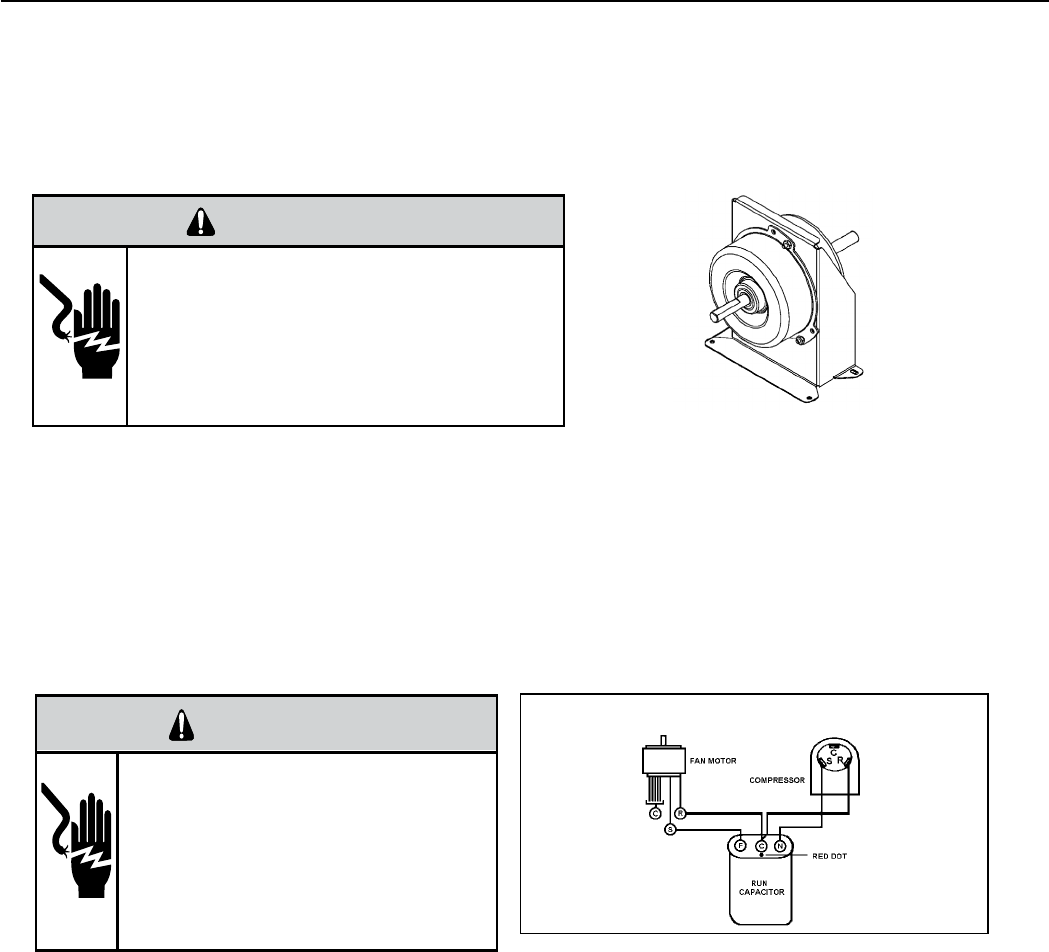
50 PB
COMPONENTS TESTING
Fan Motor
A single phase permanent split capacitor motor is used to drive the evaporator blower and condenser fan. A self-
resetting overload is located inside the motor to protect against high temperature and high amperage conditions.
WARNING
ELECTRIC SHOCK HAZARD
Turn off electric power before service or
installation. Extreme care must be used, if it
becomes necessary to work on equipment with
power applied.
Failure to do so could result in serious injury or
death.
Blower / Fan Motor Test
1. Visually inspect the motor’s wiring, housing etc., and determine that the capacitor is serviceable.
2. Make sure the motor has cooled down.
3. Disconnect the fan motor wires from the control board.
4. Test for continuity between the windings also, test to ground.
5. If any winding is open or grounded replace the motor.
Capacitors
WARNING
ELECTRIC SHOCK HAZARD
Turn off electric power before service or
installation. Extreme care must be used, if it
becomes necessary to work on equipment with
power applied.
Failure to do so could result in serious injury or
death.
Many motor capacitors are internally fused. Shorting the terminals will blow the fuse, ruining the capacitor. A 20,000 ohm 2
watt resistor can be used to discharge capacitors safely. Remove wires from capacitor and place resistor across terminals.
When checking a dual capacitor with a capacitor analyzer or ohmmeter, both sides must be tested.
Capacitor Check
The meter will show whether the capacitor is “open” or “shorted.” It will tell whether the capacitor is within its micro
farads rating and it will show whether the capacitor is operating at the proper power-factor percentage. The instrument will
automatically discharge the capacitor when the test switch is released.
Capacitor Connections
The starting winding of a motor can be damaged by a shorted and grounded running capacitor. This damage usually can be
avoided by proper connection of the running capacitor terminals.
From the supply line on a typical 230 volt circuit, a 115 volt potential exists from the “R” terminal to ground through a possible
short in the capacitor. However, from the “S” or start terminal, a much higher potential, possibly as high as 400 volts, exists
because of the counter EMF generated in the start winding. Therefore, the possibility of capacitor failure is much greater
when the common terminal is connected to the “S” or start terminal. The common terminal should always be connected to the
supply line, or “R” terminal, never to the “S” terminal.
When connected properly, a shorted or grounded running capacitor will result in a direct short to ground from the “R”
terminal and will blow the line fuse. The motor protector will protect the main winding from excessive temperature.
Dual Rated Run Capacitor Hook-up
Figure 706 (Blower/ Fan Motor)
Figure 707 Dual Rated Capacitor Hook-Up

51 PB
COMPONENTS TESTING
Heating Element and Limit Switch
WARNING
ELECTRIC SHOCK HAZARD
Turn off electric power before service or
installation. Extreme care must be used, if it
becomes necessary to work on equipment with
power applied.
Failure to do so could result in serious injury or
death.
Heating Element
Example
All heat pumps and electric heat models are equipped with a heating element and a limit switch (bimetal thermostat). The limit
switches are in series with the element and will interrupt the power at a designed temperature.
Should the blower motor fail, lter become clogged or air-ow be restricted etc., the high limit switch will open and interrupt
the power to the heater before reaching an un-safe temperature condition.
Heater Elements And Limit Switches’ Specications
VPAK 9K, 12K and 18K BTUs Models:
2.5 KW, 230 V, Resistance 18.61 Ohms + - 5%.
Has 1 Limit Switch, Opens at 120° F, Closes at 90° F,
It has a One Time Open Temp. of 145° F.
3.4 KW, 230 V, Resistance 13.68 Ohms + - 5%.
Has 1 Limit Switch, Opens at 120° F, Closes at 90° F,
It has a One Time Open Temp. of 145° F.
5 KW, 230 V, Resistance 9.31 Ohms + - 5%.
Has 1 Limit Switch, Opens at 130° F, Closes at 100° F, It has a One Time Open Temp. of 155° F.
VPAK 24K BTUs Models:
2.5 KW, 265 V, Resistance 24.86 Ohms + - 5%.
Has 2 Limit Switches, Primary Opens at 120° F,
Closes at 90° F, Secondary’s Open Temp. is 145° F.
3.4 KW, 265 V, Resistance 13.68 Ohms + - 5%.
Has 2 Limit Switches, Primary Opens at 120° F,
Closes at 90° F, Secondary’s Open Temp. is 145° F.
5 KW, 265 V, Resistance 9.31 Ohms + - 5%.
Has 2 Limit Switches, Primary Opens at 130° F,
Closes at 100° F, Secondary’s Open Temp. is 155° F.
7.5 KW, 265 V (composed of 2, 3.7 KW Elements) Each Has a Resistance of 16.47 Ohms + - 5%.
Each Has 2 Limit Switches, Primary Opens at 155° F, Closes at 125° F With a 1 time Open Temp. of 200° F. Secondary Limit’s
Open Temp. is 200° F.
Figure 708 (Heating Element)

52 PB
COMPONENTS TESTING
Heating Element and Limit Switch
VPAk 24K models
2.5 KW, 230 V, Resistance 18.61 Ohms + - 5%.
Has 1 Limit Switch, Opens at 155° F, Closes at 125° F,
It has a One Time Open Temp. of 200° F.
3.4 KW, 230 V, Resistance 13.68 Ohms + - 5%.
Has 1 Limit Switch, Opens at 155° F, Closes at 125° F,
It has a One Time Open Temp. of 200° F.
5 KW, 230 V, Resistance 9.31 Ohms + - 5%.
Has 1 Limit Switch, Opens at 155° F, Closes at 125° F, It has a One Time Open Temp. of 200° F.
VPAK 24K BTUs Models:
7.5 KW, 230 V (composed of 2, 3.7 KW Elements) Each Has a Resistance of 12.41 Ohms + - 5%.
Each Has 2 Limit Switches, Primary Opens at 165° F, Closes at 135° F With a 1 time Open Temp. of 210° F. Secondary Limit’s
Open Temp. is 200° F.
10 KW, 230 V (composed of 2, 5 KW Elements)
Each Has a Resistance of 9.31 Ohms + - 5%.
Each Has 2 Limit Switches, Primary Opens at 165° F, Closes at 135° F With a 1 time Open Temp. of 210° F. Secondary Limit’s
Open Temp. is 200° F.
2.5 KW, 265 V, Resistance 24.71 Ohms + - 5%.
Has 2 Limit Switches, Primary Opens at 155° F,
Closes at 125° F, Secondary’s Open Temp. is 200° F.
3.4 KW, 265 V, Resistance 18.17 Ohms + - 5%.
Has 2 Limit Switches, Primary Opens at 155° F,
Closes at125° F, Secondary’s Open Temp. is 200° F.
5 KW, 265 V, Resistance 12.35 Ohms + - 5%.
Has 2 Limit Switches, Primary Opens at 165° F,
Closes at 135° F, Secondary’s Open Temp. is 200° F.
7.5 KW, 265 V (composed of 2, 3.7 KW Elements) Each Has a Resistance of 16.47 Ohms + - 5%.
Each Has 2 Limit Switches, Primary Opens at 155° F, Closes at 125° F With a 1 time Open Temp. of 200° F. Secondary Limit’s
Open Temp. is 200° F.
10 KW, 265 V (composed of 2, 5 KW Elements)
Each Has a Resistance of 12.35 Ohms + - 5%.
Each Has 2 Limit Switches, Primary Opens at 155° F, Closes at 125° F With a 1 time Open Temp. of 200° F. Secondary Limit’s
Open Temp. is 200° F.
NOTE: Always replace with an exact replacement.
Testing The Heating Element
Testing of the elements can be made with an ohmmeter across the terminals after the connecting wires have been removed.

53 PB
COMPONENTS TESTING
WARNING
ELECTRIC SHOCK HAZARD
Turn off electric power before service or
installation. Extreme care must be used, if it
becomes necessary to work on equipment with
power applied.
Failure to do so could result in serious injury or
death.
Drain Pan Valve
During the cooling mode of operation, condensate which
collects in the drain pan is picked up by the con-denser
fan blade and sprayed onto the condenser coil. This
assists in cooling the refrigerant plus evaporating the
water.
During the heating mode of operation, it is necessary that water be removed to prevent it from freezing during cold outside
temperatures. This could cause the condenser fan blade to freeze in the accumulated water and prevent it from turning.
To provide a means of draining this water, a bellows type drain valve is installed over a drain opening in the base pan.
This valve is temperature sensitive and will open when the outside temperature reaches 40°F. The valve will close gradually as
the temperature rises above 40°F to fully close at 60°F.
To test the drain pan valve;
1) Place a pack of ice on the capillary
2) Ensure that the valve opens as it cools down.
3) remove the pack of ice.
4) Ensure that the valve closes fully as the valve warms back up.
Bellows Assembly
Drain Pan Valve
Figure 709 Drain Pan Valve
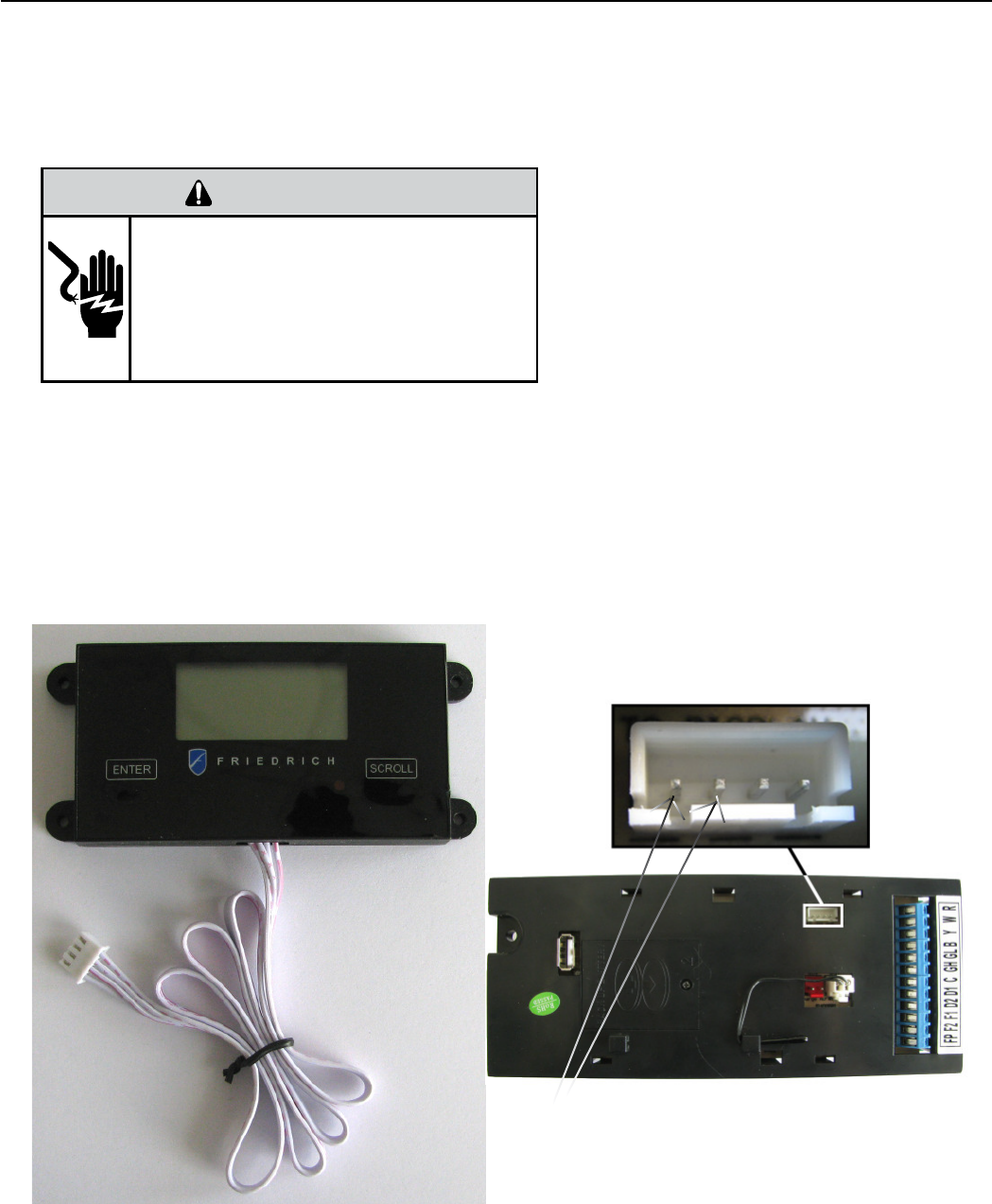
54 PB
COMPONENTS TESTING
Testing the Diagnostic Service Module
Testing the Electronic Control Board
WARNING
ELECTRIC SHOCK HAZARD
Turn off electric power before service or
installation. Extreme care must be used, if it
becomes necessary to work on equipment with
power applied.
Failure to do so could result in serious injury or
death.
If the Diagnostic Service Module does not turn on:
1. Make sure there is 208/230 VAC to the unit and that it is turned on.
2. Disconnect the diagnostic service module’s wire harness on the control board.
3. Using a voltmeter, check the fi rst two pins to the left of the female connector (see picture below).
There should be up to 5VDC.
4. If there is no voltage, replace the electronic control board.
5. If there is voltage, check the wire harness and connections at the electronic control board and the diagnostic
service module.
6. IF THE CONNECTIONS AND THE WIRE HARNESS ARE GOOD, REPLACE THE DIAGNOSTIC SERVICE MODULE.
FIGURE 711 (DIAGNOSTIC SERVICE MODULE)
FIGURE 712 (SERVICE MODULE CONNECTOR)
TEST HERE UP TO 5VDC.
IF NO VOLTAGE, REPLACE BOARD.
IF THERE IS 5VDC, CHECK CONNECTIONS AND CABLE.
IF OK, REPLACE SERVICE MODULE.
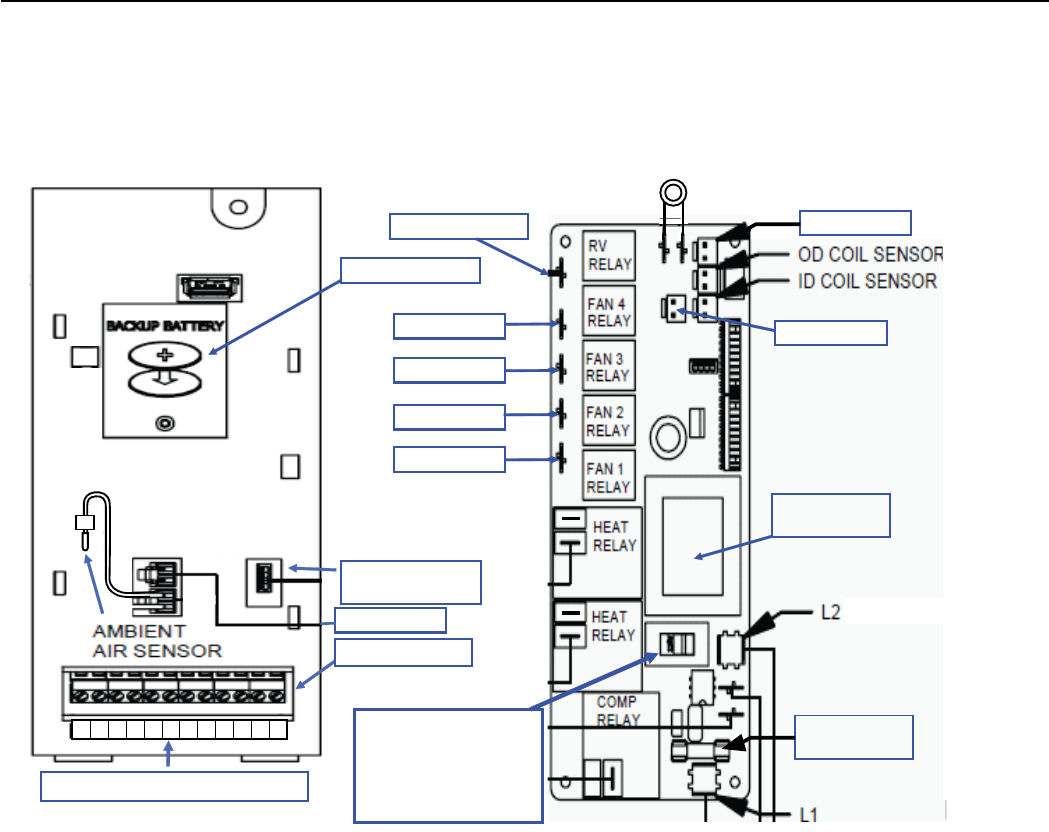
55 PB
COMPONENT TESTING
Electronic Control Board Components Identification And Testing
Front
VPAK 24K
High Pressure Switch
Back
Reversing Valve
Not Used
Not Used
High Speed
Not Used
Low Speed
Not Used
(Blue)
(Green)
Not Used
Transformer
115/230 Volts
Fuse 10 Amps
250 VAC
Transformer voltage
Selector Switch
115/230 Volts
Ensure it is set at
230VAC
Diagnostic
Servicer Module
Not Used
T-stat Terminals
1. Test for power at L1 and L2 for 208/230 VAC. (Ensure the transformer voltage selector switch is set for 230 VAC)
2. TEST THE 10 AMP/250 VAC FUSE FOR CONTINUITY.
FOR THE FOLLOWING TESTS, ENSURE THE UNIT IS IN THE APPROPRIATE SETTINGS FOR THE TEST BEING PERFORMED. ENSURE
THERE ARE NO ERROR CODES ACTIVE.
3. Testing the compressor relay and heat relays:
Test for power in and power out. If there is power in and no power out, replace the electronic control board.(208/230 to L2)
4. Testing the fan and reversing valve relays:
Test for power at the reversing valve and fan relays 1 or 3. (208/230 to L2)
5. Testing the transformer:
Test the low voltage terminal strip at:
R and C for 24 VAC
F2 and F1 for 24 VAC
D2 and D1 for 24 VAC
Test the service module connector for 5 VDC (see prior page)
Test the connectors for the thermistors for up to 5 VDC
If there is no voltage at any of the above, replace electronic control board.
6. Testing the thermistors:
Disconnect the thermistor and test for resistance value (see figure 710).
7. Testing the high pressure switch (VPAK 18K, 24K only).
Test for 24 VAC at board, if there is no voltage, replace the electronic control.
Test the pressure switch for continuity, if none, replace it (switch is normally closed).
FIGURE 713 (ECB ID AND TESTING)
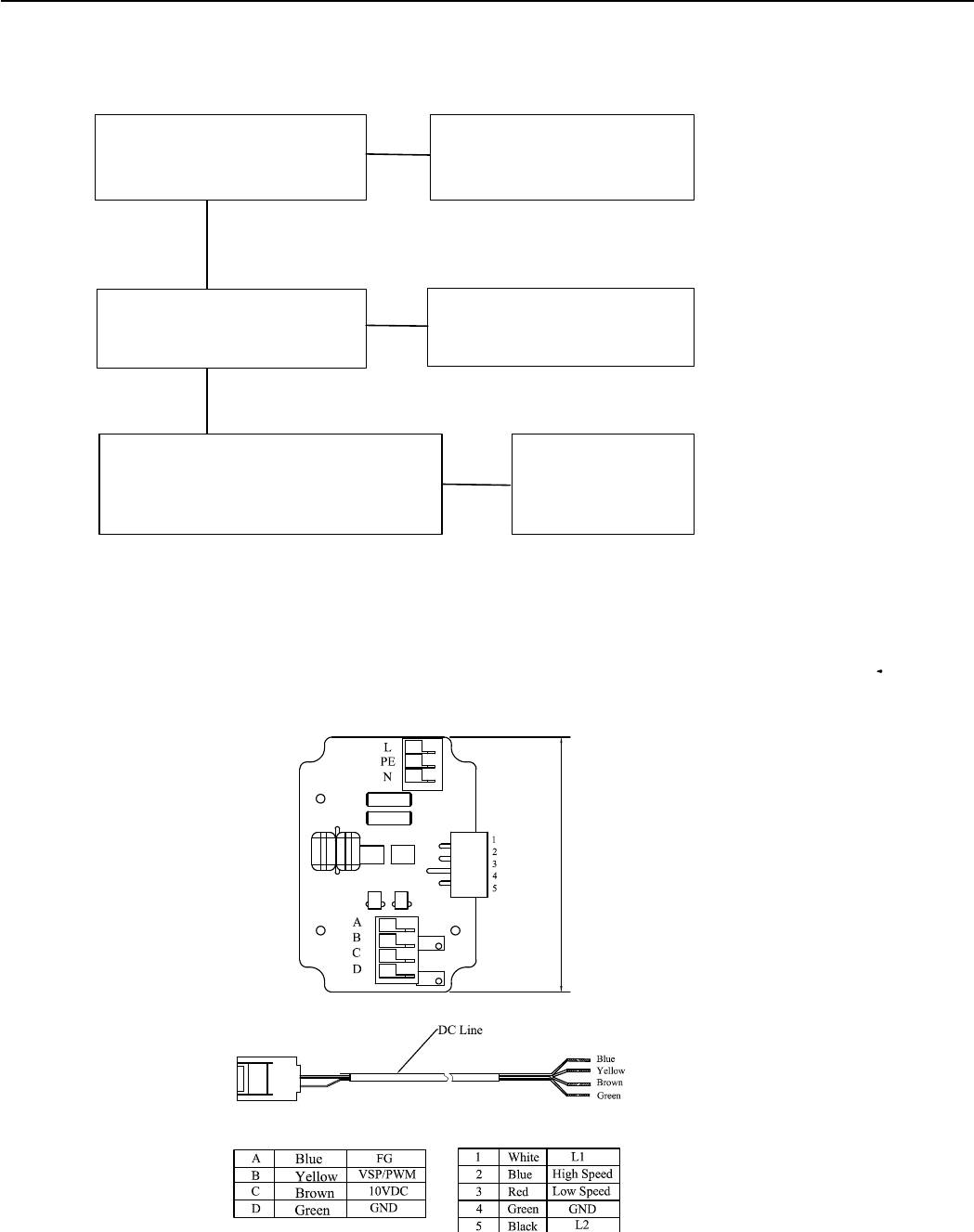
56 PB
COMPONENT TESTING
24k Indoor Blower Motor
Check for appropriate
Line Voltage at L and N
No
Trace wiring to nd problem
Yes
Check for 10 vdc at green and
brown wire at pins C and D.
Indoor Blower Circuit Board
No
engage fan in either High or Low speed.
Values between B and D should be:
Low Speed - 6.37VDC +/- 0.05
High Speed - 8.12VDC +/- 0.05
Yes
No
If no voltage is present, remove
harness and jump C and D. If fan
runs, blower circuit board is bad.
Replace Fan
FIGURE 714 (INDOOR BLOWER MOTOR TESTING)
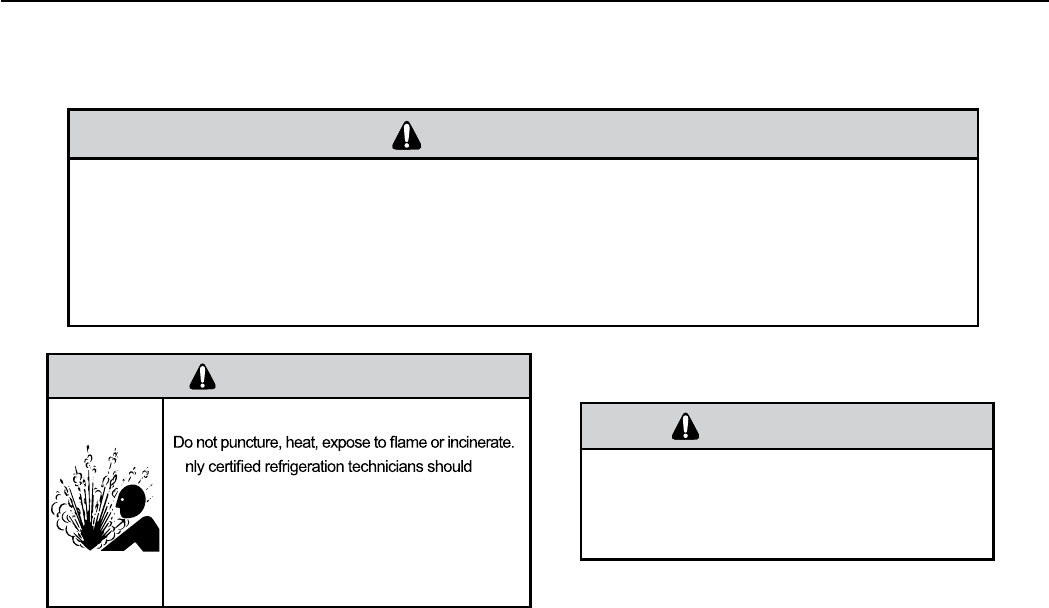
57 PB
R-410A SEALED SYSTEM REPAIR
WARNING
Refrigeration system under high pressure
O
service this equipment.
R410A systems operate at higher pressures than
R22 equipment. Appropriate safe service and
handling practices must be used.
Only use gauge sets designed for use with R410A.
Do not use standard R22 gauge sets.
The following is a list of important considerations
when working with R-410A equipment
1. R-410A pressure is approximately 60% higher than R-22
pressure.
2. R-410A cylinders must not be allowed to exceed 125 F,
they may leak or rupture.
3. R-410A must never be pressurized with a mixture of air, it
may become
ammable.
4. Servicing equipment and components must be
specically designed for use with R-410A and dedicated to
prevent contamination.
5. Manifold sets must be equipped with gauges capable of
reading 750 psig (high side) and 200 psig (low side), with a
500-psig low-side retard.
6. Gauge hoses must have a minimum 750-psig service
pressure rating
7. Recovery cylinders must have a minimum service
pressure rating of 400 psig, (DOT 4BA400 and DOT BW400
approved cylinders).
8. POE (Polyol-Ester) lubricants must be used with R-410A
equipment.
9. To prevent moisture absorption and lubricant
contamination, do not leave the refrigeration system open
to the atmosphere longer than 1 hour.
10. Weigh-in the refrigerant charge into the high side of the
system.
11. Introduce liquid refrigerant charge into the high side of
the system.
12. For low side pressure charging of R-410A, use a
charging adaptor.
13. Use industry standard R-410A lter dryers.
EQUIPMENT REQUIRED:
1. Eletrical Multimeter
2. E.P.A. Approved Refrigerant Recovery System
3. Vacuum Pump (capable of 200 microns or less
vacuum.)
4. Acetylene torch.
5. Electronic Halogen Leak Detector capable of detecting
HFC (Hydrouorocarbon) refrigerants.
6. R410A Refrigerant Manifold
7. 1/4” Braze-type Access Ports
8. Pinch Tool
9. Digital Refrigerant Scale
10. Vacuum Gauge - (0 - 1000 microns)
11. Facilities for owing nitrogen through refrigeration
tubing during all brazing processes.
EQUIPMENT MUST BE CAPABLE OF:
1. Recovering refrigerant to EPA required levels.
2. Evacuation from both the high side and low side of the
system simultaneously.
3. Introducing refrigerant charge into high side of the
system.
4. Accurately weighing the refrigerant charge introduced
into the system.
WARNING
EPA 608 Warning:
It is a violation of the environmental Protection
Agency, Clause 608A, to service refrigeration
systems without proper certication
WARNING
Use approved standard refrigerant recovering procedures and equipment to relieve high pressure before opening system for repair.
Do not allow liquid refrigerant to contact skin. Direct contact with liquid refrigerant can result in minor to moderate injury.
Be extremely careful when using an oxy-acetylene torch. Direct contact with the torch’s flame or hot surfaces can cause serious burns.
Make certain to protect personal and surrounding property with fire proof materials and have a fire extinguisher at hand while using a torch.
Provide adequate ventilation to vent off toxic fumes, and work with a qualified assistant whenever possible.
.
Always use a pressure regulator when using dry nitrogen to test the sealed refrigeration system for leaks, flushing etc.
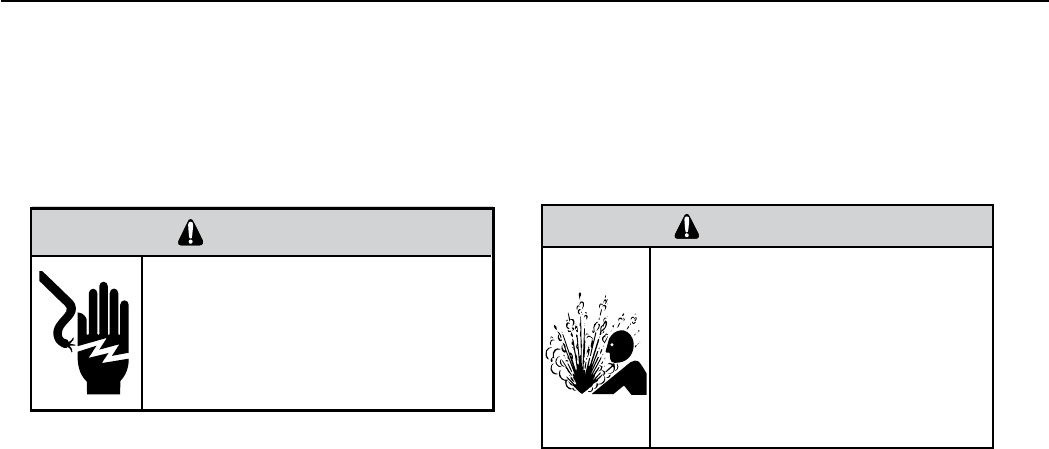
58 PB
R-410A SEALED SYSTEM REPAIRS
Refrigerant Charging
WARNING
RISK OF ELECTRIC SHOCK
Unplug and/or disconnect all electrical power
to the unit before performing inspections,
maintenances or service.
Failure to do so could result in electric shock,
serious injury or death.
WARNING
HIGH PRESSURE HAZARD
Sealed Refrigeration System contains refrigerant
and oil under high pressure.
Proper safety procedures must be followed,
and proper protective clothing must be worn
when working with refrigerants.
Failure to follow these procedures could
result in serious injury or death.
NOTE: Always weigh in refrigerant based on the model nameplate.
NOTE: Because the refrigerant system is a sealed system, service process tubes will have to be installed. First
install a line tap and remove refrigerant from system. Make necessary sealed system repairs and vacuum system.
Crimp process tube line and solder end shut. Do not leave a service valve in the sealed system.
Proper refrigerant charge is essential to proper unit operation. Operating a unit with an improper refrigerant
charge will result in reduced performance (capacity) and/or efciency. Accordingly, the use of proper charging
methods during servicing will insure that the unit is functioning as designed and that its compressor will not be
damaged.
NOTE:Factory sealed units will not be overcharged
Too much refrigerant (overcharge) in the system is just as bad (if not worse) than not enough refrigerant
(undercharge). they both can be the source of certain compressor failures if they remain uncorrected for any
period of time. Quite often, other problems (such as low air ow across evaporator, etc.) are misdiagnosed as
refrigerant charge problems. The refrigerant circuit diagnosis chart will assist you in properly diagnosing the
systems.
An overcharged unit will return liquid refrigerant (slugging) back to the suction side of the compressor eventually
causing a mechanical failure within the compressor. This mechanical failure can manifest itself as valve failure,
bearing failure, and/or other mechanical failure. The specic type of failure will be inuenced by the amount of
liquid being returned, and the length of time the slugging continues.
Not enough refrigerant (undercharge) on the other hand, will cause the temperature of the suction gas to
increase to the point where it does not provide sufcient cooling for the compressor motor. When this occurs, the
motor winding temperature will increase causing the motor to overheat and possibly cycle open the compressor
overload protector. Continued overheating of the motor windings and/or cycling of the overload will eventually
lead to compressor motor or overload failure.
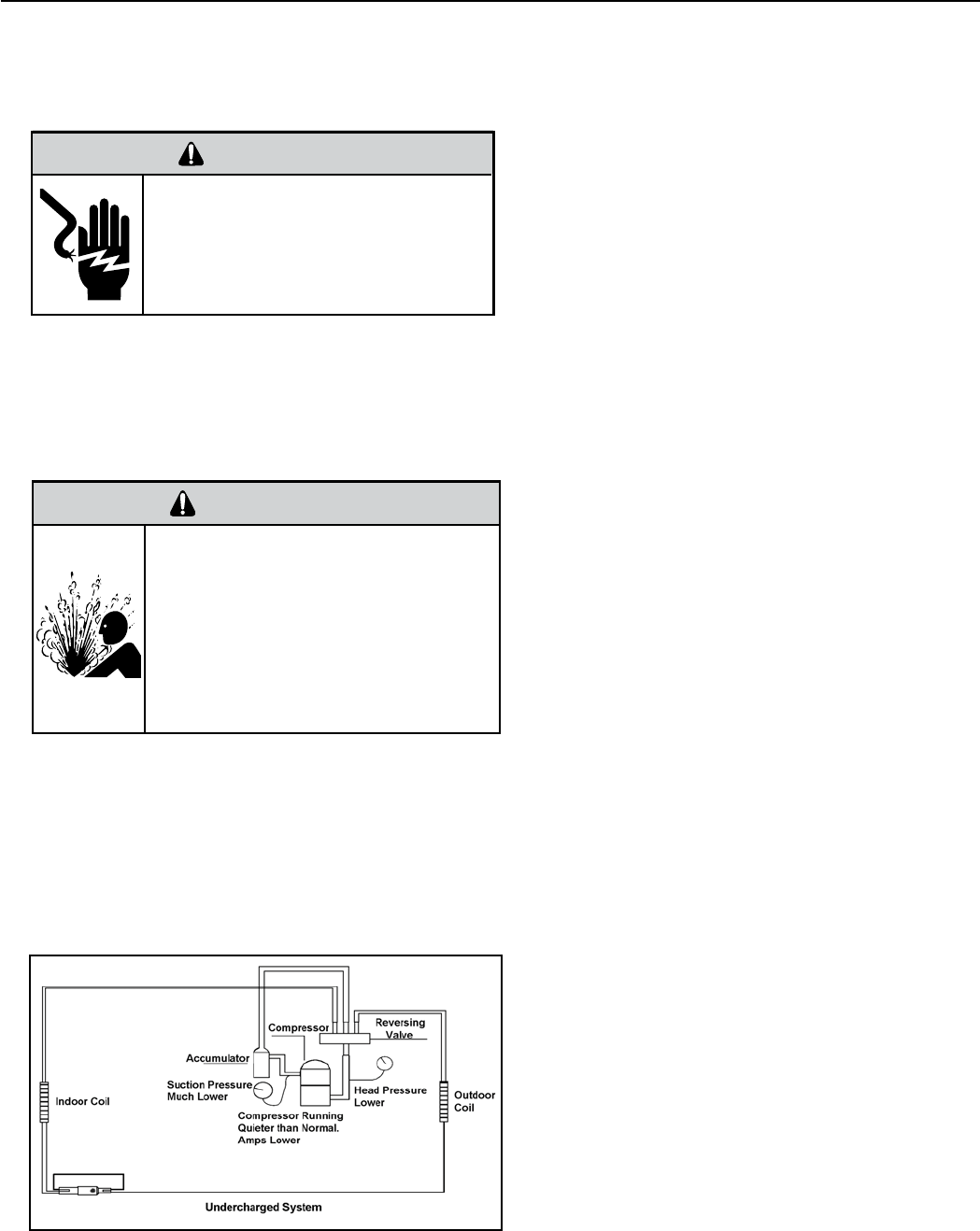
59 PB
R-410A SEALED SYSTEM REPAIRS
WARNING
RISK OF ELECTRIC SHOCK
Unplug and/or disconnect all electrical power
to the unit before performing inspections,
maintenances or service.
Failure to do so could result in electric shock,
serious injury or death.
WARNING
HIGH PRESSURE HAZARD
Sealed Refrigeration System contains refrigerant
and oil under high pressure.
Proper safety procedures must be followed,
and proper protective clothing must be worn
when working with refrigerants.
Failure to follow these procedures could
result in serious injury or death.
Undercharged Refrigerant Systems
NOTE: Ensure fan is on high speed during testing.
An undercharged system will result in poor perfor-
mance (low pressures, etc.) in both the heating and
cooling cycle.
Whenever you service a unit with an undercharge of
refrigerant, always suspect a leak. The leak must be
repaired before charging the unit.
To check for an undercharged system, turn the unit
on, allow the compressor to run long enough to
establish working pressures in the system (15 to 20
minutes).
During the cooling cycle you can listen carefully at
the exit of the metering device into the evaporator;
an intermittent hissing and gurgling sound indicates
a low refrigerant charge. Intermittent frosting and
thawing of the evaporator is another indication of a
low charge, however, frosting and thawing can also
be caused by insufcient air over the evaporator or
partial restriction in the refrigeration system besides
the metering device..
Checks for an undercharged system can be made at
the compressor. If the compressor seems quieter
than normal, it is an indication of a low refrigerant
charge.
If the compressor reads low amperage and has a high
discharge line temperature at the compressor, it is
an indication of low system refrigerant.
A check of the amperage drawn by the compressor
motor should show a lower reading. (Check the
Unit Specication.) After the unit has run 10 to
15 minutes, check the gauge pressures. Gauges
connected to system with an undercharge will have
low head pressures and substantially low suction
pressures.
Figure 601 (Undercharged System)
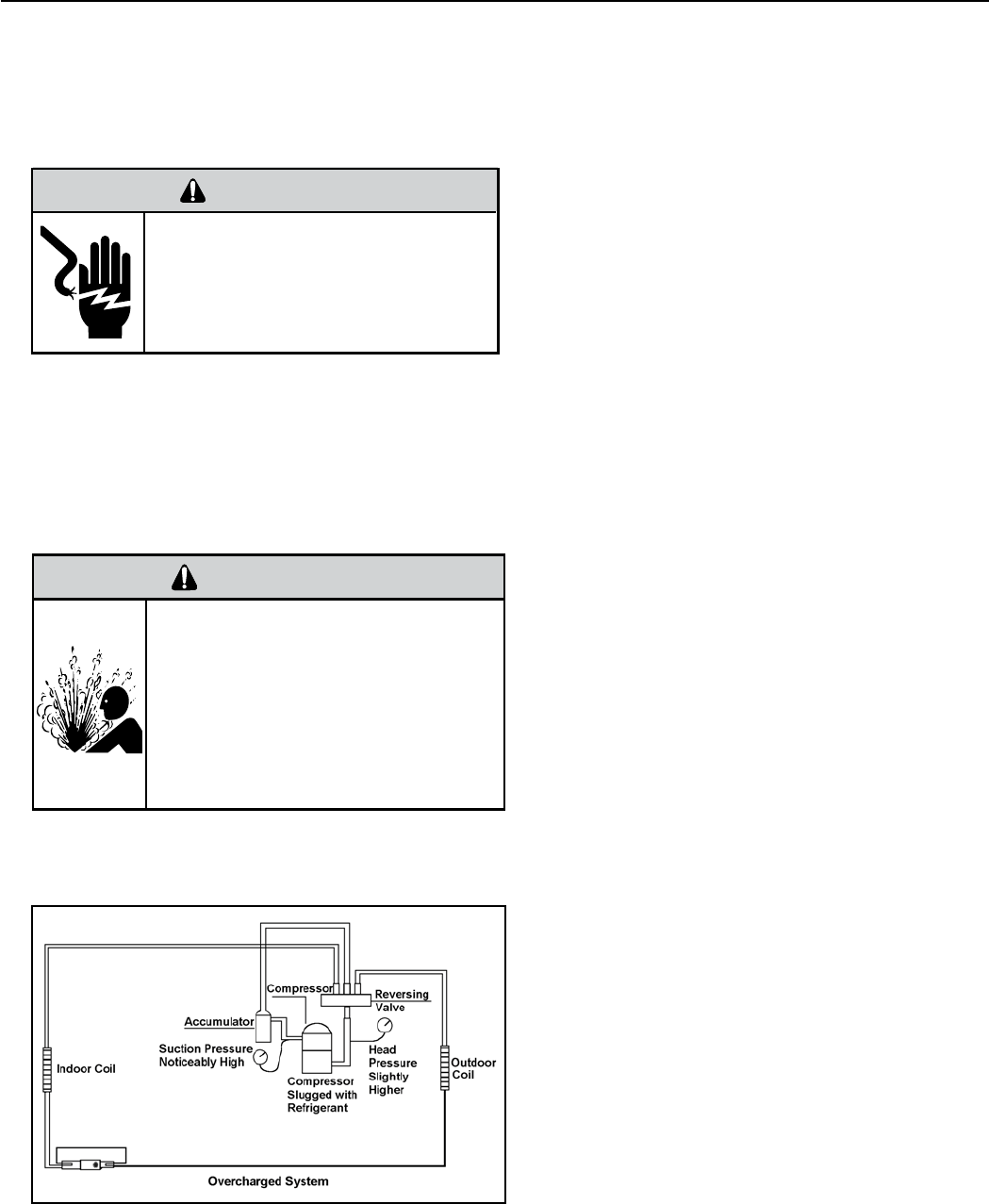
60 PB
Overcharged Refrigerant Systems
NOTE: Ensure fan is on high speed during testing.
NOTE: A unit sealed from the factory will not be over-
charged.
Whenever an overcharged system is indicated, always make
sure that the problem is not caused by air ow problems.
Improper air ow over the evaporator coil may indicate some
of the same symptoms as an over charged system.
NOTE: Factory sealed units will not be overcharged
An overcharge can cause the compressor to fail, since
it would be “slugged” with liquid refrigerant.
The charge for any system is critical. When the
compressor is noisy, suspect an overcharge, when you
are sure that the air quantity over the evaporator coil is
correct. Icing of the evaporator will not be encountered
because the refrigerant will boil later if at all. Gauges
connected to system will usually have higher head
pressure (depending upon amount of over charge).
Suction pressure should be slightly higher.
Compressor amps will be near normal or higher.
Noncondensables can also cause these symptoms.
To conrm, reclaim some of the charge, if conditions
improve, system may be overcharged. If conditions
don’t improve, Noncondensables are indicated.
Figure 602 (Overcharged System)
WARNING
RISK OF ELECTRIC SHOCK
Unplug and/or disconnect all electrical power
to the unit before performing inspections,
maintenances or service.
Failure to do so could result in electric shock,
serious injury or death.
WARNING
HIGH PRESSURE HAZARD
Sealed Refrigeration System contains refrigerant
and oil under high pressure.
Proper safety procedures must be followed,
and proper protective clothing must be worn
when working with refrigerants.
Failure to follow these procedures could
result in serious injury or death.
R-410A SEALED SYSTEM REPAIRS
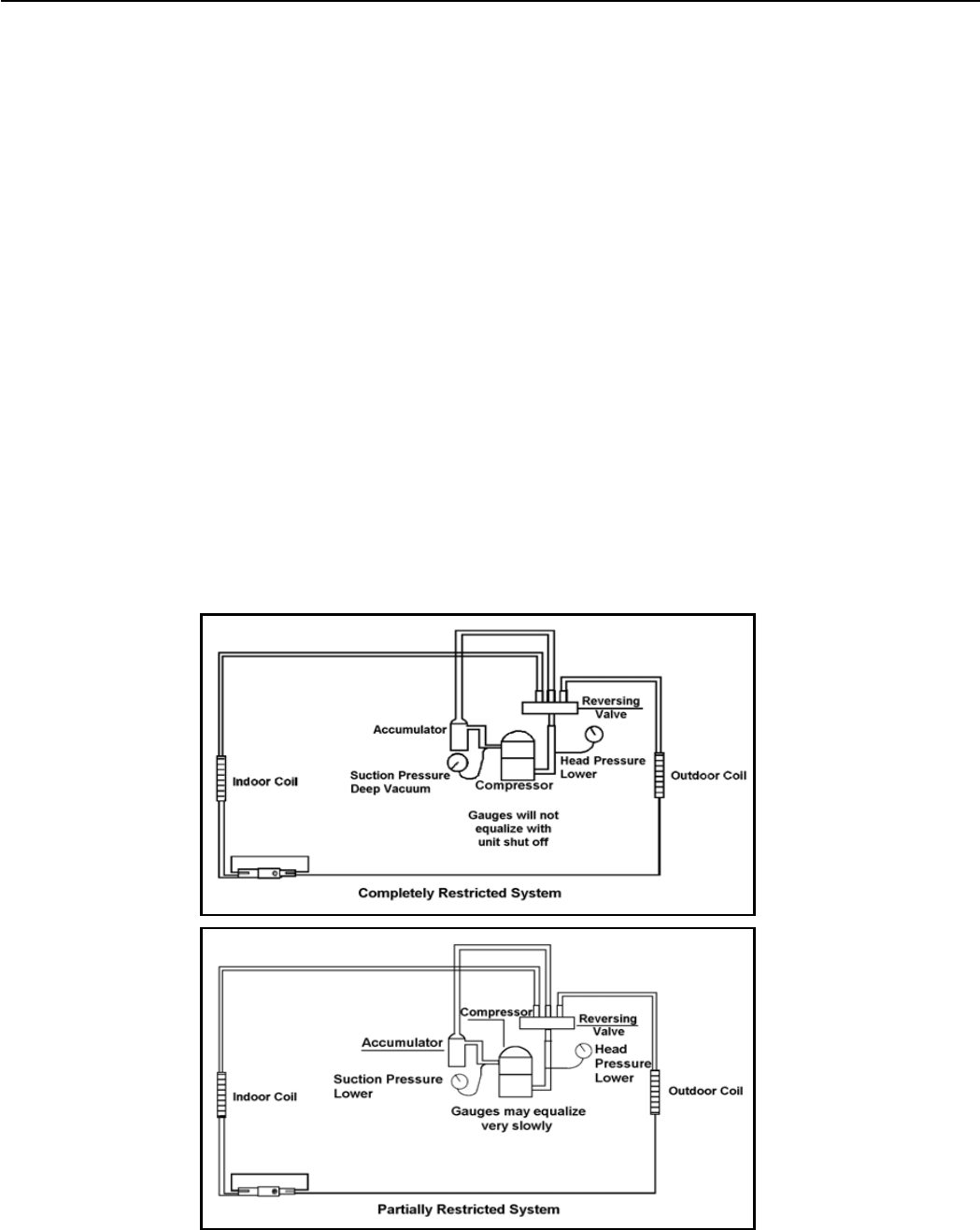
61 PB
R-410A SEALED SYSTEM REPAIRS
Restricted Refrigerant System
NOTE: Ensure fan is on high speed during testing.
Troubleshooting a restricted refrigerant system can be difcult. The following procedures are the more common problems
and solutions to these problems. There are two types of refrigerant restrictions: Partial restrictions and complete restrictions.
A partial restriction allows some of the refrigerant to circulate through the system.
With a complete restriction there is no circulation of refrigerant in the system.
Restricted refrigerant systems display the same symptoms as a “low-charge condition.”
A quick check for either condition begins at the evaporator. With a partial restriction, there may be gurgling sounds at the
metering device entrance to the evaporator. The evaporator in a partial restriction could be partially frosted or have an ice ball
close to the entrance of the metering device. Frost may continue on the suction line back to the compressor.
Often a partial restriction of any type can be found by feel, as there is a temperature difference from one side of the restriction
to the other. There will ususally be a diiference felt at the capillary tube. This does not indicate a restricted condition.
With a complete restriction, there will be no sound at the metering device entrance. An amperage check of the compressor
with a partial restriction may show normal current when compared to the unit specication. With a complete restriction the
current drawn may be considerably less than normal, as the compressor is running in a deep vacuum (no load.) Much of the
area of the condenser will be relatively cool since most or all of the liquid refrigerant will be stored there.
Make all checks posible before tapping into the system and installing gauges.
When the unit is shut off, or the compressor disengages, the gauges may equalize very slowly.
The following conditions are based primarily on a system in the cooling mode.
Figure 603 (Restricted System)

62 PB
R-410A SEALED SYSTEM REPAIRS
Sealed System Method of Charging/ Repairs
BURN HAZARD
Proper safety procedures must be followed,
and proper protective clothing must be worn
when working with a torch.
Failure to follow these procedures could
result in moderate or serious injury.
WARNING
FREEZE HAZARD
Proper safety procedures must be followed,
and proper protective clothing must be worn
when working with liquid refrigerant.
Failure to follow these procedures could
result in minor to moderate injury.
CAUTION
The refrigerant cycle is critically charged. The only acceptable method for charging the sealed system is the
Weighed in Charge Method.
The weighed in method should always be used whenever a charge is removed from a unit such as for a leak
repair, compressor replacement, or when there is no refrigerant charge left in the unit. To charge by this method,
requires the following steps:
1. Install a piercing valve to remove refrigerant from the sealed system. (Piercing valve must be removed from
the system before recharging.)
2. Recover Refrigerant in accordance with EPA regulations.
3. Install a process tube to sealed system.
4. Make necessary repairs to system.
5. Evacuate the system to 1500 microns
6. Repressurize to 50 PSI with nitrogen
7. Evacuate the system to 1000 microns
8. Repressurize to 50 PSI with nitrogen
9. Evacuate the system to below 500 microns
10. Weigh in the refrigerant charge with the property quantity of R-410A refrigerant per model nameplate.
11. Start unit, and verify performance.
12. Crimp the process tube and solder the end shut.
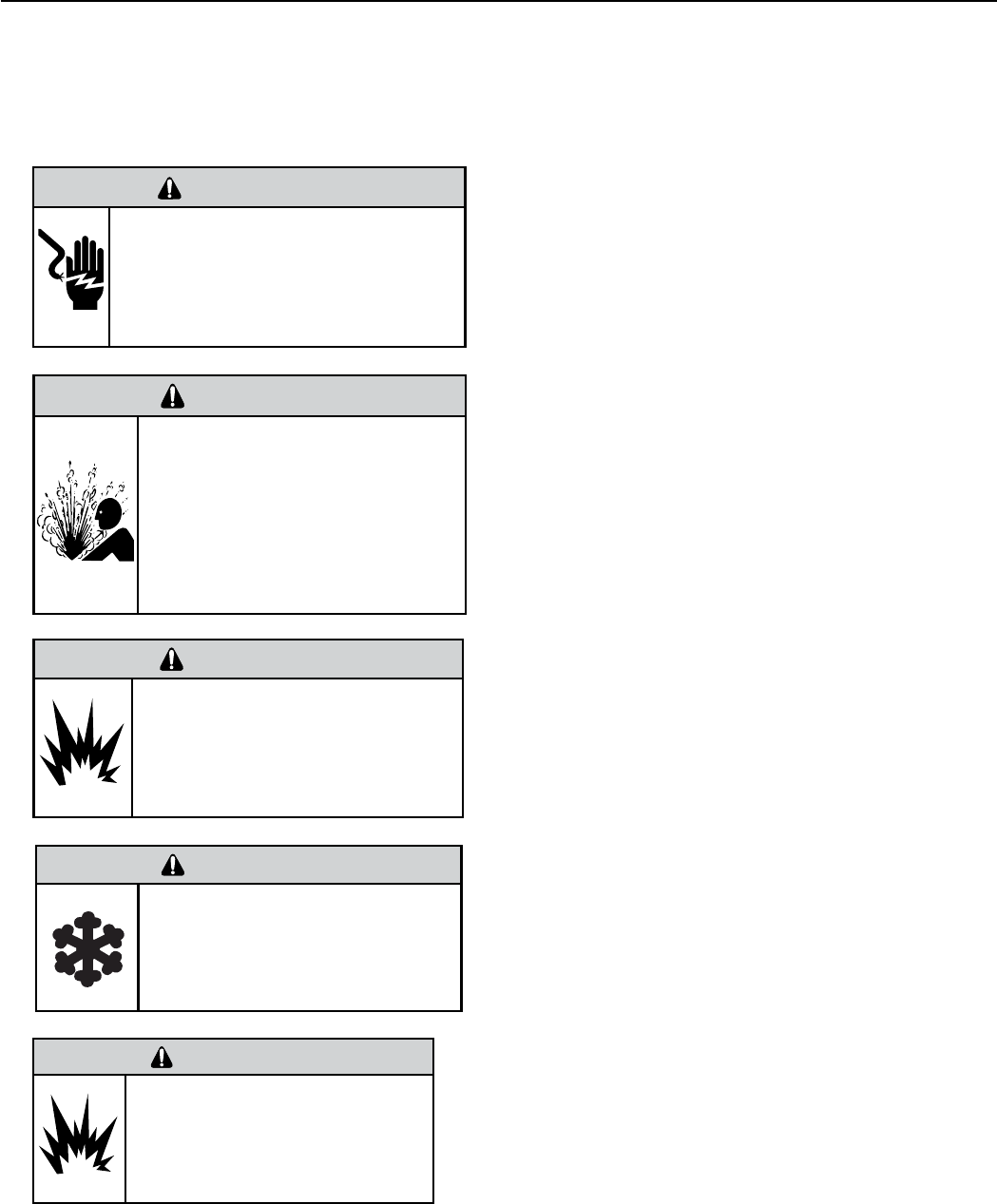
63 PB
R-410A SEALED SYSTEM REPAIRS
Compressor Replacement
WARNING
ELECTRIC SHOCK HAZARD
Turn off electric power before service or
installation. Extreme care must be used, if it
becomes necessary to work on equipment with
power applied.
Failure to do so could result in serious injury or
death.
WARNING
HIGH PRESSURE HAZARD
Sealed Refrigeration System contains refrigerant
and oil under high pressure.
Proper safety procedures must be followed,
and proper protective clothing must be worn
when working with refrigerants.
Failure to follow these procedures could
result in serious injury or death.
1. Be certain to perform all necessary electrical and refrigeration
tests to be sure the compressor is actually defective before
replacing.
2. Recover all refrigerant from the system though the process
tubes. PROPER HANDLING OF RECOVERED REFRIGERANT
ACCORDING TO EPA REGULATIONS IS REQUIRED. Do not use
gauge manifold for this purpose if there has been a burnout. You
will contaminate your manifold and hoses. Use a Schrader valve
adapter and copper tubing for burnout failures.
3.After all refrigerant has been recovered, disconnect suction and
discharge lines from the compressor and remove compressor. Be
certain to have both suction and discharge process tubes open to
atmosphere.
4.Carefully pour a small amount of oil from the suction stub of the
defective compressor into a clean container.
5.Using an acid test kit (one shot or conventional kit), test the oil
for acid content according to the instructions with the kit.
6.If any evidence of a burnout is found, no matter how slight, the
system will need to be cleaned up following proper procedures.
7.Install the replacement compressor.
CAUTION: While the unit is being evacuated, seal all openings on
the defective compressor. Compressor manufacturers will void
warranties on units received not properly sealed. Do not distort
the manufacturers tube connections.
8. Pressurize with trace amounts of R-410A and nitrogen to 550
psi and leak test all connections with a leak detector.Repair any
leaks found.
8a. If leak detector is unavailable remove all refrigerant from
system and pressurize with nitrogen to 550 psi. Check that system
holds pressure.
Repeat Step 8 to ensure no more leaks are present
9. Evacuate the system with a good vacuum pump capable of
a nal vacuum of 300 microns or less. The system should be
evacuated through both liquid line and suction line gauge ports.
9a.Evacuate the system to 1500 microns.
9b. Repressurize to 50 PSI with nitrogen.
9c. Evacuate the system to 1000 microns.
9d. Repressurize to 50 PSI with nitrogen.
9e. Evacuate the system to below 500 microns.
10. Weigh in the refrigerant charge with the proper quantity
of R-410A refrigerant using digital scale per model
nameplate.
11.Start unit, and verify performance.
12. Crimp the process tube and solder the end shut.
WARNING
EXPLOSION HAZARD
The use of nitrogen requires a pressure
regulator. Follow all safety procedures and
wear protective safety clothing etc.
Failure to follow proper safety procedures
could result in serious injury or death.
FREEZE HAZARD
Proper safety procedures must be followed,
and proper protective clothing must be worn
when working with liquid refrigerant.
Failure to follow these procedures could
result in minor to moderate injury.
CAUTION
WARNING
NEVER, under any circumstances,
liquid charge a rotary-compressor
through the LOW side. Doing so
would cause permanent damage to
the new compressor. Use a charging
adapter.
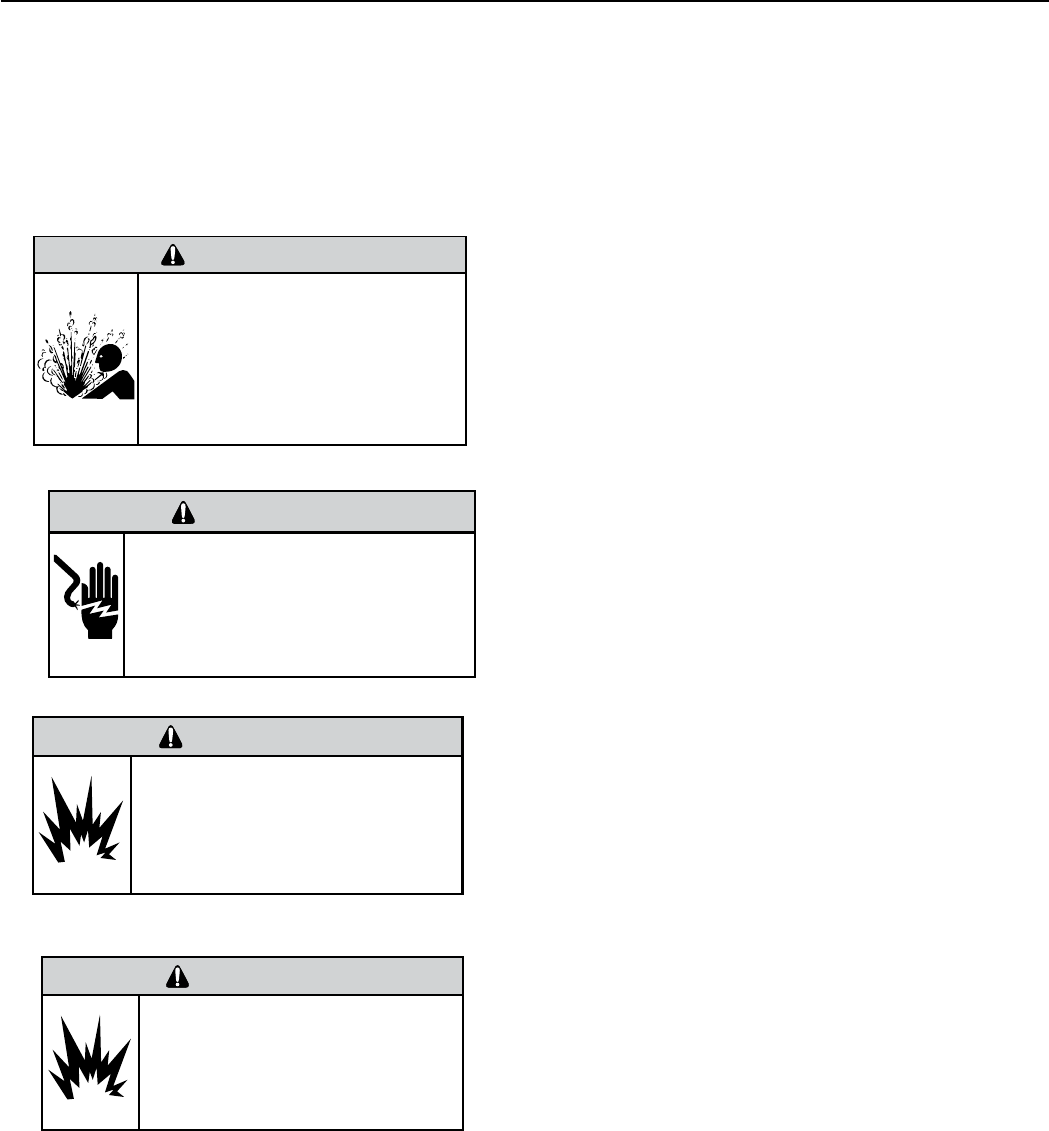
64 PB
R-410A SEALED SYSTEM REPAIRS
Compressor Replacement -Special Procedure in Case of Compressor Burnout
WARNING
HIGH PRESSURE HAZARD
Sealed Refrigeration System contains refrigerant
and oil under high pressure.
Proper safety procedures must be followed,
and proper protective clothing must be worn
when working with refrigerants.
Failure to follow these procedures could
result in serious injury or death.
WARNING
ELECTRIC SHOCK HAZARD
Turn off electric power before service or
installation. Extreme care must be used, if it
becomes necessary to work on equipment with
power applied.
Failure to do so could result in serious injury or
death.
WARNING
EXPLOSION HAZARD
The use of nitrogen requires a pressure
regulator. Follow all safety procedures and
wear protective safety clothing etc.
Failure to follow proper safety procedures
could result in serious injury or death.
1. Recover all refrigerant and oil from the system.
2. Remove compressor, capillary tube and lter drier from the
system.
3. Flush evaporator condenser and all connecting tubing with dry
nitrogen or equivalent. Use approved ushing agent to remove all
contamination from system. Inspect suction and discharge line for
carbon deposits. Remove and clean if necessary. Ensure all acid is
neutralized.
4. Reassemble the system, including new drier strainer and capillary
tube.
5. Pressurize with trace amounts of R-410A and nitrogen to 550 psi
and leak test all connections with a leak detector. Repair any leaks
found.
5a. If leak detector is unavailable remove all refrigerant from system
and pressurize with nitrogen to 550 psi. Check that system holds
pressure.
Repeat Step 5 to insure no more leaks are present.
NOTE: While the unit is being evacuated, seal all openings on
the defective compressor. Compressor manufacturers will void
warranties on units received not properly sealed. Do not distort the
manufacturers tube connections.
9. Evacuate the system with a good vacuum pump capable of a nal
vacuum of 300 microns or less. The system should be evacuated
through both liquid line and suction line gauge ports.
9a.Evacuate the system to 1500 microns.
9b. Repressurize to 50 PSI with nitrogen.
9c. Evacuate the system to 1000 microns.
9d. Repressurize to 50 PSI with nitrogen.
9e. Evacuate the system to below 500 microns.
7. Recharge the system with the correct amount of refrigerant. The
proper refrigerant charge will be found on the unit rating plate. The
use of an accurate measuring device, such as a charging cylinder,
electronic scales or similar device is necessary.
WARNING
NEVER, under any circumstances,
liquid charge a rotary-compressor
through the LOW side. Doing so
would cause permanent damage to
the new compressor. Use a charging
adapter.
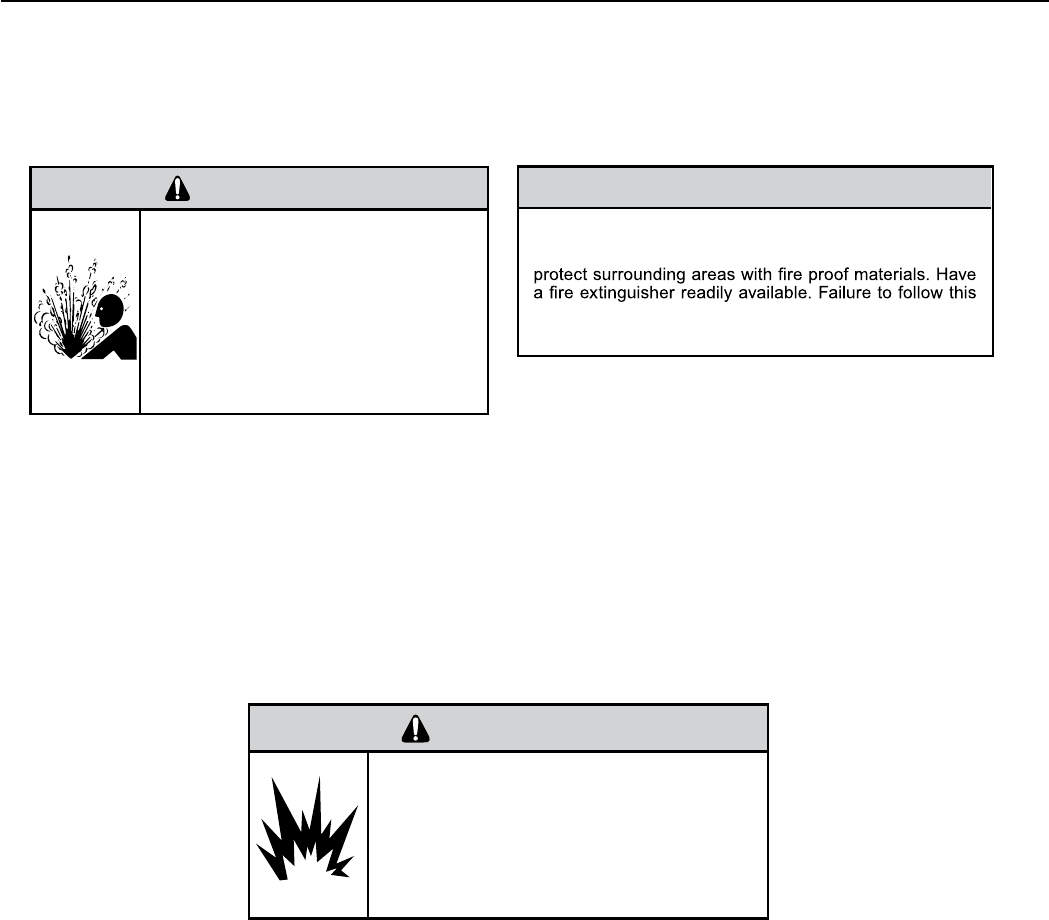
65 PB
R-410A SEALED SYSTEM REPAIRS
Replace The Reversing Valve
WARNING
HIGH PRESSURE HAZARD
Sealed Refrigeration System contains refrigerant
and oil under high pressure.
Proper safety procedures must be followed,
and proper protective clothing must be worn
when working with refrigerants.
Failure to follow these procedures could
result in serious injury or death.
NOTICE
FIRE HAZARD
The use of a torch requires extreme care and proper
judgment. Follow all safety recommended precautions and
notice could result in moderate to serious property damage.
1. Install Process Tubes. Recover refrigerant from sealed system. PROPER HANDLING OF RECOVERED
REFRIGERANT ACCORDING TO EPA REGULATIONS IS REQUIRED.
2. Remove solenoid coil from reversing valve. If coil is to be reused, remove solenoid and protect from heat while
changing valve.
3. Unbraze all lines from reversing valve.
4. Clean all excess braze from all tubing so that they will slip into ttings on new valve.
5. Remove solenoid coil from new valve.
6. Protect new valve body from heat while brazing with plastic heat sink (Thermo Trap) or wrap valve body with
wet rag.
7. Fit all lines into new valve and braze lines into new valve.
WARNING
EXPLOSION HAZARD
The use of nitrogen requires a pressure
regulator. Follow all safety procedures and
wear protective safety clothing etc.
Failure to follow proper safety procedures
could result in serious injury or death.
8. Pressurize sealed system with trace amounts of R-410A and nitrogen up to 550 psi. Perform Triple evacuation
and leak processes, using a suitable leak detector according to HVAC industry standards.
9. Once the sealed system is leak free, install solenoid coil on new valve and charge the sealed system by
weighing in the proper amount and type of refrigerant as shown on rating plate. Crimp the process tubes and
solder the ends shut. Do not leave Schrader or piercing valves in the sealed system.
NOTE: When brazing a reversing valve into the system, it is of extreme importance that the temperature of the
valve does not exceed 250°F at any time.
Wrap the reversing valve with a large rag saturated with water. “Re-wet” the rag and thoroughly cool the valve
after each brazing operation of the four joints involved.
The wet rag around the reversing valve will eliminate conduction of heat to the valve body when brazing the line
connection.
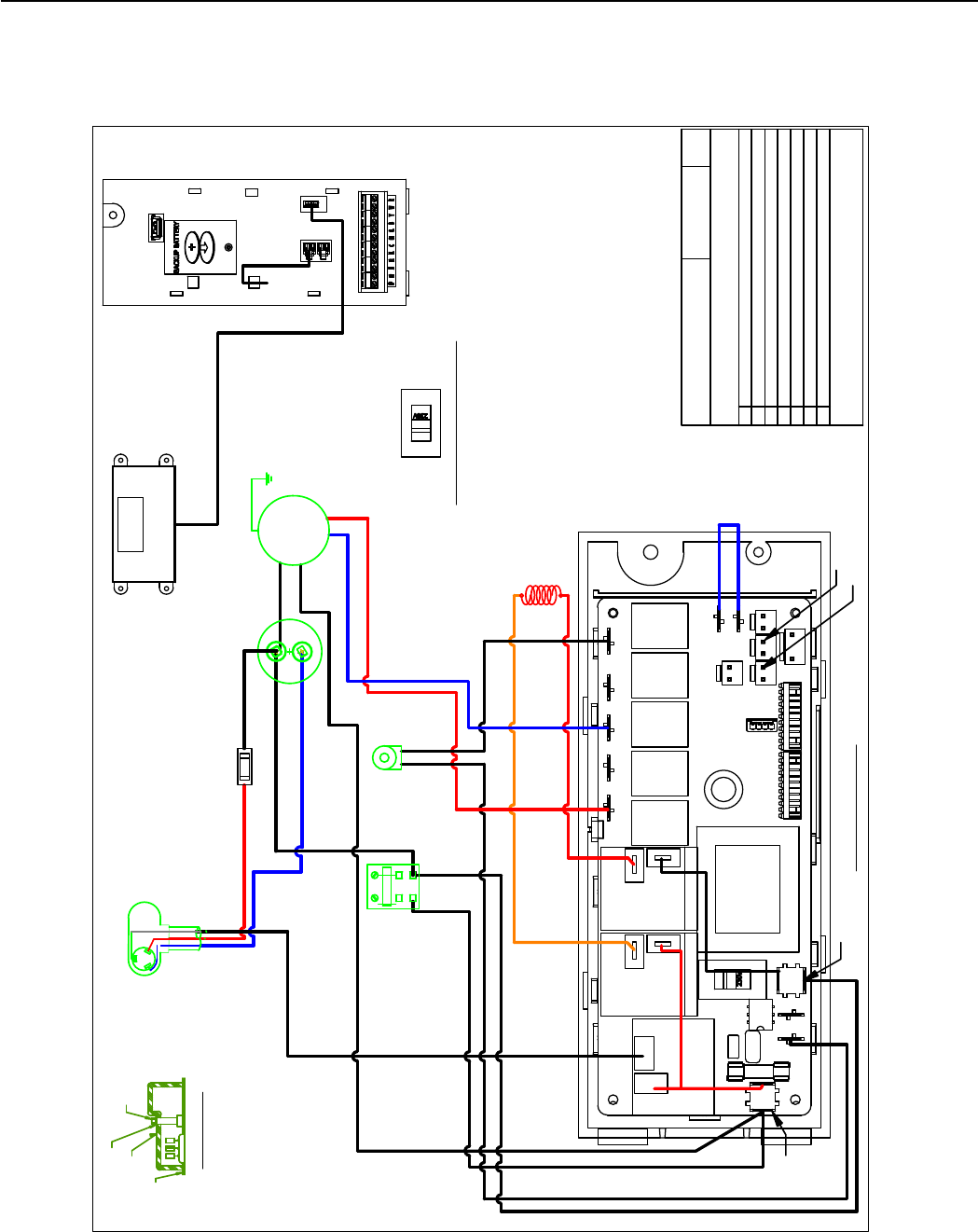
66 PB
WIRING DIAGRAMS
9-12K 208/230V
Figure 801
B
L
U
E
RED
WHITE
B
L
U
E
GREEN
ORANGE
C
L1 L2
ELECTRONIC CONTROL
" F"
R
S
C
TERMINAL DETAIL
BLUE
RED
HEATER
2.5 KW & 3.4 KW
5.0 KW
BLACK (TO L1)
B
L
U
E
RED
QUICK
DISCONNECT
COIL
SOLENOID
CAPACITOR
BLOWER
MOTOR
TO MOTOR
MOUNT
W
HITE 520 (TO L2)
COMPRESSOR
GASKET
TEMINAL COVER
WASHER
NUT
HARNESS
COMPRESSOR
V
H
A
9
/
1
2
/
1
8
P
C
B
W
I
R
I
N
G
D
I
A
G
R
A
M
H
E
A
T
P
U
M
P
W
/
2
.
5
K
W
,
3
.
4
K
W
,
5
K
W
E
L
E
.
H
E
A
T
W Call for Heating
B Reversing valve Energized in heating mode
GL Call for Low Fan
GH Call for High Fan
R 24VAC Power From Unit
Y Call for Cooling
01
PART NO.
REV
LEGEND
LEGEND FOR TSTAT WIRING HARNESS
92160304
C COMMON
BLACK
H
E
R
M
CIRCUIT
BREAKER
BLACK
WHITE
WHITE
INDOOR COIL SENSOR
OUTDOOR COIL SENSOR
SERVICE DISPLAY
AMBIENT
AIR SENSOR
L2 or ACN
L1
VOLTAGE SELECTION SWITCH
SET VOLTAGE TO 230V
RV
RELAY
FAN 4
RELAY
FAN 3
RELAY
FAN 2
RELAY
FAN 1
RELAY
HEAT
RELAY
HEAT
RELAY
COMP
RELAY
VOLTAGE SWITCH
WIRING DIAGRAM
COOL, ELECTRIC HEAT, HEAT PUMP
SMALL CHASSIS, 230/208V
HEATERS: 2.5KW, 3.4KW, 5.0KW
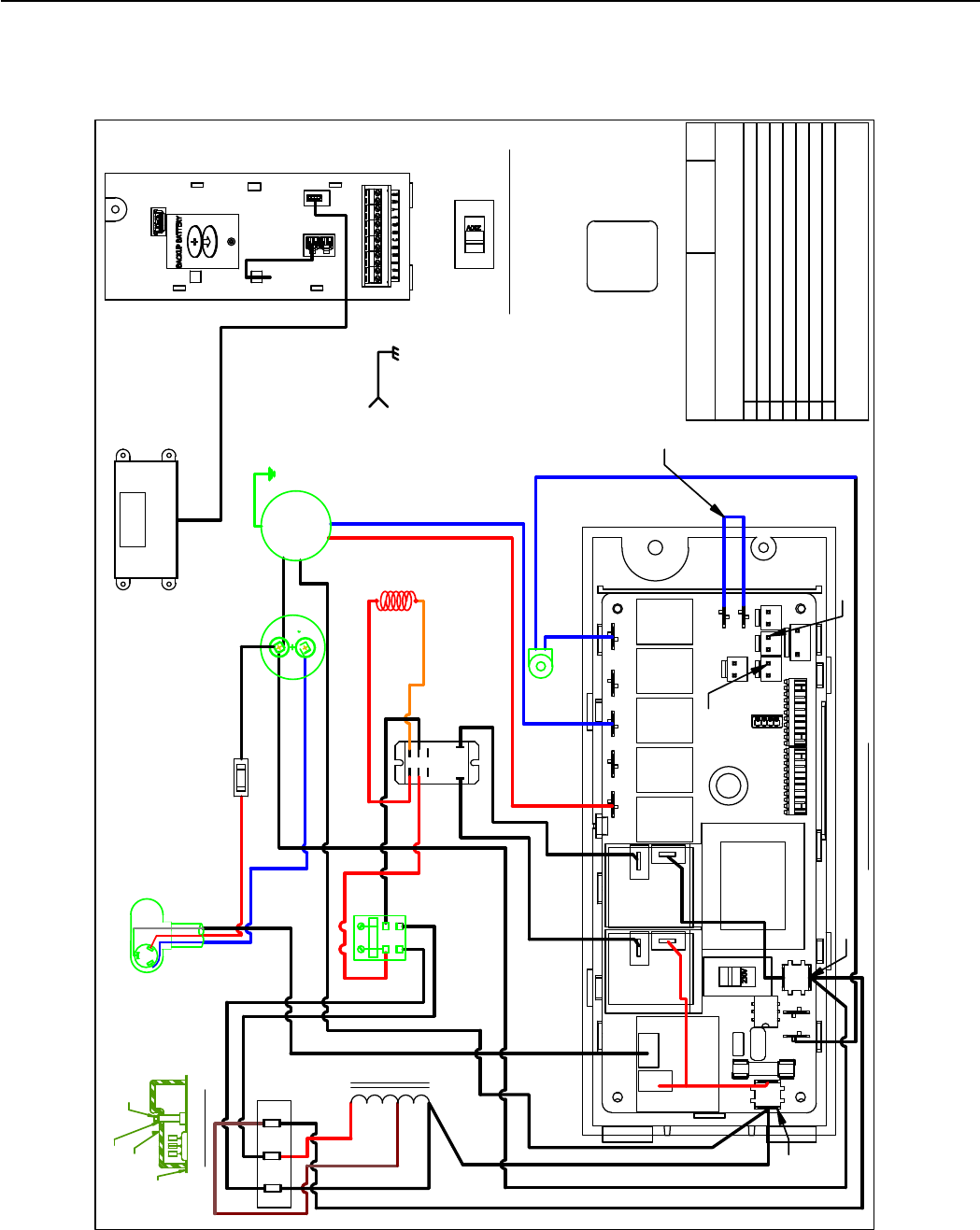
67 PB
Figure 802
WIRING DIAGRAMS
9-12K 265V
B
L
U
E
RED
B
L
U
E
GREEN
BLACK
C
L1
L2
ELECTRONIC CONTROL
" F"
R
S
C
TERMINAL DETAIL
RED
BLUE
HEATER
2.5 KW & 3.4 KW
5.0 KW
B
L
U
E
WHITE
QUICK
DISCONNECT
COIL
SOLENOID
CAPACITOR
MOTOR
TO MOTOR
MOUNT
W
H
I
T
E
COMPRESSOR
GASKET
TEMINAL COVER
WASHER
NUT
HARNESS
COMPRESSOR
W Call for Heating
B Reversing valve Energized in heating mode
GL Call for Low Fan
GH Call for High Fan
R 24VAC Power From Unit
Y Call for Cooling
01
PART NO.
REV
LEGEND
LEGEND FOR TSTAT WIRING HARNESS
92160305
C COMMON
BLACK
H
E
R
M
ORANGE
RED
REL
AY
BLACK
RED
BLACK
BLACK
R
E
D
B
R
O
W
N
WHITE
BLACK
GROUND TO CHASIS
BUILDING
GROUND
265V 60Hz
2Ø 2 WIRES
FLA
MCA
MOP
FUSE
BLOCK
TRANSFORMER
W
HITE
WHITE
BLACK
WHITE
CIRCUIT
BREAKER
INDOOR
COIL
SENSOR
OUTDOOR COIL SENSOR
SERVICE DISPLAY
AMBIENT
AIR SENSOR
L2 or ACN
L1
VOLTAGE SELECTION SWITCH
SET VOLTAGE TO 230V
RV
RELAY
FAN 4
RELAY
FAN 3
RELAY
FAN 2
RELAY
FAN 1
RELAY
HEAT
RELAY
HEAT
RELAY
COMP
RELAY
VOLTAGE SWITCH
WIRING DIAGRAM
COOL, ELECTRIC HEAT, HEAT PUMP
SMALL CHASSIS, 265V
HEATERS: 2.5KW, 3.4KW, 5.0KW
FUSE
A
FUSE
A
FUSE
A
JUMPER
WIRE
TRANSFORMER
ELECTRONIC CONTROL
(REAR VIEW)
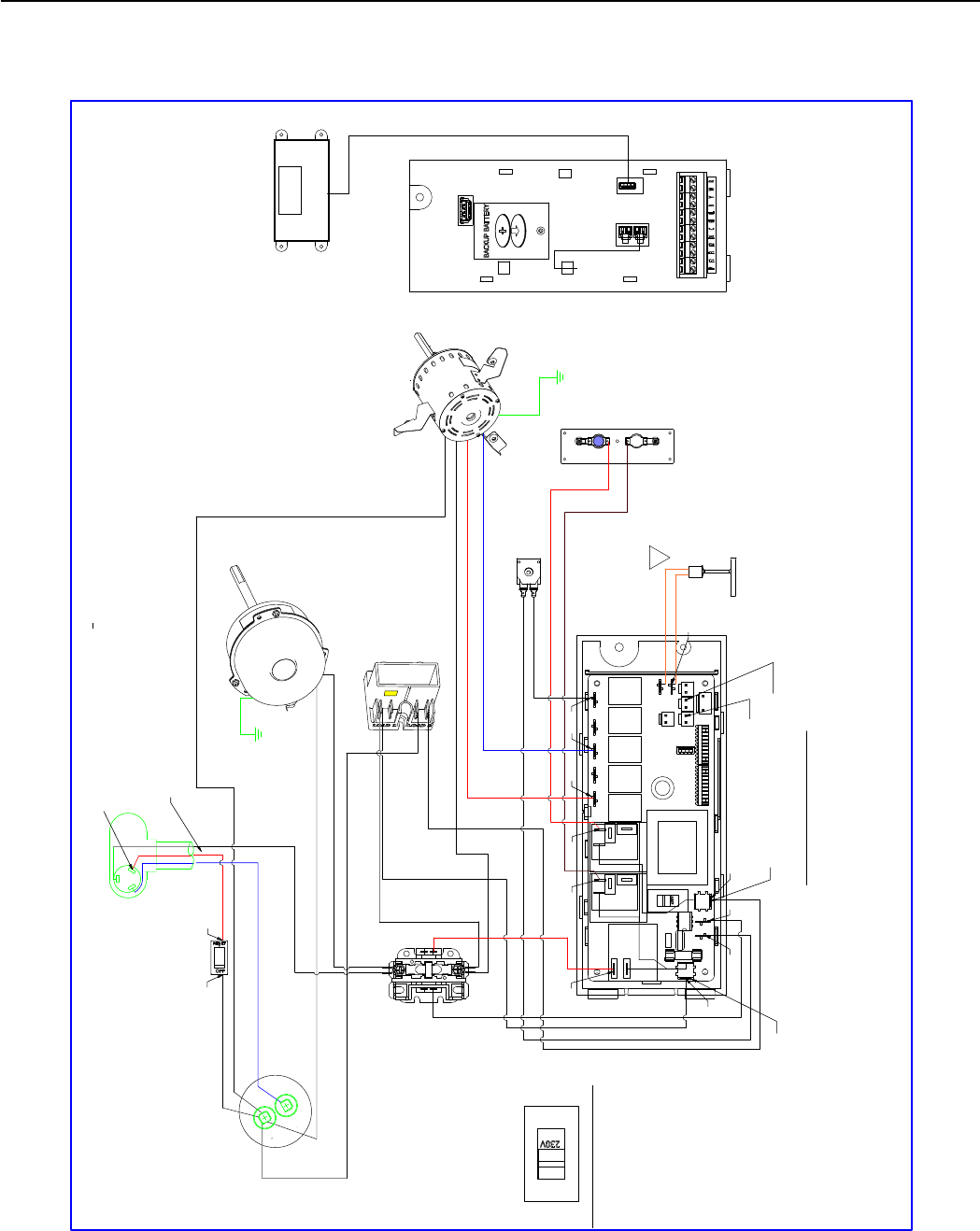
68 PB
Figure 803
WIRING DIAGRAMS
18K 208/230V (2.5KW, 3.5KW, 5KW)
WHITE
WHITE
BLUE
W
H
I
T
E
RED
WHITE
GREEN
BLACK
x2
BROWN
WHITE
GREEN
C
BLACK
HE
RM
R
S
ELECTRONIC CONTROL
C
" F"
BLUE
ORANGE
ORANGE
RED
RED
HEATER
2.5 KW & 3.5 KW
5.0 KW
PRESSURE
SWITCH
COMPRESSOR
CONTACTOR
QUICK
DISCONNECT
COIL SOLENOID
TO MOTOR
MOUNT
OUTDOOR
FAN MOTOR
INDOOR BLOWER
MOTOR
TO MOTOR
MOUNT
W
HITE
(
TO
L2)
CAPACITOR
COMPRESSOR
RED
540
HARNESS COMPRESSOR
WHITE
CIRCUIT
BREAKER
1
BLACK
BLACK
BLAC K
(TO
L1)
BLACK
INDOOR COIL SENSOR
4770D SEQ 104
TO DISPLAY
OUTDOOR COIL SENSOR
4770D SEQ 105
L2 or ACN
L1
AMBIENT
AIR SENSOR
(POU 4770D SEQ 103)
VOLTAGE SELECTION SWITCH
RV
RELAY
FAN 4
SET VOLTAGE TO 230V
RELAY
FAN 3
RELAY
FAN 2
RELAY
FAN 1
RELAY
HEAT
RELAY
HEAT
RELAY
COMP
RELAY
*
*
*
*
*
*
* *
*
*
*
*
*
DISPLAY SERVICE
01
1
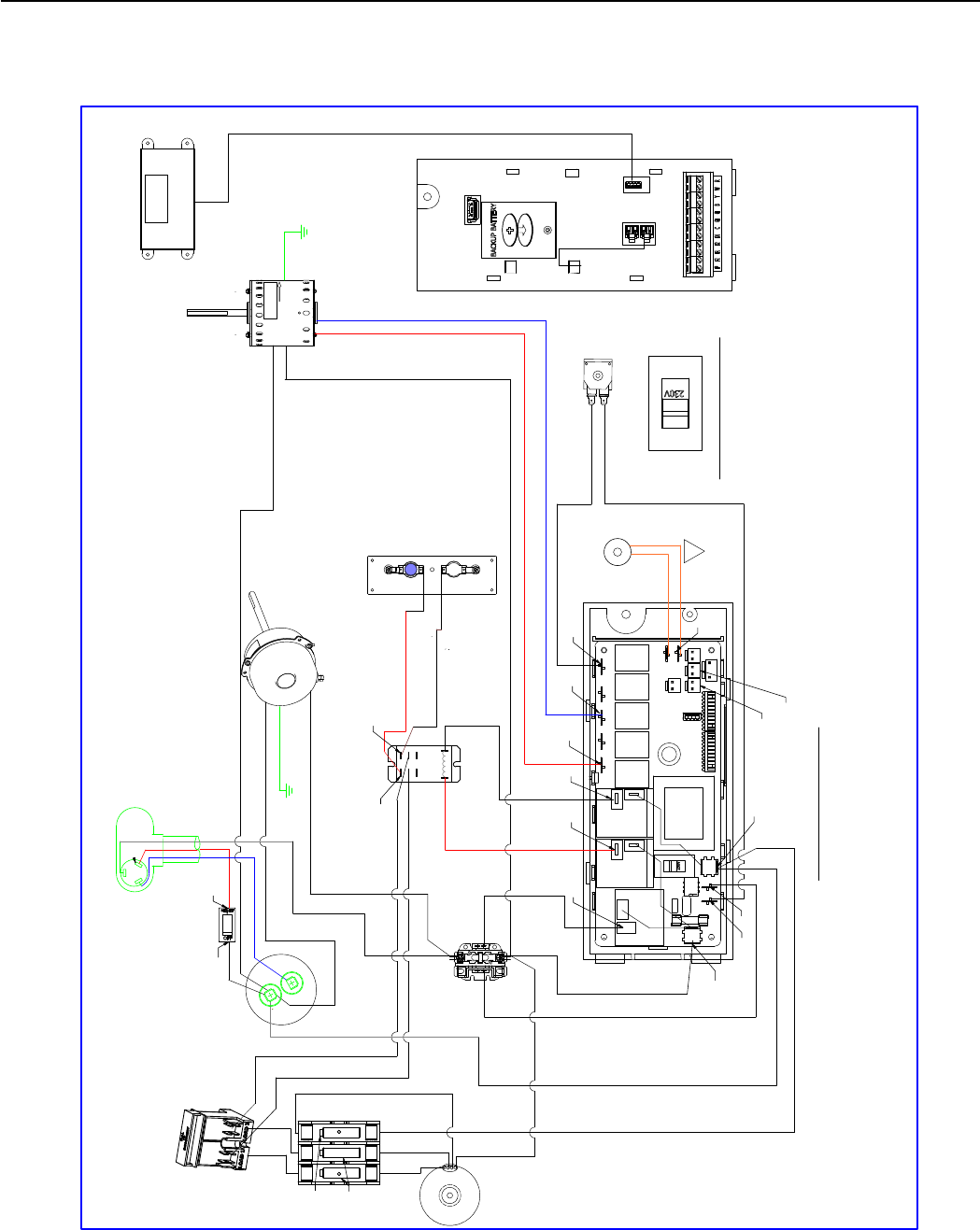
69 PB
WIRING DIAGRAMS
18K 265V (2.5KW, 3.5KW, 5.0KW)
Figure 804
L
BLACK
COMPRESSOR
CONTACTOR
ELECTRONIC CONTROL
BLACK
WHITE
H
E
A
T
E
R
R
E
L
A
Y
4
7
7
0
TO MOTOR
MOUNT
RED
BLACK
GREEN
RED
RED
BLUE
BLAC K
W
HITE
HE
RM
C
BRO W
N
CAPACITOR
QUICK DISCONNECT
COMPRESSOR
BLACK
WHITE
TO MOTOR
MOUNT
RED
OUTDOOR
FAN MOTOR
BLUE
RED
PRESSURE
SWITCH
O
R
A
N
G
E
O
R
A
N
G
E
GREEN
COIL SOLENOID
INDOOR
BLOWER
MOTOR
HEATER
2.5 KW & 3.5 KW
5.0 KW
BROWN
BLACK
BLACK
CIRCUIT
BREAKER
W
H
I
T
E
B
L
A
C
K
WHITE
WHITE
TRANSFORMER
IN= 265V
OUT= 230V
W
HITE
C
S
R
" F"
R ED
W
HITE
HARNESS COMPRESSOR
FUSE
HO
LDER
BLAC K
BLA C K
BLACK
VOLTAGE SELECTION SWITCH
SET VOLTAGE TO 230V
FUSE
FUSE
*
*
COMP
RELAY
HEAT
RELAY
HEAT
RELAY
FAN 1
RELAY
FAN 2
RELAY
FAN 3
RELAY
FAN 4
WIRING DIAGRAM
COOL, HEAT PUMP, EH, 265V
2.5, 3.4, 5.0 KW
LARGE CHASSIS
RV
RELAY
RELAY
*
*
*
*
*
*
*
*
*
*
*
*
SERVICE DISPLAY
AMBIENT
AIR
SENSOR
INDOOR COIL SENSOR
*
OUTDOOR COIL SENSOR
01
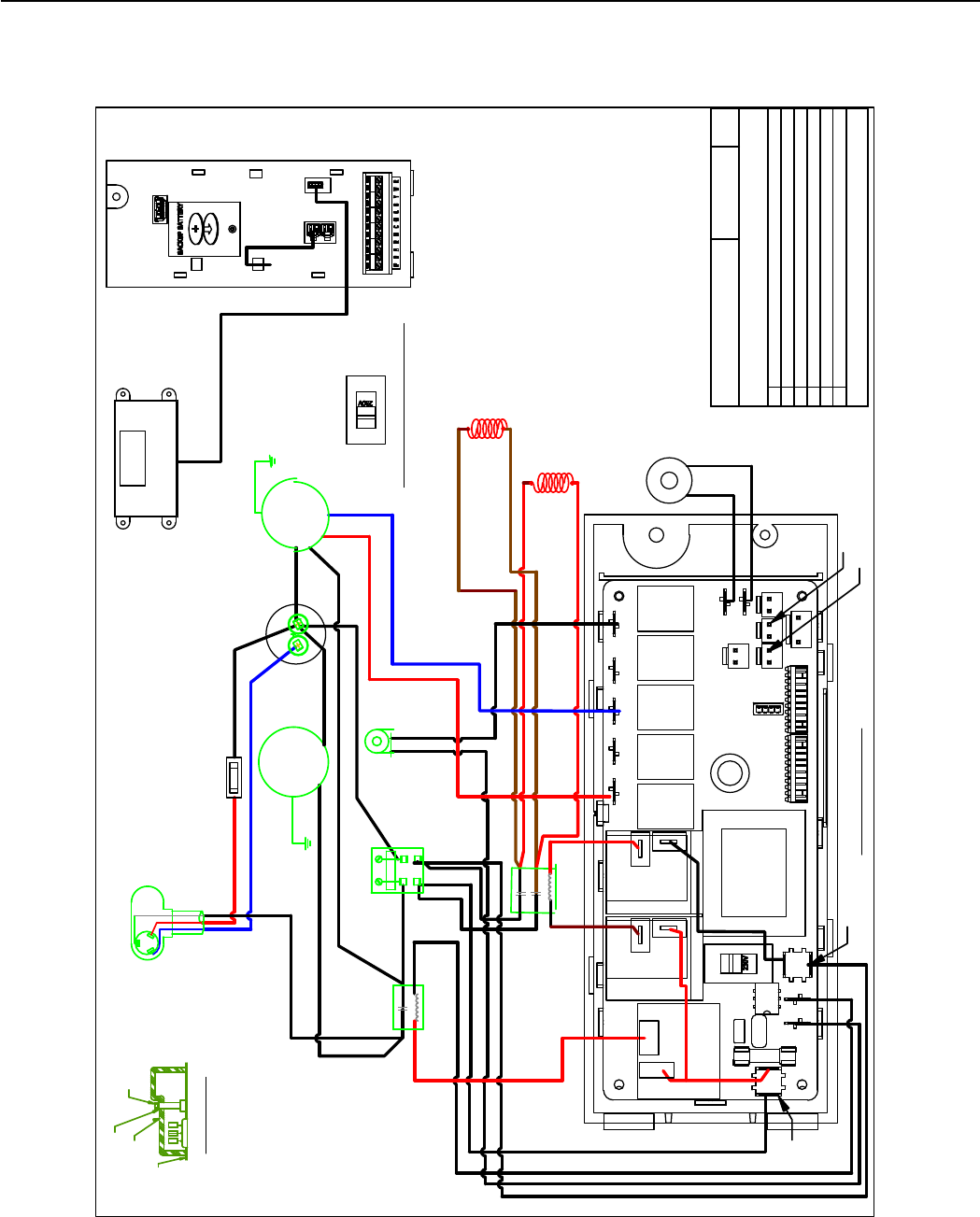
70 PB
WIRING DIAGRAMS
18K 208/230V (7.5KW)
WHITE
WHITE
BLUE
RED
WHITE
RED
WHITE
GREEN
C
GREEN
H
E
R
M
BLACK
L1
L2
ELECTRONIC CONTROL
" F "
R
S
C
TERMINAL DETAIL
RED
BLACK
BLACK
BLUE
HEATER
7.5 KW
BLACK (TO L1)
RED
PRESSURE
SWITCH
COMPRESSOR
CONTACTOR
QUICK DISCONNECT
COIL
SOLENOID
TO MOTOR
MOUNT
OUTDOOR
FAN MOTOR
CAPACITOR
INDOOR
BLOWER
MOTOR
TO MOTOR
MOUNT
W
HITE 520 (TO L2)
COMPRESSOR
GASKET
TEMINAL COVER
WASHER
NUT
HARNESS COMPRESSOR
LEGEND FOR TSTAT WIRING HARNESS
LEGEND
Y Call for Cooling
R 24VAC Power From Unit
W Call for Heating
GH Call for High Fan
GL Call for Low Fan
92160515
B Reversing valve Energized in heating mode
PART NO. REV
02
CIRCUIT
BREAKER
B
L
A
C
K
WHITE
BLACK
HEATER
DOUBLE POLE
CONTACTOR
BLACK
WHITE
RED
RED
BROWN
BROWN
INDOOR COIL SENSOR
OUTDOOR COIL SENSOR
SERVICE
DISPLAY
AMBIENT
AIR SENSOR
L2 or ACN
L1
VOLTAGE SELECTION SWITCH
SET VOLTAGE TO 230V
RV
RELAY
FAN 4
RELAY
FAN 3
RELAY
FAN 2
RELAY
FAN 1
RELAY
HEAT
RELAY
HEAT
RELAY
COMP
RELAY
VOLTAGE SWITCH
WIRING DIAGRAM
COOL, ELECTRIC HEAT, HEAT PUMP
LARGE CHASSIS, 230/208V
HEATERS: 7.5KW
Figure 805
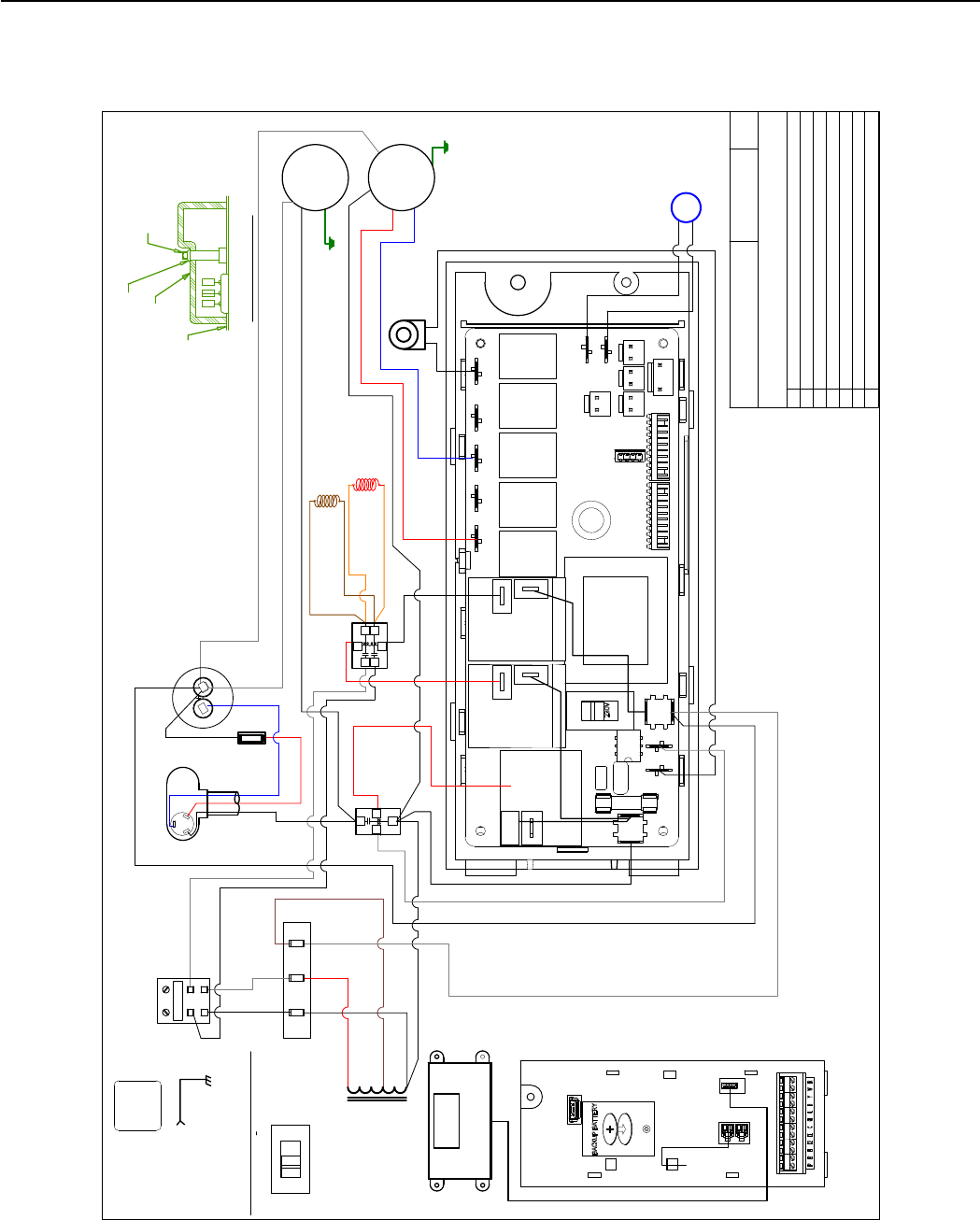
71 PB
WIRING DIAGRAMS
18K 265V (7.5KW)
(REAR VIEW)
ELECTRONIC CONTROL
(FRONT PANEL)
ELECTRONIC CONTROL
PART NO.
REV
B
L
A
C
K
W
H
I
T
E
B
L
A
C
K
R
E
D
W
H
I
T
E
B
L
A
C
K
B
R
O
W
N
W
H
I
T
E
C
H
E
R
M
FUSE BLOCK
BROWN
OUTDOOR
FAN
MOTOR
INDOOR
BLOWER
MOTOR
HEATER
7.5 KW
HEATER
DOUBLE POLE
CONTACTOR
WHITE
BLACK
B
L
U
E
CIRCUIT
BREAKER
RED
W
H
I
T
E
B
L
A
C
K
BLACK
RED
COMPRESSOR
CONTACTOR
RED
BLUE
TEMINAL COVER
TERMINAL DETAIL
NUT
WASHER
GASKET
2
3
0
V
RED
BLACK
BROWN
ORANGE
ORANGE
LEGEND FOR TSTAT WIRING HARNESS
92160516
AMBIENT
AIR SENSOR
VOLTAGE SELECTION SWITCH
SET VOLTAGE TO 230V
RV
RELAY
FAN 4
RELAY
FAN 3
RELAY
FAN 2
RELAY
HEAT
RELAY
HEAT
RELAY
COMP
RELAY
VOLTAGE SWITCH
TRANSFORMER
FAN 1
RELAY
C COMMON
R 24VAC Power From Unit
GH Call for High Fan
GL Call for Low Fan
B Reversing valve Energized in heating mode
Y Call for Cooling
W Call for Heating
WHITE
TRANSFORMER
FUSE
A
FUSE
A
FUSE
A
BLACK
CAPACITOR
WHITE
02
C
R
S
WHITE
BLACK
QUICK
DISCONNECT
COIL
SOLENOID
BUILDING
GROUND
LEGEND
SERVICE
DISPLAY
WIRING DIAGRAM
COOL, ELECTRIC HEAT, HEAT PUMP
LARGE CHASSIS, 265V
HEATER: 7.5 KW
COMPRESSOR
HARNESS
COMP
TO MOTOR
MOUNT
GREEN
TO MOTOR
MOUNT
265V 60Hz
2Ø 2 WIRES
FLA
MCA
MOP
GREEN
PRESSURE
SWITCH
Figure 806
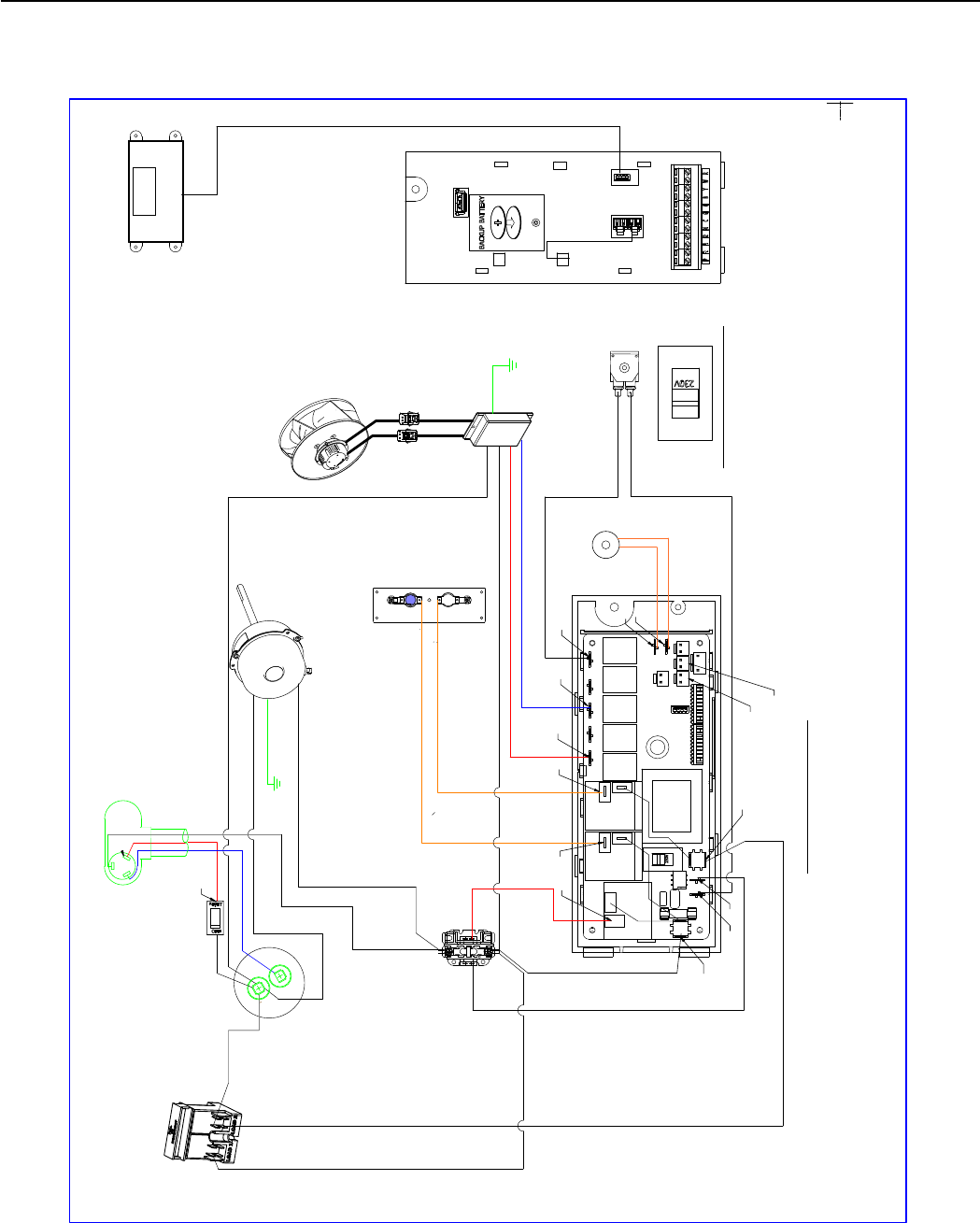
72 PB
WIRING DIAGRAMS
24K 208/230V (2.5KW, 3.5KW, 5KW)
Figure 807
COMPRESSOR
CONTACTOR
BLACK
ELECTRONIC CONTROL
WHITE
TO MOTOR
MOUNT
RED
BLACK
GREEN
RED
BLUE
C
HE
RM
CAPACITOR
QUICK DISCONNECT
COMPRESSOR
BLACK
WHITE
TO BLOWER
FRONT
BLUE
RED
OUTDOOR
FAN MOTOR
PRESSURE
SWITCH
GREEN
COIL SOLENOID
INDOOR
BLOWER
MOTOR
HEATER
2.5 KW - 5.0 KW
ORANGE
BLACK
BREAKER
BLACK
W
H
I
T
E
B
L
A
C
K
5
WHITE
CIRCUIT
W
H
I
T
E
C
S
R
" F"
BLACK
CONTROL
BLOWER
HARNESS COMPRESSOR
WHITE
ORANGE
VOLTAGE SELECTION SWITCH
SET VOLTAGE TO 230V
COMP
RELAY
HEAT
RELAY
HEAT
RELAY
FAN 1
RELAY
FAN 2
RELAY
FAN 3
RELAY
FAN 4
WIRING DIAGRAM
COOL, HEAT PUMP, EH, 230V
2.5, 3.4, 5.0 KW
LARGE CHASSIS
RV
RELAY
RELAY
*
*
*
*
*
*
*
*
*
*
*
SERVICE DISPLAY
AMBIENT
AIR
SENSOR
IND
*
OOR COIL SENSOR
OUTDOOR COIL SENSOR
*
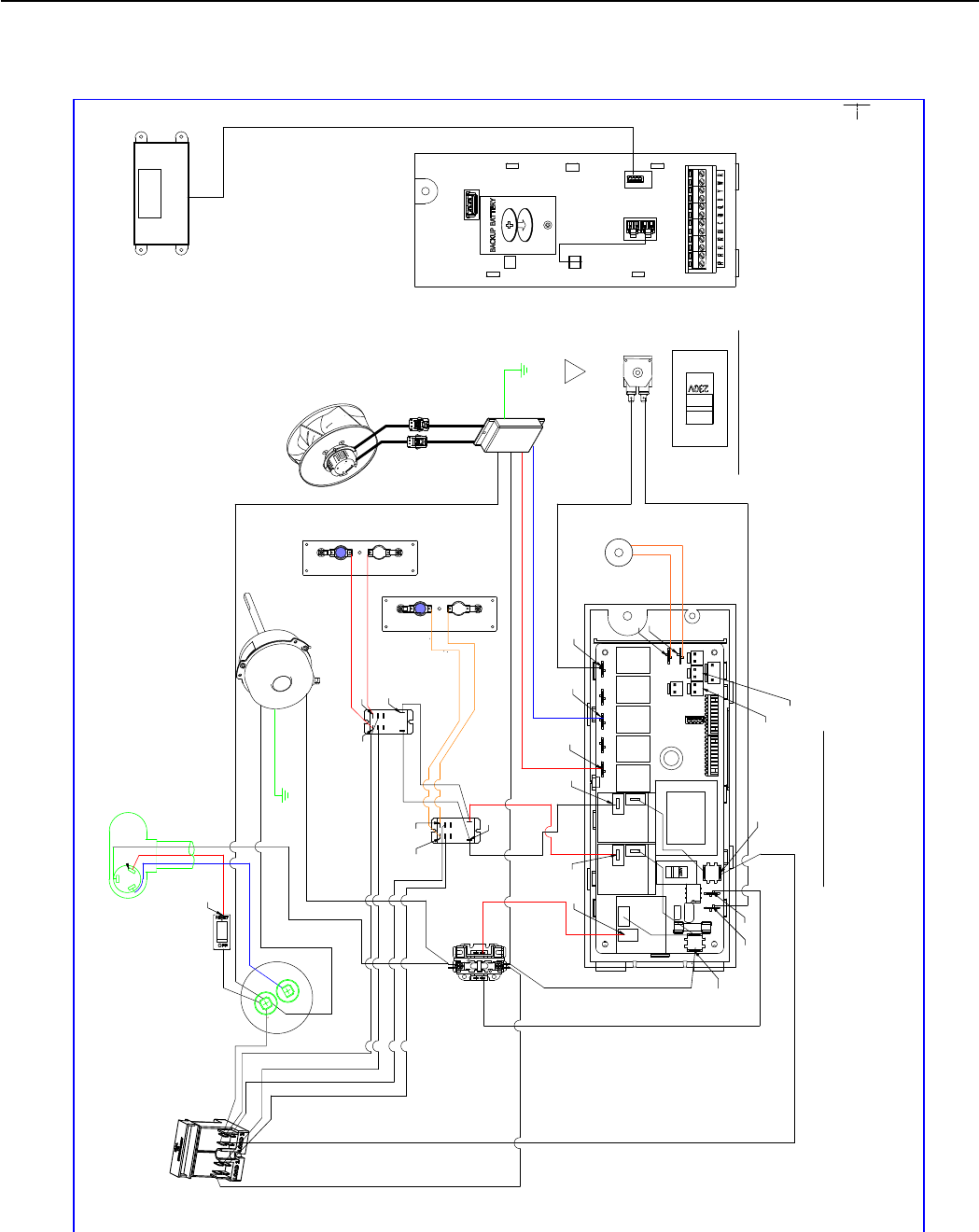
73 PB
WIRING DIAGRAMS
24K 208/230V (7.5KW AND 10KW)
Figure 808
COMPRESSOR
CONTACTOR
ELECTRONIC CONTROL
BLACK
WHITE
TO MOTOR
MOUNT
BLACK
BLACK
RED
GREEN
RED
RED
BLUE
H
E
A
T
E
R
R
E
L
A
Y
B
L
A
C
K
C
W
H
I
T
E
HE
RM
CAPACITOR
QUICK DISCONNECT
COMPRESSOR
BLACK
WHITE
TO BLOWER
FRONT
BLUE
RED
OUTDOOR
FAN MOTOR
PRESSURE
SWITCH
GREEN
COIL SOLENOID
INDOOR
BLOWER
MOTOR
HEATER
7.5 KW & 10.0 KW
ORANGE
BLACK
BREAKER
BLACK
W
H
I
T
E
B
L
A
C
K
WHITE
CIRCUIT
W
H
I
T
E
C
S
R
" F"
BLACK
RED
WHITE
HARNESS COMPRESSOR
BLACK
CONTROL
BLOWER
B
L
A
C
K
W
H
I
T
E
WHITE
ORANGE
RED
*
*
VOLTAGE SELECTION SWITCH
SET VOLTAGE TO 230V
COMP
RELAY
HEAT
RELAY
HEAT
RELAY
FAN 1
RELAY
FAN 2
RELAY
FAN 3
RELAY
FAN 4
WIRING DIAGRAM
COOL, HEAT PUMP, EH, 230V
7.5KW, 10.0 KW
LARGE CHASSIS
RV
RELAY
RELAY
*
*
*
*
*
*
*
*
*
*
*
SERVICE DISPLAY
AMBIENT
AIR
SENSOR
IND
*
OOR COIL SENSOR
*
OUTDOOR COIL SENSOR
*
*
*
01
Lorem ipsum
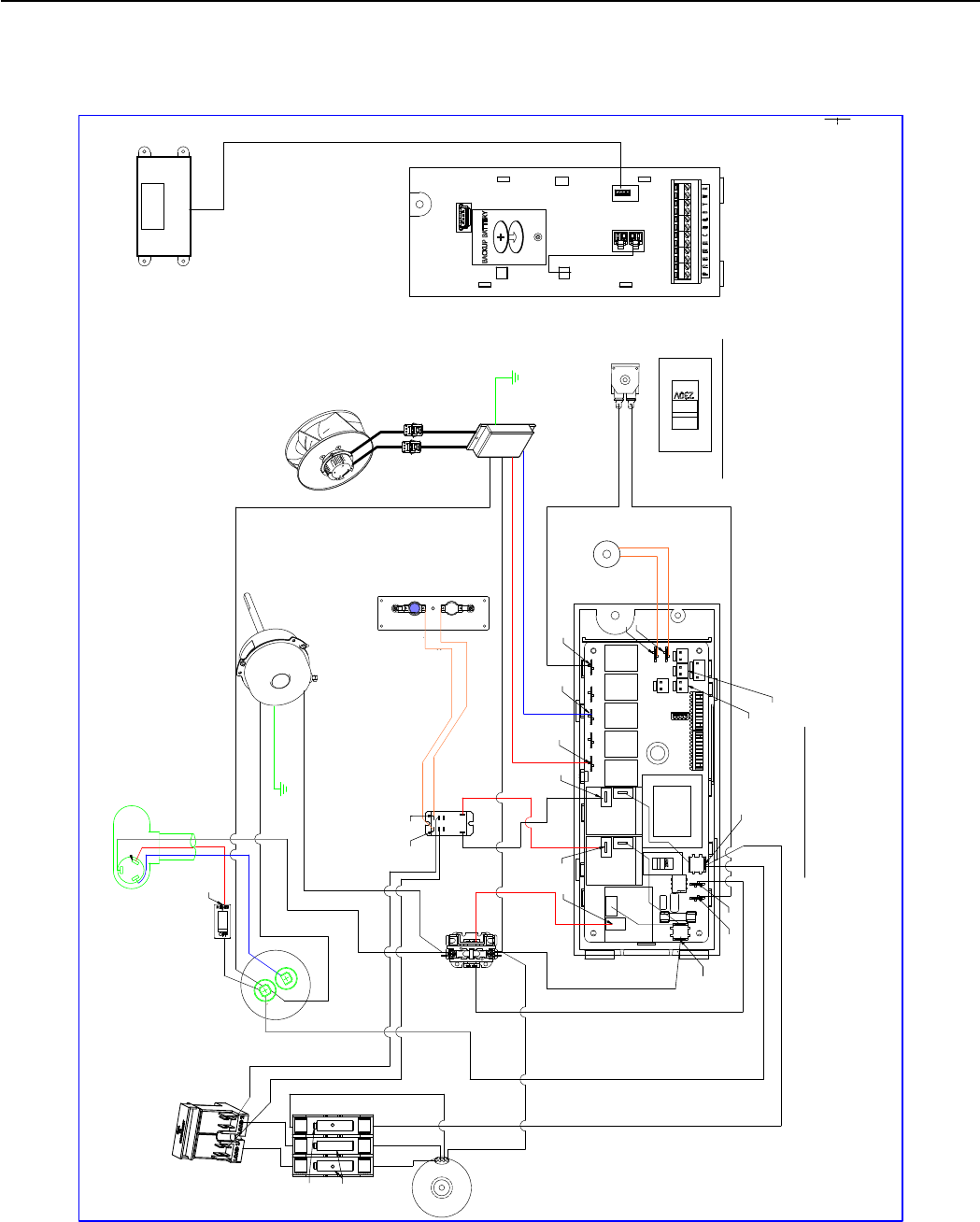
74 PB
WIRING DIAGRAMS
24K 265V (2.5KW, 3.5KW, 5KW)
Figure 807 (80126406)
COMPRESSOR
CONTACTOR
BLACK
ELECTRONIC CONTROL
WHITE
TO MOTOR
MOUNT
BLACK
BLACK
RED
GREEN
RED
RED
BLUE
B
L
A
C
K
W
H
I
T
E
HE
RM
C
BR O
W
N
CAPACITOR
QUICK DISCONNECT
COMPRESSOR
WHITE
ORANGE
BLACK
TO BLOWER
FRONT
BLUE
RED
OUTDOOR
FAN MOTOR
PRESSURE
SWITCH
GREEN
COIL SOLENOID
INDOOR
BLOWER
MOTOR
HEATER
2.5 KW & 5.0 KW
ORANGE
BLACK
BREAKER
BLACK
W
H
I
T
E
B
L
A
C
K
WHITE
CIRCUIT
WHITE
TRANSFORMER
IN= 265V
OUT= 230V
(RE OP 40 183)
W
HITE
C
S
R
" F"
R ED
W
HITE
FUSE
HOLDER
HARNESS COMPRESSOR
BLAC K
BLA
C K
5
BLACK
CONTROL
BLOWER
VOLTAGE SELECTION SWITCH
SET VOLTAGE TO 230V
FUSE
FUSE
*
*
COMP
RELAY
HEAT
RELAY
HEAT
RELAY
FAN 1
RELAY
FAN 2
RELAY
FAN 3
RELAY
FAN 4
WIRING DIAGRAM
COOL, HEAT PUMP, EH, 265V
2.5, 3.4, 5.0 KW
LARGE CHASSIS
RV
RELAY
RELAY
*
*
*
*
*
*
*
*
*
*
*
SERVICE DISPLAY
AMBIENT
AIR
SENSOR
REL OP 40
SEQ 103
IND
*
OOR COIL SENSOR
OUTDOOR COIL SENSOR
*

75 PB
WIRING DIAGRAMS
24K 265V (7.5KW and 10KW)
Figure 808 (80126404)
COMPRESSOR
CONTACTOR
ELECTRONIC CONTROL
BLACK
WHITE
TO MOTOR
MOUNT
BLACK
BLACK
RED
GREEN
RED
RED
BLUE
H
E
A
T
E
R
R
E
L
A
Y
B
L
A
C
K
W
H
I
T
E
HE
RM
C
BR O
W
N
CAPACITOR
QUICK DISCONNECT
COMPRESSOR
WHITE
ORANGE
BLACK
TO BLOWER
FRONT
BLUE
RED
OUTDOOR
FAN MOTOR
PRESSURE
SWITCH
GREEN
COIL SOLENOID
INDOOR
BLOWER
MOTOR
HEATER
7.5 KW & 10.0 KW
ORANGE
BLACK
BREAKER
BLACK
W
H
I
T
E
B
L
A
C
K
WHITE
CIRCUIT
WHITE
TRANSFORMER
IN= 265V
OUT= 230V
W
HITE
C
S
R
" F"
R ED
W
HITE
FUSE
HOLDER
HARNESS COMPRESSOR
BLAC K
BLA
C K
BLACK
RED
WHITE
BLACK
CONTROL
BLOWER
B
L
A
C
K
W
H
I
T
E
RED
VOLTAGE SELECTION SWITCH
SET VOLTAGE TO 230V
FUSE
FUSE
*
*
COMP
RELAY
HEAT
RELAY
HEAT
RELAY
FAN 1
RELAY
FAN 2
RELAY
FAN 3
RELAY
FAN 4
WIRING DIAGRAM
COOL, HEAT PUMP, EH, 265V
7.5 KW, 10.0 KW
LARGE CHASSIS
RV
RELAY
RELAY
*
*
*
*
*
*
*
*
*
*
*
SERVICE DISPLAY
AMBIENT
AIR
SENSOR
IND
*
OOR COIL SENSOR
*
OUTDOOR COIL SENSOR
*
*
*
01

76 PB
INTERACTIVE PARTS VIEWER
All Service Parts can be found on our online interactive parts viewer.
Please click on the link below:
Interactive Parts Viewer
For Further Assistence contact customer service at (1-800-541-6645).
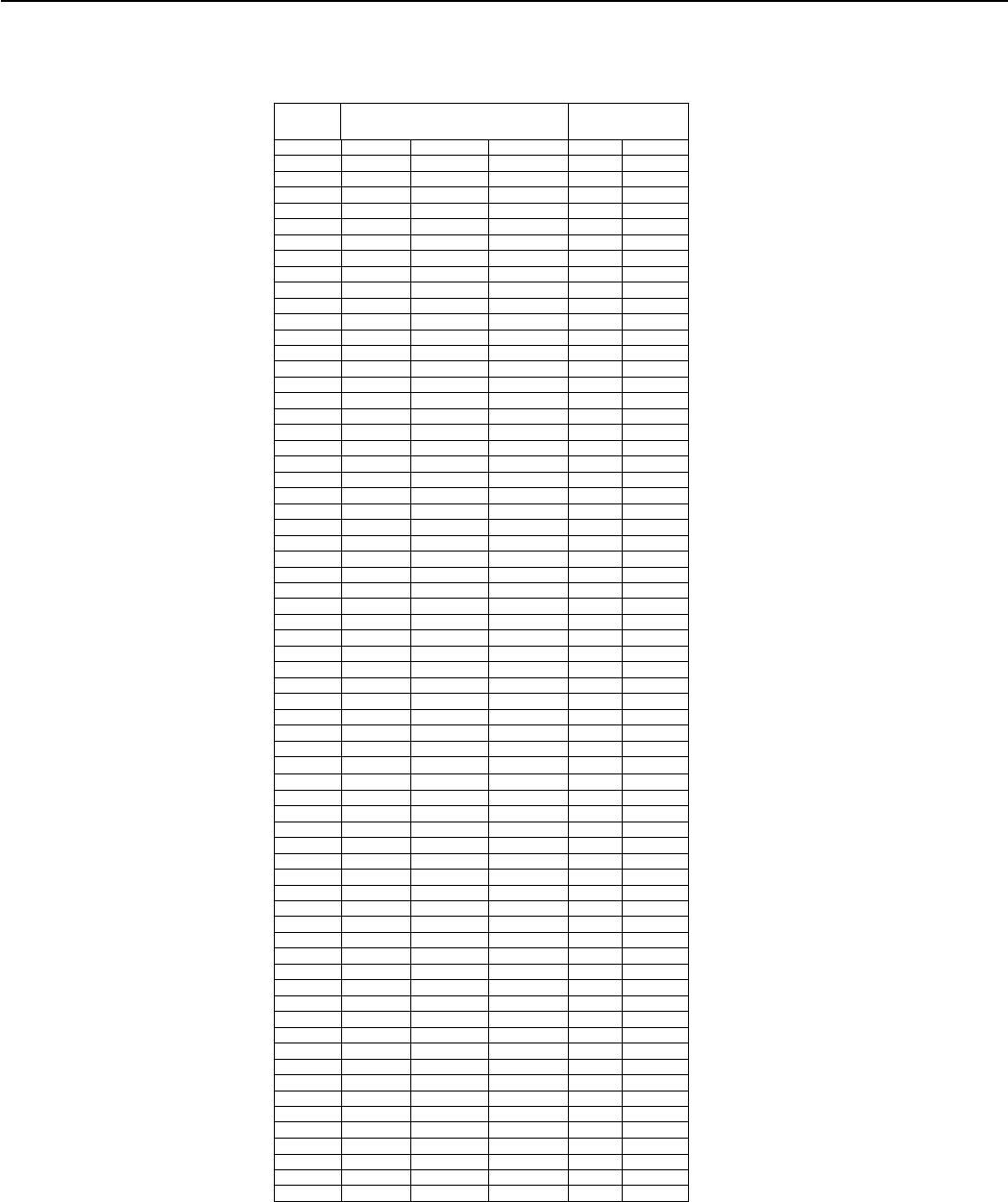
77 PB
APPENDIX
Appendix 1 Thermistor Resistence Values (This Table Applies to All Thermistors)
TEMP RESISTENCE (K Ohms)
RESISTANCE
TOLERANCE %
MAX F MINMIN MAXCENTR
-25 210.889 225.548 240.224 6.50 6.51
178.952
-20
190.889 202.825 6.25 6.25
-15 151.591 161.325 171.059 6.03 6.03
-10 128.434 144.292 5.81136.363 5.81
108.886-5 115.340 121.794 5.60 5.60
0 92.411 97.662 102.912 5.38 5.38
5 78.541 82.812 87.083 5.16 5.16
10 66.866 70.339 73.812 4.94 4.94
15 57.039 59.864 62.688 4.72 4.72
20 48.763 51.060 53.357 4.50 4.50
25 41.786 43.654 45.523 4.28 4.28
30 35.896 37.415 38.934 4.06 4.06
31 34.832 36.290 37.747 4.02 4.02
32 33.803 35.202 36.601 3.97 3.97
33 32.808 34.150 35.492 3.93 3.93
34 31.846 33.133 34.421 3.89 3.89
35 30.916 32.151 33.386 3.84 3.84
36 30.016 31.200 32.385 3.80 3.80
37 29.144 30.281 31.418 3.75 3.75
38 28.319 29.425 30.534 3.76 3.77
39 27.486 28.532 29.579 3.67 3.67
40 26.697 27.701 28.704 3.62 3.62
45 23.116 23.931 24.745 3.40 3.40
50 20.071 20.731 21.391 3.18 3.18
55 17.474 18.008 18.542 2.96 2.96
60 15.253 15.684 16.115 2.75 2.75
65 13.351 13.697 14.043 2.53 2.53
66 13.004 13.335 13.666 2.48 2.48
67 12.668 12.984 13.301 2.44 2.44
68 12.341 12.644 12.947 2.39 2.39
69 12.024 12.313 12.603 2.35 2.35
70 11.716 11.993 12.269 2.31 2.31
71 11.418 11.682 11.946 2.26 2.26
72 11.128 11.380 11.633 2.22 2.22
73 10.846 11.088 11.329 2.18 2.18
74 10.574 10.804 11.034 2.13 2.13
75 10.308 10.528 10.748 2.09 2.09
76 10.051 10.260 10.469 2.04 2.04
77 9.800 10.000 10.200 2.00 2.00
78 9.550 9.748 9.945 2.03 2.03
79 9.306 9.503 9.699 2.07 2.07
80 9.070 9.265 9.459 2.10 2.10
81 8.841 9.033 9.226 2.13 2.13
82 8.618 8.809 9.000 2.17 2.17
83 8.402 8.591 8.780 2.20 2.20
84 8.192 8.379 8.566 2.23 2.23
85 7.987 8.172 8.358 2.27 2.27
86 7.789 7.972 8.155 2.30 2.30
87 7.596 7.778 7.959 2.33 2.33
88 7.409 7.589 7.768 2.37 2.37
89 7.227 7.405 7.583 2.40 2.40
90 7.050 7.226 7.402 2.43 2.43
91 6.878 7.052 7.226 2.47 2.47
92 6.711 6.883 7.055 2.50 2.50
93 6.548 6.889 6.718 2.53 2.53
94 6.558 6.390 6.727 2.57 2.57
95 6.237 6.403 6.569 2.60 2.60
96 6.087 6.252 6.417 2.63 2.63
97 5.942 6.105 6.268 2.67 2.67
98 5.800 5.961 6.122 2.70 2.70
99 5.663 5.822 5.981 2.73 2.73
100 5.529 5.686 5.844 2.77 2.77
105 4.912 5.060 5.208 2.93 2.93
110 4.371 4.511 4.651 3.10 3.10
3.898 115 4.030 4.161 3.27 3.27
120 3.482 3.730 3.606 3.43 3.43
Figure 710 Thermistor Values

78 PB
Friedrich Air Conditioning Co.
10001 Reunion Place, Suite 500 • San Antonio, Texas 78216
1-800-541-6645
www.friedrich.com
TECHNICAL SUPPORT
CONTACT INFORMATION
CUSTOMER SATISFACTION and QUALITY ASSURANCE
Friedrich is a conscientious manufacturer, concerned about customer satisfaction, product quality, and controlling
warranty costs. As an Authorized Service Provider you play a vital role in these areas. By adhering to the policies
and procedures you provide us with vital information on each warranty repair you complete. This information
is used to identify product failure trends, initiate corrective action, and improve product quality, thereby further
reducing warranty expenses while increasing customer satisfaction levels.
Due to continuing research in new energy-saving technology, specications are subject to change without notice.
FRIEDRICH AUTHORIZED PARTS DEPOTS
NEUCO Inc.
515 W Crossroads Parkway
Bolingbrook, IL 60440
312.809.1418
United Products Distributors Inc.
4030A Benson Ave
Halethorpe, MD 21227
888-907-9675
Shivani Regeration & Air
Conditioning Inc.
2259 Westchester Ave.
Bronx, NY 10462
The Gabbert Company
6868 Ardmore
Houston, Texas 77054
713-747-4110
800-458-4110
Johnstone Supply of Woodside
27-01 Brooklyn Queens Expway
Woodside, New York 11377
718-545-5464
800-431-1143
Reeve Air Conditioning, Inc.
2501 South Park Road
Hallandale, Florida 33009
954-962-0252
800-962-3383
Total Home Supply
26 Chapin Rd Ste 1109
Pine Brook, NJ 07058
877-847-0050
https://www.totalhomesupply.com/
brands/Friedrich.html
